Your browser is not supported for this experience. We recommend using Chrome, Firefox, Edge, or Safari.

Find Your Favorite Beach

Atlantic Coast

Beach Camping

Family-Friendly
Places to stay.

Campgrounds

Travel Ideas

Accessible Travel

Eco-Friendly Travel

African American Heritage Travel
More Travel Ideas
Popular links.

Florida Webcams

Toll Roads Info

Travel Guides
American ghost adventures: not just a stroll in the dark.
The difference between a tour with American Ghost Adventures and a tour through a typical haunted house is the difference between a witch and witch hazel.
A typical haunted house features spider webs, ghouls jumping out at you, and Halloween props in every corner. Screams, evil laughter, and creaking sounds often accompany your steps.
A tour with American Ghost Adventures doesn’t feature any of those things because, as the company emphatically states, they’re dealing with real spirits who are loath to appear on command.
Sometimes folks see shadow people, sometimes things move, and sometimes the situation gets strange in other ways -- but each experience in each location is always different.
One of the spine-tingling offerings is a tour of historic downtown Orlando, a hotbed of paranormal activity. It includes exploring one of several haunted buildings, where you’ll be given an electromagnetic field detector.
You can opt for a Downtown Tour, a Pub Tour, or an Investigation, in locations that include Daytona Beach, Orlando, Winter Garden, Mount Dora and Sanford.
Depending on the tour location, prices can range from $15 to $50. Generally, Downtown Tours are two hours, Pub Tours are three hours, and Investigations last about four hours.
If you’re looking for a seriously spooky adventure, it doesn’t get any better. The company founder has been doing tours for almost a decade in Central Florida, and TripAdvisor ranks it in the top 10 for ‘things to do in Orlando’ and has awarded it the Certificate of Excellence.
Remember to bring your recording devices. You never know what your camera might catch!

RELATED CONTENT

Ghost Tours of Abandoned Towns in Florida
- 5 minute read
Florida may be all palms and sunshine, but the state has a spooky past too. Throughout the peninsula, you’ll find eerie tales that give you a...

5 Amazing Experiences Close to Orlando
By Lauren Tjaden Within an hour of the City Beautiful, you’ll find not only some of the world’s most luscious beaches, but some must-do...
STRATEGIC ALLIANCE PARTNERS
Westgate Resorts
10 most haunted places in florida to spook your summer vacation.
Sep 24, 2022

By Rich Weidman
“We ask only to be reassured/About the noises in the cellar/And the windows that should not have been opened.” – T. S. Eliot
Let's admit it. Florida is chock full of activities and attractions. I mean, the number of things to do in Orlando alone boggles the mind, right? But what if your path diverges a little towards the spooky side? Are you looking for a good dose of haunted Florida to spice up your upcoming getaway? Good news! Thrill seekers don’t have to travel all the way to notorious haunted hotspots such as the LaLaurie Mansion in New Orleans, Eastern State Penitentiary in Philadelphia, Trans-Allegheny Lunatic Asylum in West Virginia, Pine Barrens in New Jersey (home of the legendary “Jersey Devil” as well as the locale for a memorable episode of The Sopranos) or The Stanley Hotel in Colorado (inspiration for Stephen King’s The Shining) to get spooked this Halloween season. Florida offers its own blood-curdling thrills in the form of a myriad of haunted cemeteries, lighthouses, bridges, forts, theaters, schools and hotels, as well as haunted campgrounds and forests (most notably Ocala National Forest). Here are the 10 most haunted places in Florida to spook your summer vacation:
View this post on Instagram A post shared by Westgate River Ranch (@westgateranch)
1 | The Haunting of River Ranch - Polk County | Get into the spooky season with brand-new experiences coming to Westgate River Ranch Resort & Rodeo . Our haunted ranch is getting a makeover to reflect the season. If you dare to venture to our authentic dude ranch, located in Polk County, you'll experience a haunted hayride that might just chill you to the bone as you bump along a spooky path, a winding corn maze that will confuse and delight you, plus a pumpkin patch to choose your very own gourd and take those coveted social media pictures. It's a fun and spooky event for Halloweenies of all ages! There's something for everyone to enjoy fall in Florida. And remember, not all trails are happy, so don't come alone. Why would you want to?
WHERE: 3200 River Ranch Blvd, River Ranch, FL 33867 | WHO: 863-692-1321
VIEW ON GOOGLE MAPS
RELATED ARTICLES:
10 Spooky Things to Do for Halloween at a Westgate Near You!
The 6 Scariest Florida Corn Mazes To Get Lost In This Halloween!
6 Ways to Survive Halloween Horror Nights Wait Times in Orlando [2022]
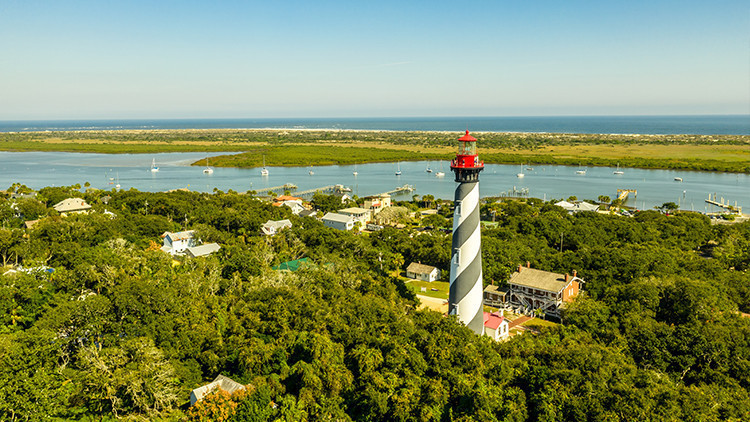
2 | St. Augustine Lighthouse – St. Augustine | Founded in 1565 and considered the oldest city in the United States, St. Augustine has also earned a reputation as the most haunted city in Florida. One of the most legendary haunted sites in St. Augustine happens to be the 165-foot-tall St. Augustine Lighthouse, which was constructed in 1874 and features 219 spiral steps to the top. Some visitors to the haunted lighthouse have reported hearing children’s laughter and footsteps (two teenaged children of a lighthouse worker reportedly drowned in the adjacent bay in the late 1800s), while others have heard mysterious voices, smelled cigar smoke, viewed a shadowy figure at the top of the lighthouse and/or run into the so-called “Man in Blue” in the basement of the former lighthouse keeper’s house. The St. Augustine Lighthouse even made several appearances on the now-defunct paranormal reality TV series Ghost Hunters. In addition, Country Living magazine listed the St. Augustine Lighthouse among “25 of the Most Haunted Places in America That Horror Fans Need to Visit.” Other alleged haunted sites in St. Augustine include Castillo de San Marcos, Old Jail, Spanish Military Hospital, Casa Monica Hotel, Flagler College, Oldest Wooden Schoolhouse, Huguenot Cemetery, Casablanca Inn and Harry’s Seafood Bar & Grille, among others.
WHERE: 81 Lighthouse Avenue, St. Augustine, Florida 32080 | WHO: (904) 829-0745
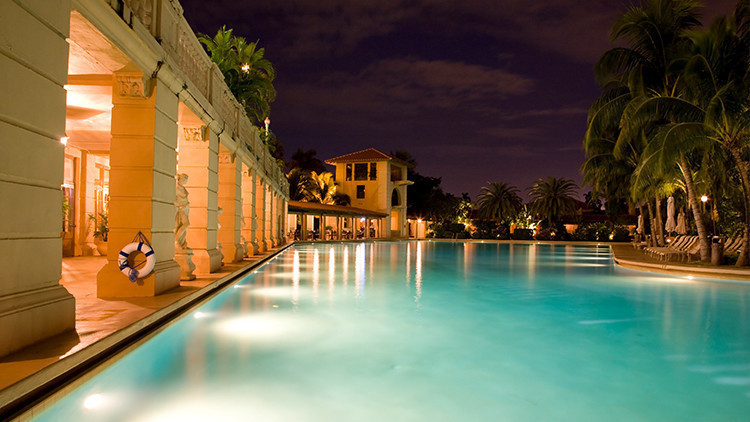
3 | Biltmore Hotel – Coral Gables | A massive luxury hotel that first opened its doors in 1926, the Biltmore Hotel in Coral Gables later served as a military hospital during World War II, a VA hospital after the war and even the campus of the University of Miami medical school before reverting back to a luxury hotel in 1987. Guests of the Biltmore during the early years included everyone from President Franklin Delano Roosevelt to gangster Al “Scarface” Capone (in addition, Johnny “Tarzan” Weissmuller served as a swim instructor here before achieving fame). The Biltmore was also a favorite among Jazz Age revelers. Designated a National Historic Landmark in 1996, the Biltmore is considered one of the most haunted hotels in Florida. One of the ghosts reportedly haunting the Biltmore is none other than notorious gangster Thomas “Fatty” Walsh, who was murdered on the 13th floor of the Biltmore over a gambling dispute in 1929. Guests have experienced such phenomena as lights switching on and off, elevators taking them to the wrong floors, inexplicable sounds and cryptic messages discovered scrawled on mirrors. Other alleged haunted sites in the Miami area include the Deering Estate, Coral Castle, Miami City Cemetery, Coconut Grove Playhouse, Anderson’s General Store, Villa Paula Mansion and Pinewood Cemetery, among others.
WHERE: 1200 Anastasia Avenue, Coral Cables, Florida 33134 | WHO: (855) 454-0196
View this post on Instagram on Jan 30, 2019 at 7:18pm PST
4 | The Devil’s Chair, Lake Helen-Cassadaga Cemetery – Cassadaga | Nestled just off Interstate 4 between DeLand and Deltona, the charming community of Cassadaga is known for its haunted history – especially the so-called “Devil’s Chair,” an allegedly haunted Florida landmark at Lake Helen-Cassadaga Cemetery. According to legend, if you sit in the huge brick chair at midnight, the Devil himself will make an appearance (and if you leave a can of beer on the Devil’s Chair, it will reportedly be empty the next morning!). A much less interesting (but significantly more plausible) story about the origins of the Devil’s Chair is that it was simply constructed as a “mourning chair” so visitors to the cemetery could sit and pay respects to their dearly departed loved ones. Listed on the National Register of Historic Places and widely considered “The Psychic Center of the World,” Cassadaga was founded as a spiritualist community by George Colby in 1875. Other alleged haunted sites in Cassadaga include the landmark Cassadaga Hotel, which was constructed in 1928 and houses Sinatra’s Ristorante and a Psychic Center.
WHERE: Kicklighter Road & Root Street, Lake Helen, Florida 32744 | WHO: N/A
View this post on Instagram on Feb 8, 2019 at 10:57am PST
5 | Robert the Haunted Doll, Fort East Martello Museum – Key West | Built during the Civil War and listed on the National Register of Historic Places, Fort East Martello in Key West is also home to Robert the Haunted Doll, one of the creepiest dolls in existence. The allegedly haunted doll once belonged to eccentric Key West artist Robert Eugene Otto (1900-1974), who used to blame the doll (which was reportedly given to him by a Bahamian servant girl) for all kinds of mischief. Visitors to the museum have reported not only seeing Robert the Doll move and change facial expressions, but also make giggling noises (don’t even think of taking a photo of Robert without asking his permission or you will experience bad luck, according to legend). In addition to Robert the Doll, Fort East Martello boasts such eclectic artifacts as the scrap metal junk sculptures of Stanley Papio and the Key West folk art of Mario Sanchez. By the way, the former home of Robert Otto now operates as a bed & breakfast called The Artist House (which is also believed to be haunted!). Other alleged haunted sites in Key West include the Key West Cemetery, Captain Tony’s Saloon, La Concha Hotel and Fort Zachary Taylor.
WHERE: 3501 South Roosevelt Boulevard, Key West, Florida 33040 | WHO: (305) 296-3913
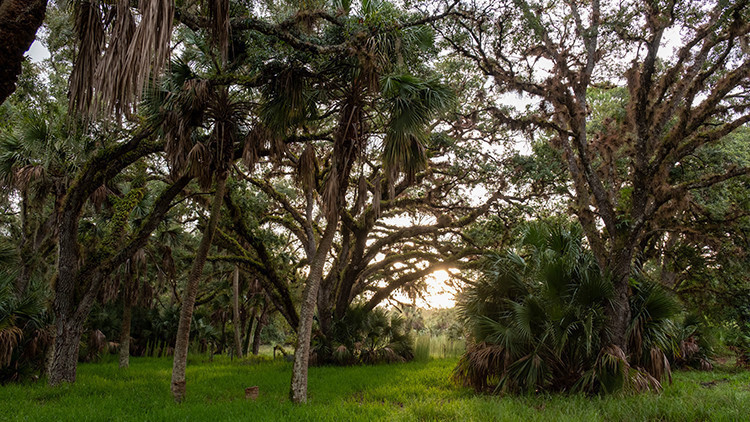
6 | The Devil’s Tree, Oak Hammock Park – Port St. Lucie | A large and mysterious oak tree lies down a dirt nature trail in the corner of Oak Hammock Park in Port St. Lucie. Known as “The Devil’s Tree,” it was the site of a series of gruesome murders in the early 1970s and today believed to be possessed by evil spirits. According to legend, several failed attempts have been made to cut down the tree over the years and some visitors to the park at night have reported seeing figures in dark hooded capes performing satanic rituals near the tree (the park closes at dusk, by the way). A local priest even allegedly attempted to perform an exorcism here back in the early 1990s. Other park visitors claim to have viewed ghosts hanging from the branches of The Devil’s Tree. In addition to its infamous oak tree, Oak Hammock Park, which was established in 2000, features a boat and canoe launch, two fishing piers, three miles of hiking trails, pavilion, butterfly garden and playground.
WHERE: Oak Hammock Park, 1982 S.W. Villanova Road, Port St. Lucie, Florida 34953 | WHO: (772) 344-4389

By maiabee / Licensed under CC BY 2.0
7 | Greenwood Cemetery – Orlando | Originally known as Orlando Cemetery and opened in 1880, Greenwood Cemetery encompasses 86 acres and is well known for its haunted history. Visitors to the cemetery have reported seeing ghostly children playing and laughing among the tombstones, as well as the ghosts of Confederate soldiers roaming aimlessly among the huge live oak trees. Moonlight walking tours of Greenwood Cemetery are available. Don’t miss the chance to view the creepy Fred Weeks mausoleum (the ghost of Weeks himself is said to occasionally wander through the cemetery at night). By the way, Thomas Jefferson’s grandson, Francis Wayles Eppes (1801-1881), is buried in Greenwood Cemetery. Other alleged haunted sites in the Orlando area include Lake Lucerne (home to the “Lady in White”), Orange County Regional History Center, Hamburger Mary’s, Rogers Building, Lake Eola (home to the “Ghost Dog”), Harry P. Leu Gardens and the infamous Interstate 4 “Dead Zone.”
WHERE: 1603 Greenwood Street, Orlando, Florida 32801 | WHO: (407) 246-2616
View this post on Instagram on Jul 31, 2018 at 10:56am PDT
8 | The Devil’s School – Jacksonville | Widely considered the “most haunted place in Jacksonville,” the so-called “Devil’s School” near I-95 and I-10 in Jacksonville has been the source of numerous outrageous urban legends over the years such as a crazed janitor who burned students alive in the boiler room and even a cannibalistic school principal! First opened in 1918 as Riverside Grammar School (AKA Public School No. 4), which later became Annie Lytle Elementary School, the school closed in 1960 and the abandoned building was left to decay. In addition to being defaced by graffiti artists and vandals, the building was also allegedly used for satanic rituals. Designated a historic landmark by the Jacksonville City Council in 2000, the allegedly haunted school building is strictly off limits to visitors and fenced in with “Keep Out” signs, although curious sightseers can view the outside of the Devil’s School simply by driving by it on Chelsea Street. Other alleged haunted sites in Jacksonville include Florida Theatre, Evergreen Cemetery, Jacksonville Beach Lifeguard Station, Ginger’s Place and Casa Marina Hotel (reportedly haunted by silent film star Fatty Arbuckle).
WHERE: 699 Chelsea Street, Jacksonville, Florida 32204 | WHO: N/A
View this post on Instagram A post shared by Bilheimer Capitol Theatre (@bilheimercap)
9 | Capitol Theatre - Clearwater | A historic theater that first opened in 1921 with the silent film Dinty (a precursor of the popular “Our Gang” series), the Capitol Theatre (AKA Royalty Theatre) is not only one of the oldest operating theaters in the Sunshine State, but also allegedly one of the most haunted. In fact, the Capitol Theatre is reportedly the home of three spirits: an old sea captain, a former theater manager named Bill (who was reportedly murdered in the balcony) and a young girl known to play tricks on visitors. In 2013, the 750-seat Capitol Theatre underwent an $11 million renovation and is managed by Ruth Eckerd Hall. Other alleged haunted sites in Clearwater include Sylvan Abbey Memorial Park, home of the infamous “Ghost Shack.”
WHERE: 405 Cleveland Street, Clearwater, Florida 33755 | WHO: (727) 791-7400
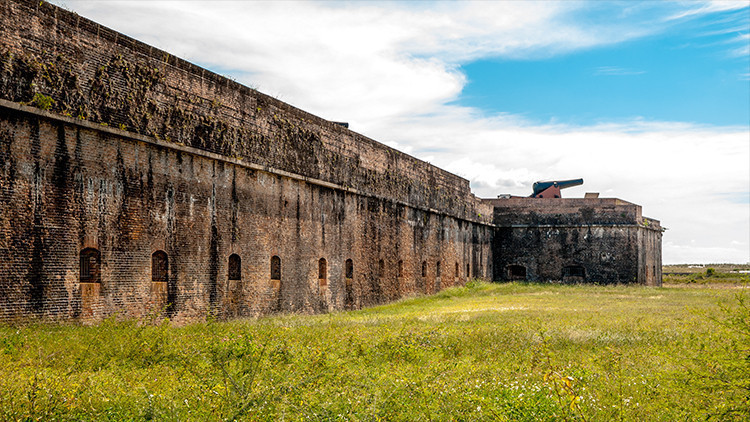
10 | Fort Pickens – Gulf Islands National Seashore | Named after American Revolutionary War hero Andrew Pickens (1739-1817), Fort Pickens is located on Pensacola Beach at Gulf Islands National Seashore. Designed by French engineer Simon Bernard and completed in 1834 with a total of 21.5 million bricks, Fort Pickens was later used as a prison for legendary Apache Chief Geronimo (1829-1909) and his confederates (whose arrival here created somewhat of a sideshow spectacle among the local citizenry). Visitors have reported spotting mysterious lights, hearing footsteps and viewing the ghosts of soldiers, as well as the spirit of Geronimo wandering around Fort Pickens. Other alleged haunted sites in Pensacola include Saenger Theatre, The Gray House, Seville Quarter, St. John’s Cemetery and Pensacola Lighthouse (considered one of the most haunted lighthouses in the United States).
WHERE: 1801 Gulf Breeze Parkway, Gulf Breeze, Florida 32563 | WHO: (850) 934-2600
View this post on Instagram on May 21, 2019 at 2:14pm PDT
BONUS #1 | The Cuban Club – Tampa | Listed among the Travel Channel’s “Top 10 Most Haunted Places,” the Cuban Club (AKA Circulo Cubano de Tampa) lies within Tampa’s bustling Ybor City neighborhood. Built in 1917, the Cuban Club evolved into an immensely popular hangout for Cuban immigrants. Listed on the National Register of Historic Places, the Cuban Club is allegedly haunted by several ghostly spirits, including an actor who reportedly committed suicide on stage, a theater board member murdered during an argument, an elegant lady in a “misty dress” and a young boy playing ball on the theater steps. The Cuban Club is one of several stops on the Ybor City Ghost Tour. Other alleged haunted sites in the Tampa/St. Petersburg area include Florida Brewery Company, Tampa Theatre (home of the ghost of former projectionist Foster “Fink” Finley), Don CeSar Hotel (aka “The Pink Palace”), University of South Florida Library, Fort De Soto Campground and Plant Hall at the University of Tampa (formerly the Tampa Bay Hotel). And while some of these might not hold a candle to Orlando's haunted hay rides , they're still filled with spooks a'plenty!
WHERE: 2010 North Avenida Republica de Cuba, Tampa, Florida 33605 | WHO: (813) 248-2954
View this post on Instagram on Aug 7, 2015 at 9:38am PDT
BONUS #2 | Bellamy Bridge – Marianna | An 0.5-mile trail located just off State Road 162 and west of the Chipola River near Marianna leads to haunted Bellamy Bridge, which is known as “Florida’s Most Haunted Bridge.” Built in 1914, the steel-frame bridge is the oldest of its kind in Florida and the site of multiple ghostly occurrences over the years. Some hikers along the Bellamy Bridge Heritage Trail claim to have witnessed the ghost of a woman haunting the bridge. The ghost is allegedly that of Elizabeth Jane Bellamy, who died on her wedding day after her dress caught fire in the 1830s, according to legend (others claim that she less dramatically succumbed to an illness). Elizabeth’s husband Dr. Samuel Bellamy reportedly committed suicide several years later by slitting his throat with a razor. Other alleged haunted sites near Marianna include Arrowhead Campground, Tate’s Hell State Forest and the entire town of Monticello, which is known as the “Most Haunted Town in the South.”
WHERE: 4057 Bellamy Bridge Heritage Trail, Marianna, Florida 32446 | WHO: (850) 482-8061
View this post on Instagram A post shared by Ashleys of Rockledge (@ashleys.of.rockledge)
BONUS #3 | Ashley’s – Rockledge | Originally known as Jack’s Tavern, Ashley’s in Rockledge may very well be Florida’s most haunted restaurant (or at least the “Most Haunted Restaurant on the Space Coast”). The Tudor-style restaurant and bar first opened in 1934 and the following year a young woman named Ethel Allen, a tavern regular, was murdered nearby on the shores of the Indian River. Ghostly occurrences that have been reported at Ashley’s include objects moving on their own, lights going on and off, glasses and dishes breaking mysteriously, burglar alarms setting off randomly, diners being shoved by an unseen force, voices whispering after hours and the appearance of a woman in 1930’s-period clothing (could it be Ethel?) glaring back at them in the restroom mirror. Over the years, the restaurant has been known variously as Cooney’s Tavern, the Mad Duchess, the Loose Caboose, Sparrow Hawk and Gentleman Jim’s before becoming Ashley’s Restaurant in 1985.
WHERE: 1609 U.S. 1, Rockledge, Florida 32955 | WHO: (321) 636-6430
View this post on Instagram on Apr 16, 2019 at 1:54pm PDT
BONUS #4 | Witch’s Grave, Old City Cemetery – Tallahassee | The Old City Cemetery, Tallahassee’s oldest public cemetery, which was established in 1840, serves as the final resting place of Elizabeth “Bessie” Budd-Graham (1866-1889), known to locals affectionately as the “White Witch.” The mysterious and elaborate gravestone (which faces west unlike all of the other markers in the cemetery) features an excerpt from Edgar Allan Poe’s classic 1843 poem “Lenore,” a haunting ode to a dearly departed young love (Bessie was just 23 years old when she died): “Ah, broken is the golden bowl! The spirit flown forever! Let the bell toll! – A saintly soul floats on the Stygian river – Come! let the burial rite be read – the funeral song be sung! – An anthem for the queenliest dead that died so young – A dirge for her, the doubly dead in that she died so young.” According to the Tallahassee Democrat, “Goth rockers, clairvoyants and the curious alike are drawn to the Witch’s Grave in Tallahassee’s exquisitely spooky Old City Cemetery, which neighbor’s sorority row on the Florida State campus.”
WHERE: 400 West Park Avenue, Tallahassee, Florida 32301 | WHO: (850) 891-8711
FREE PRINTABLE HALLOWEEN COLORING BOOK
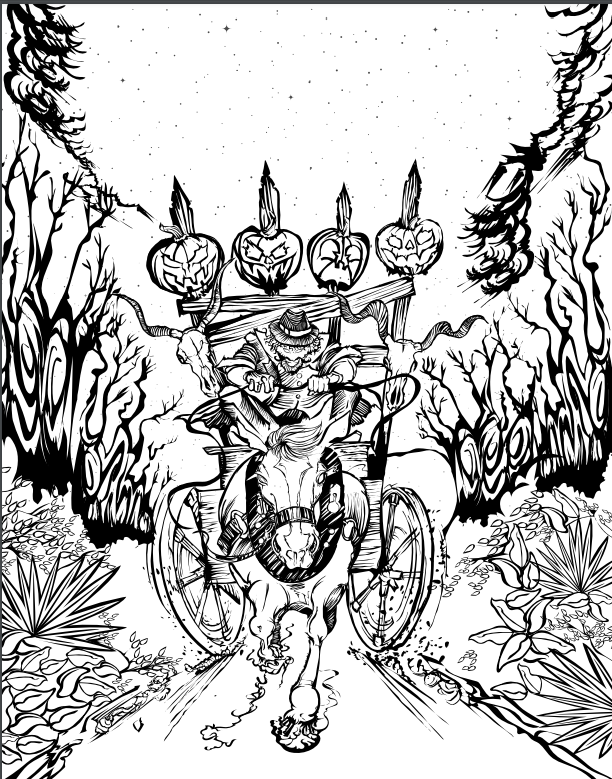
DOWNLOAD AND PRINT
Final Thoughts On Frightful Fun In Florida!
It's true, some of these places can get a bit spooky, and there's no telling where you'll wind up for the evening after a long day's journey (and perhaps a few close encounters of the ghoulish kind in one of the haunted houses in Orlando )! And whether you're just in the state for an extended getaway, or making a Florida day trip to get the lead out, you're going to want to flop for the night somewhere after getting all the ghostbusting in you can handle! Luckily, we've got all the best info and resources on HHN wait times for Halloween Horror Nights 2019 and summer vacation ideas for 2019 you can possibly handle! Or, maybe you're a Florida native looking for a sweet staycation ? Check out some of these great picks for Orlando hotels , learn more about fun agritourism Florida has to offer, keep the spirit of Halloween going by exploring these haunted Halloween corn mazes in Florida , grab some cheap Disney tickets , before trick or treating for the evening or make the fun last longer on International Drive ! Whatever your taste for the spooktacular - we've got you covered with an amazing collection of themed resorts , and tons of things to do in Florida, as well as FREE things to do in Orlando , right here on our travel blog !
At Westgate Resorts , when you Check-In, there’s a LOT to Check-Out! Your Florida vacation awaits! Explore our Florida resorts today or talk with a vacation planner at 888-852-2959 or 407-355-2690 .
RELATED ARTICLE:

Other tagged pages of interest: orlando hotels near disney , resorts near universal studios orlando , lake buena vista resort , kissimmee resorts , kissimmee hotels , hotels orlando , orlando resorts , resort hotels , staycations
When You Check-in, There's a Lot to Check Out
Sign up for our newsletter and check-in to great offers, secret stuff, and special events.
Thank You for Signing Up!
Exciting things are headed your way soon!
This website uses cookies to improve your digital experience. By continuing your browsing, you agree to the use of cookies. To learn more, please view our privacy policy .

- Home /
- Blog /
- Florida /
10 Most Insanely Haunted Places To Visit In Florida
Whether you’re a long time Florida resident in need of something fun to do this upcoming weekend, or you’re a guest and want to see all the state has to offer, look no further than the ten places that make up this list.
Not only do these various theaters, hotels, and attractions offer up many fun things to do …these ten places are considered the most haunted places to visit in Florida.

Josh/flickr and frightkingdom.com
Updated 2/10/2020 – So, get your EVP recorders and spirit boxes ready, and see how many of these places you can cross off your list – and still make it back alive.
Table of Contents
- 1 10) Tampa Theatre – Tampa, FL
- 2 9) Evergreen Cemetery – Jacksonville, FL
- 3 8) Super 8 – Orlando, FL
- 4 7) Casablanca Inn On The Bay – St. Augustine, FL
- 5 6) The Plaza Resort and Spa – Daytona Beach, FL
- 6 5) Fort East Martello Museum – Key West, FL
- 7 4) Stranahan House Museum – Fort Lauderdale, FL
- 8 3) Fort Desoto State Park – St. Petersburg, FL
- 9 2) Seven Sisters Inn – Ocala, FL
- 10 1) The Biltmore Hotel – Miami, FL
10) Tampa Theatre – Tampa, FL

tampaboi2000/flickr
If you’re looking for things to do in Florida at night, consider the Tampa Theatre.
Built in 1926, the architect and developers spared no expense with this lavish theater.
The interior is reminiscent of the Mediterranean.
Enjoy an upcoming classic play under the painted night sky of the theater’s ceiling.
Or, attend a Halloween-oriented event, such as listening to ghost stories or witnessing a paranormal investigation .
Tampa Theatre embraces the macabre, as the theater itself is haunted.
During the 1940s a projectionist passed away within the booth.
Today, his spirit continues to roam throughout the building.
Recently, a tourist reported seeing a large, shadowy man in the women’s bathroom.
When she went to ask him to leave, the man grabbed her by the neck and shook her.
- Related: How to See Ghosts for Real in 7 Simple Steps – Fast Results!
9) Evergreen Cemetery – Jacksonville, FL

pokesaladangie/flickr
Bank account looking a little bleak?
Well, there are plenty of free things to do in Florida this weekend, including visiting a cemetery!
The Evergreen Cemetery was established in 1880.
The park itself is 167 acres, and despite the fact that over 80,000 people are buried there, Evergreen has plenty more space.
For now, said space is used for seasonal, community events, such as the upcoming Pumpkin Run, or the Tales of our City tour, in which famous and historical events are reenacted for your family and friends.
No matter what event you attend at the Evergreen, just mind your step…
Some folks say that an English paranormal investigator accidentally woke a spirit up a few years ago.
The spirit is known to inhabit the closest dead body, and rise up from the ground.
Many believe it is demonic in nature, as it once possessed a young girl visiting Jacksonville .
The little girl began to speak English backwards, and blood ebbed from her eyes continuously until her parents found a priest to bless her.
8) Super 8 – Orlando, FL

hotels-for-everyone.com
There is so much stuff to do in Florida, it may feel a bit overwhelming.
Of course, if you have kids you may be visiting Disney World, Orlando Studios, or perhaps SeaWorld.
Big name attractions are all conveniently located near this Super 8, making your commute to and from each day a breeze.
Horrified by parking prices at the big name attractions? Fret not.
Super 8 offers a complimentary shuttle to all of its guests.
The moderately priced hotel also offers free continental breakfast, a large outdoor swimming pool and free HBO.
If you ever see people walking around with strange equipment, don’t be alarmed…chances are, they are paranormal investigators checking out the haunting in Room 206.
A handful of guests have reported waking up in the middle of the night to see someone stealing the blankets—only they were alone in the bed…. or supposed to be.
7) Casablanca Inn On The Bay – St. Augustine, FL

john hagstrom/flickr
For some tourists and Florida residents, nothing beats a day (or five) spent in St. Augustine .
For those who wish to stay in the area for their vacation, you’ll want to check into the Casablanca Inn.
Built in 1914, the building has been carefully restored to keep its ancient, Mediterranean charm all the while bringing the most modern of amenities to its guests.
Spend the day exploring the many museums, shops and eateries within the city, then return to a relaxing and pampered night at Casablanca.
Enjoy a nightly credit at the hotel bar, or enjoy the whirlpools as you gaze out over Matanzas Bay.
Looking for a spooky getaway for Halloween?
According to local legend, a young mother once checked herself into the hotel with her baby.
Horribly depressed, the woman drowned her baby in the bathtub, then ended her own life.
Now, guests will occasionally hear the sounds of a baby crying from their bathroom.
When some go to investigate, they find that all of their toiletries have been thrown around—and silently.
6) The Plaza Resort and Spa – Daytona Beach, FL

c-bunny/flickr
The Plaza Resort and Spa is considered to be one of the most haunted places in Florida.
In 2013, a strange entity was captured on a closed circuit security camera on the premises.
After that appearance, the entity has become known for showing up in the shower with female guests.
A few employees are convinced it is the spirit of a man who died in Room 1111 several years ago.
But don’t let that deter you if you wish to have a romantic getaway with your significant other.
The Plaza offers up several amenities, such as a couple’s massage room, spa packages, and private Jacuzzi tubs.
Even a slow walk along the beach feels ten times more romantic here than anywhere else!
5) Fort East Martello Museum – Key West, FL

shay tressa desimone/flickr
Each year, thousands of people flock to Key West.
It is one of the most popular places to visit in Florida.
And one of the many reasons why it is so popular is because of a very special item on display at the Fort East Martello Museum.
Around the turn of the century, a German company called Steiff made a 40 inch doll with a sailor suit on.
The doll was made for and given to Robert Eugene Otto.
Robert liked to be called Gene, and decided to name the doll Robert.
From that day on, they were inseparable.
Whenever Gene would act out as a kid, he would tell his parents that Robert the Doll was responsible.
When Gene died in 1974, his house became a makeshift attraction of sorts…
Everyone became convinced that the disembodied voice and noises were coming from the doll.
Eventually Myrtle Reuter, the new owner of the house, donated Robert the Doll to Fort East Martello, and told staff the doll moved on its own and was most certainly haunted.
Today, the doll is still on display, and continues to make strange things happen.
Staff have reported that they get letters each year addressed to the doll, where people beg the doll not to hurt them anymore.
4) Stranahan House Museum – Fort Lauderdale, FL

wikipedia.org
This historic house was built in 1901 and began its life as a trading post, owned by Frank and Ivy Stranahan.
Frank converted it into a house five years later, and it is now the oldest house in the county.
During the Great Depression, Frank lost his fortune, and drowned himself in the river outside the home.
Ivy passed away in a bedroom of the house in 1971.
The couple is said to haunt the house now.
Stranahan house now operates as a museum, and has been restored to how it looked in 1915.
Those who attend the tour learn about the many changes of Fort Lauderdale during that time period.
Recently, a woman encountered the ghost of Frank while on the tour.
She said that each time she would stop on the tour, she would feel his presence standing right behind her, breathing cold air onto her neck.
3) Fort Desoto State Park – St. Petersburg, FL

dick_stracke/flickr
There are many parks in Florida that cater towards inexpensive ways to enjoy family and friends.
Fort Desoto State Park offers up a plethora of activities so you can have some fun in the sun.
Take a scenic walk and discover a species of bird you have never encountered before, or rent a kayak and hit the crisp, refreshing water.
Or perhaps you’re more in the mood for a relaxing day spent on the beach.
Regardless of what sounds appealing, Fort Desoto offers up 1,136 acres of endless possibilities.
Take a tour of the historic fort, camp overnight and hike the trails.
But whatever you do…if you wish to spend time in the water, make sure you have a friend go with you.
A couple of St. Petersburg residents believe that Fort Desoto is plagued by a grey colored humanoid that lurks in the water.
You may think that faint brushing on your ankles is just algae, when in reality it is the entity, attempting to drown you.
It is said that numerous people have lost their lives at Fort Desoto over the years, but those who disappear under the water are never recovered.
2) Seven Sisters Inn – Ocala, FL

roadtrippers.com
This quaint bed and breakfast is known for offering a slower paced lifestyle, for those who simply wish to get away from the chaos and drama of everyday life.
Enjoy its charming décor, and relaxed atmosphere as you spend an afternoon lounging with a good book, or getting to know the other guests.
Or perhaps you’re wanting something a bit scarier?
Well rest assured…the Seven Sisters Inn has developed the reputation of being one of the most haunted places in Florida.
One terrified young man reported seeing a woman with rotted flesh suddenly appear in his bathtub one evening.
Another guest is said to have run through the house screaming because she saw the apparition of a young boy standing on the ceiling, grinning at her with large pointed teeth.
1) The Biltmore Hotel – Miami, FL

flickr/patrik-bergstrom
If you’re visiting Miami and in need of a place to stay, be sure to see if a room is available at the Biltmore Hotel.
Built in 1926, the hotel operated normally until World War II, when it served as a makeshift hospital.
Afterward, it was used by the University of Miami medical school, and did not become a hotel again until 1987.
Today, the hotel offers many amenities, including golf, fine dining , spa and beauty services as well as a fitness center with pool.
If you’ve ever wanted to learn how to cook like a gourmet chef, classes are available to guests as well!
Just be weary if you have a room on the 13 th floor…
Gangster Thomas Walsh was murdered at the Biltmore over a gambling dispute.
Now, every once in a while a guest will claim to have seen him standing beside their bed in the hotel room, drenched in his own blood.
Have you visited any of these places?
Tell us what your experience was like in the comments below.

DARK SKY PLACES

Dark Sky Places in FL
List of darkest places in Florida for stargazing, astrophotography, astrotourism, star parties , and astronomy club events. Often these are national and state parks and forests that are either remote or "protected" against light pollution.
National and state parks often let you stay overnight under the stars, hence their motto - "Half the park is after dark".
Bortle scale for sites is given where known. Also ask your local astronomy club for guidance as they will know the darkest places.
Light Pollution Map w/ Bortle
On the left is a 2019 satellite image of FL showing light pollution from the NOAA National Geophysical Data Center. On the right is a 2015 light pollution map showing sky brightness at the zenith from World Atlas data. Colors correspond approximately to the Bortle scale. Use as a guide to find the darkest sky locations near you.
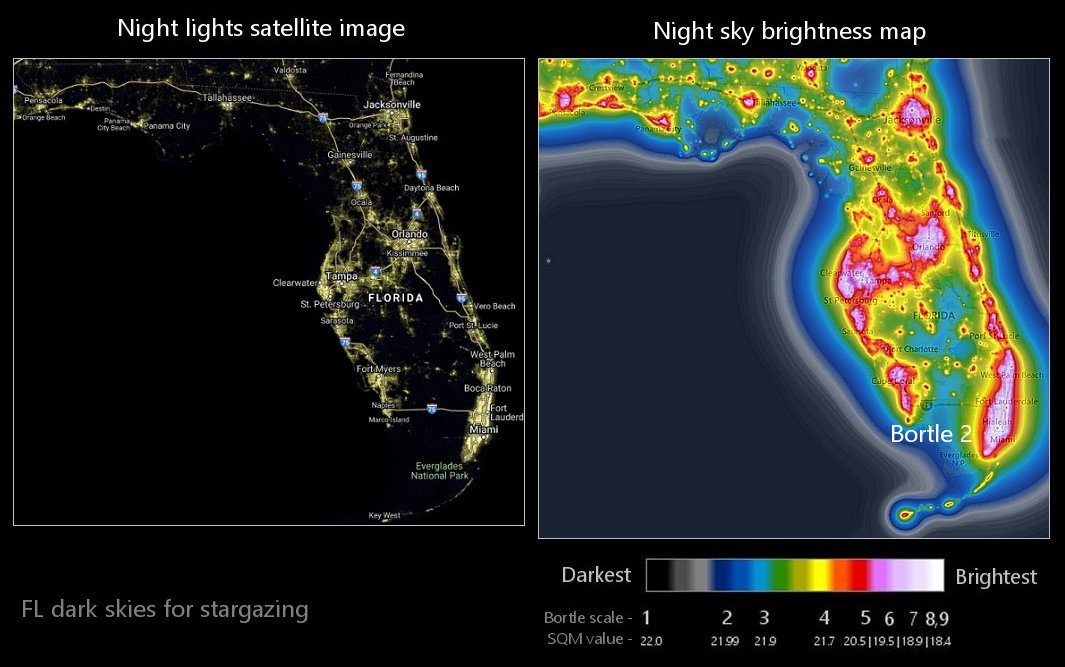
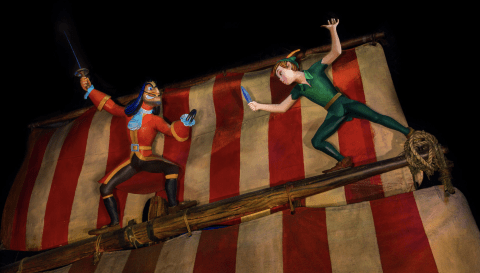
Where’s one place on Earth that you can swing through New York, soar around the world, sail through the Caribbean, sing under the sea, and slide through Antarctica without leaving town? Of course, it’s Orlando… by all accounts, the theme park capital of the world. Thanks to Walt Disney World and Universal Orlando, Central Florida is the place where dark rides bring incredible stories to life using incredible classic, and cutting-edge ride technologies. But not all dark rides are created equal...
Today, we took the chance to look over the enormous portfolios of dark rides you’ll find scattered throughout the Orlando area. In this feature, we’ll list our choices for the best and worst Central Florida dark rides of some common types (like trackless, flume, and motion-based) . Do you agree with our best and worst of Orlando’s dark rides? Which fantastic (or flubbed) attractions did we leave out? Or should one of our runners-up be awarded the “Best” award for some of these ride systems? We can’t wait to read your thoughts in the comments below!
1. TARGET-BLASTING DARK RIDE
The best: men in black: alien attack.
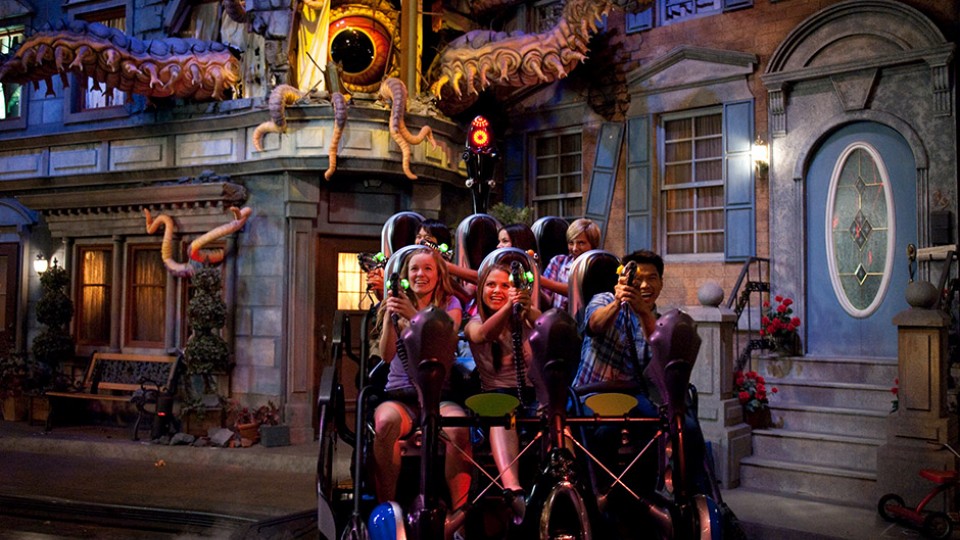
RUNNERS-UP: Toy Story Midway Mania
Despite their proliferation at regional amusement parks, “shoot-’em-up'' dark rides are relatively rare among Disney & Universal Parks. Still, there are enough in Central Florida that some rise to the top while others just don’t feel quite the quality. Of the lot, Men In Black: Alien Attack manages to hit that early-2000s sweet spot before screens became the name of the game. It’s got a clever set-up, an impressive scale, and a compelling competition! It’s a great example of how the industry’s lean toward ‘interactivity” doesn’t always have to mean plotless flat-panel scenes populated by glowing LED targets. Men in Black is large, dimensional, and dynamic. Especially compared to…
THE WORST: Buzz Lightyear’s Space Ranger Spin

In terms of Disney & Universal Parks, Buzz Lightyear’s Space Ranger Spin practically invented the laser-blasting dark ride genre. The 1998 addition to Magic Kingdom’s Tomorrowland was the beginning of the end for the land’s short-lived 1994 “original mythology,” ushering in the Pixarification of Disney Parks. It’s not that Buzz is a bad ride at all; just that its blacklight, cardboard cut-out, “toyetic” style is about as dated as a “classic” can be… Almost every single “castle” park on Earth has a Buzz, but Shanghai’s version dropped the overt, day-glo “plastic sheen” in favor of something more dimensional. We’re hoping Pixar’s upcoming film Lightyear causes a similar reimagining in Orlando.
2. MOTION-BASE DARK RIDE
The best: the amazing adventures of spider-man.
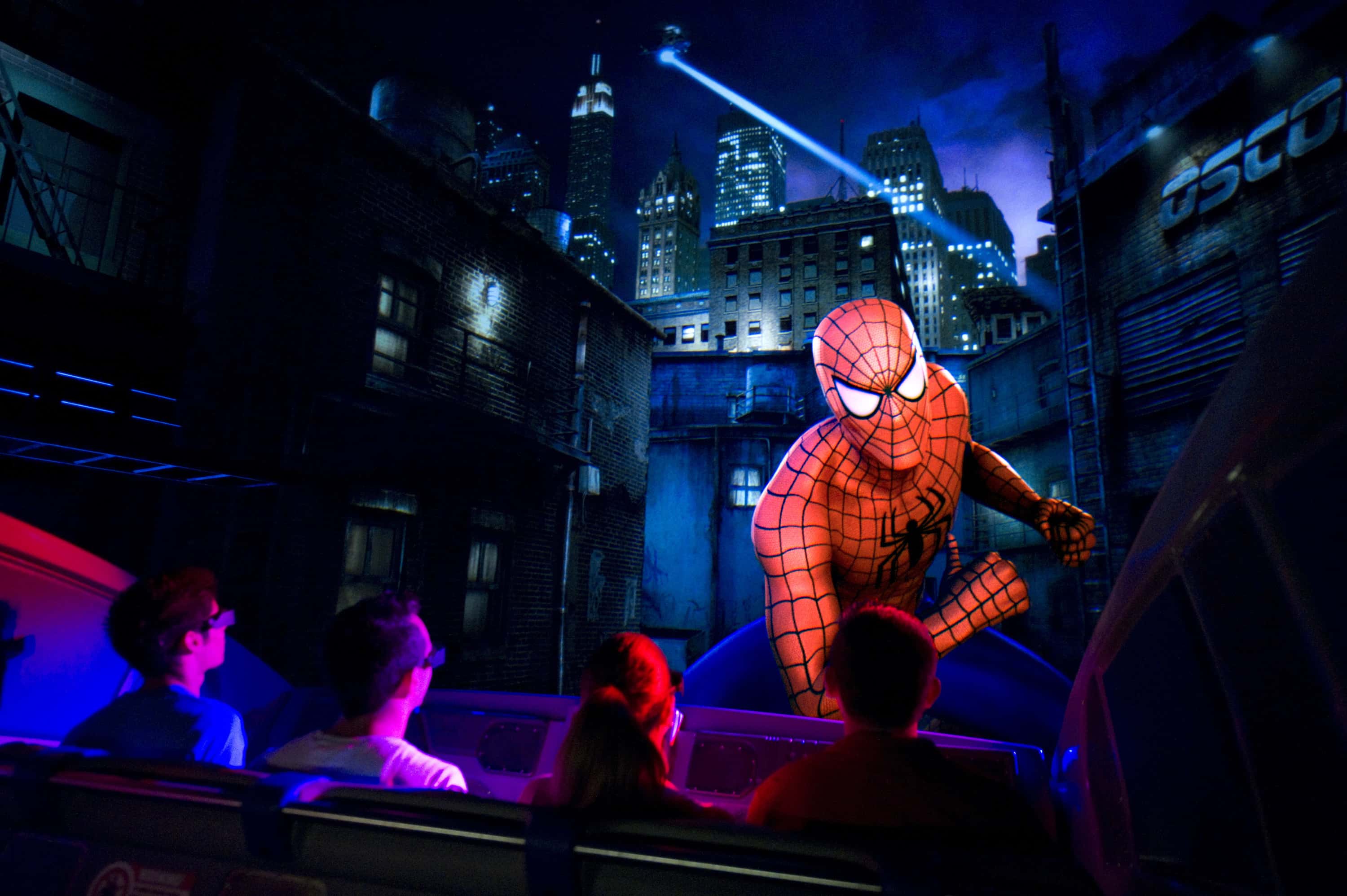
Runners-up: Harry Potter and the Forbidden Journey
Arguably, even two decades after its debut, there’s no modern dark ride on Earth that can match the Modern Marvel: The Amazing Adventures of Spider-Man . Debuting the iconic “SCOOP” ride system (which, it turns out, was dreamed up to compete with the Modern Marvel: Indiana Jones Adventure ’s EMV), the ride is a masterclass in screen-based effects, physical effects, and the precision needed to mesh them together. Sure, the “Spider-Man” formula has been re-used on… well… basically every single Universal ride since… But this major player in the Age of the Simulator nonetheless holds up as a shockingly cool experience that defines Universal Orlando.
THE WORST: DINOSAUR
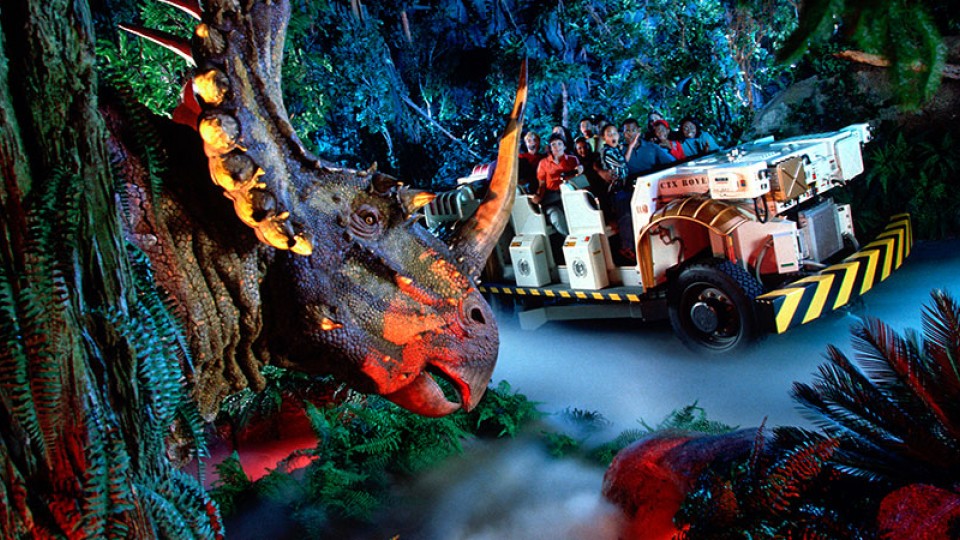
Sorry, folks, but this is most certainly one category where – at least in Orlando – Universal dominates. Disney famously did bring the motion-based EMV technology to Central Florida (and even carbon-copied Indy’s layout) but wrapped the experience as DINOSAUR. In our in-depth history of the Animal Kingdom ride , we weren’t sure whether to classify it as a Modern Marvel or a Declassified Disaster. After all, DINOSAUR is a ton of fun!
...But it’s also kind of a mess. Filled with uneven narration, oddly flat scenes, terrifying animatronics, abandoned effects, and lots and lots of pure darkness, the ride is just plain odd. Especially for industry fans who can’t help but compare it to Indiana Jones Adventure, DINOSAUR comes up short. But even for those who don’t, the ride doesn’t tend to be listed among favorites or classics. And given the cost (and the use of the otherwise-renowned EMV tech), that’s probably not the reaction Disney hoped for.
3. TRACKLESS DARK RIDE
The best: star wars: rise of the resistance.

Runners-up: Mickey & Minnie’s Runaway Railway (Disney’s Hollywood Studios)
In Orlando, it’s pretty hard to compete with STAR WARS: Rise of the Resistance by any 21st century measure (except, maybe, its uptime). The ride is often considered a “next-generation” attraction in that the line between “queue” and “ride” is blurred, and the whole experience technically seeps into the larger mythology of Batuu. Its core, though, is certainly a trackless dark ride (and one where an Animatronic is right on board!) that serves as guests’ escape through the labyrinth of halls that make up the First Order’s Star Destroyer. Home to some of the Best Audio-Animatronics on Earth and a number of captivating physical effects, the ride is sort of a “best-of,” borrowing all the coolest tricks from Imagineering’s playbook.
THE WORST: Antarctica: Empire of the Penguin
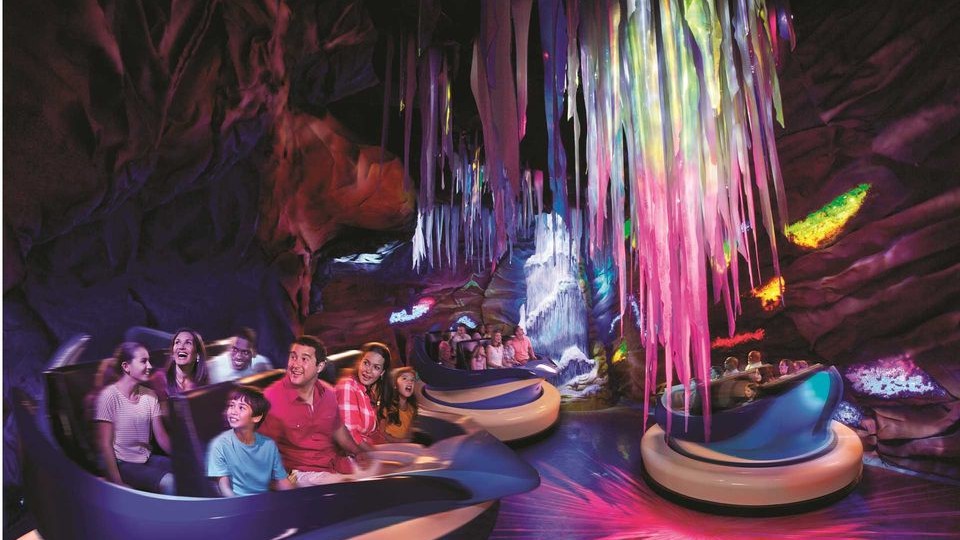
Yes, Disney recently seemed to spoil their unending line up of awesome trackless installations with a very odd attraction in Japan, and we don’t love Universal’s Reign of Kong, but there’s still only one “worst” here in terms of major parks. Fans were aghast when SeaWorld Orlando – not Disney or Universal – announced that they’d open the first major trackless, LPS-based dark ride in the United States. Despite glowing concept art of joyful riders sliding around a bright, icy paradise, though, Empire of the Penguin didn’t quite land. It’s uneven, short, and ends with a pretty embarrassing “simulator” experience. While it would probably be a fun family ride at their Texas or San Diego park, set against the backdrop of Orlando? Yikes…
4. “OMNIMOVER" DARK RIDE
The best: haunted mansion.
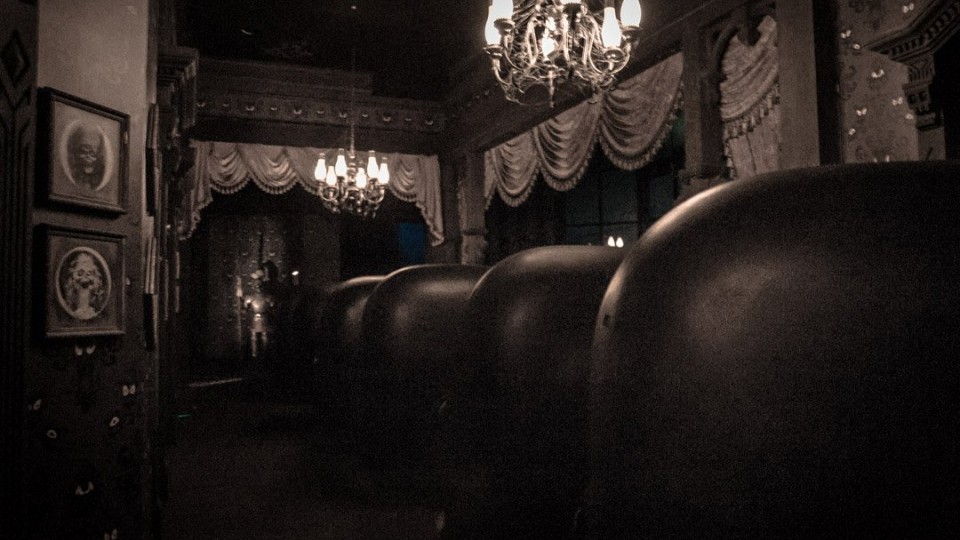
Runners-up: Spaceship Earth
Though the Omnimover ride system officially debuted on Disneyland’s Lost Legend: Adventure Thru Inner Space , there’s certainly no more iconic use of it than as the Haunted Mansion’s “Doom Buggies.” The Omnimover is, by design, almost ethereal; gliding effortlessly and continuously through scenes. It’s part of what gives Disney’s Haunted Mansion a different feel than other spook houses. Rather than triggering pop-up effects as your single car passes alone through a scene, you’re instead an observer, watching as eerie sights and sounds unfold around you. The Haunted Mansion is, of course, an icon of Disney Parks, and even when Omnimovers became the de-facto ride system of EPCOT’s lost classics , it still remained the best use of the system.
THE WORST: Under the Sea: Journey of the Little Mermaid
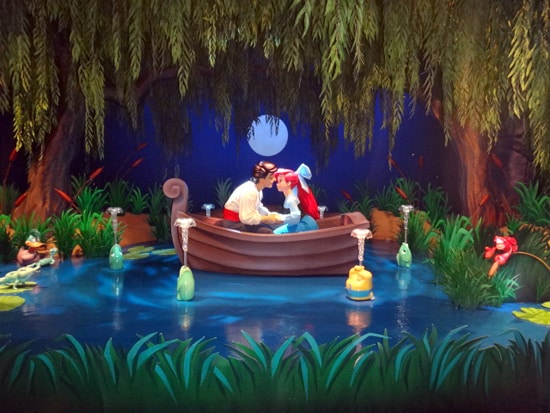
It’s hard to pick a “worst” in this category, because there’s nothing at all that most guests would find at fault in Under the Sea: Journey of the Little Mermaid. As a matter of fact, it’s a fantastic family attraction that’s beautifully integrated into the park’s New Fantasyland. What makes it the “worst” are certainly some of those heady, Armchair-Imagineering nit-picks with it, like that it’s a textbook “book report” ride; that it misuses the Omnimover, placing guests into the role of mere “observers” in a singalong rather than actually being in Ariel’s story; that it’s Audio-Animatronics are… well… kind of “Uncanny valley;” that it famously lacks a finale, merely skipping over the film’s epic, cinematic, and dark-ride ready scenes.
Is Journey of the Little Mermaid a bad ride? Absolutely not. But set alongside the (relatively few) remaining Omnimover-esque rides in Orlando, it’s certainly the least adored by many.

Just your friendly neighborhood fan of tropical hideaways, Victorian boardwalks, mid-century tomorrows, ancient temples, and cursed forests! In between dreaming of Dole Whips, I'm a museum experience developer. I'm also the researcher behind Theme Park Tourist's Legend Library – filled with stories of Lost Legends , Modern Marvels , Declassified Disasters , and more.
Add new comment
Sign up for your free account, about theme park tourist.
Theme Park Tourist is one of the web’s leading sources of essential information and entertaining articles about theme parks in Orlando and beyond.
We are one of the world’s largest theme park guide sites, hosting detailed guides to more than 80 theme parks around the globe.
Find Out More About Us...
Plan Your Trip
Our theme park guides contain reviews and ratings of rides, restaurants and hotels at more than 80 theme parks worldwide.
You can even print them.
Start Planning Now...

30 Dark Tourism Destinations and How to Visit
By: Author Zachary Friedman
Posted on Last updated: March 1, 2024
Categories Travel Destinations
Home » Travel » Travel Destinations » 30 Dark Tourism Destinations and How to Visit
Many of us have a natural morbid curiosity. Death, disasters, atrocities, and destruction fascinate us. Every year, millions of people travel to some of the darkest and most tragic sites on earth to satisfy that curiosity as well as to gain a deeper understanding of the events that took place there. This is called dark tourism. In this guide, we’ll outline some of the most popular dark tourism destinations and explain how to visit them. We’ll also explain exactly what dark tourism is and talk a bit about the ethics, controversies, and motivations of dark tourism.
Personally, I’m a big fan of dark tourism. Over the years, I’ve visited many of the dark tourism sites on this list. In this guide, I’ll share my experience.

Table of Contents
- Auschwitz-Birkenau Memorial, Poland
- Chernobyl Nuclear Disaster Site, Ukraine
- Choeung Ek Killing Fields and S-21, Cambodia
- September 11 Memorial and Museum, New York
- Hiroshima Peace Memorial Park and Museum, Japan
- Kigali Genocide Memorial, Rwanda
- Pompeii, Italy
- Slave Castles, Ghana
- Sedlec Ossuary, Czech Republic
- Alcatraz Island, San Francisco
- Suicide Forest (Aokigahar), Japan
- Fukushima, Japan
- Robben Island, South Africa
- Pearl Harbor, Hawaii
- The Colosseum, Rome
- Mount St. Helens, Washington
- Anne Frank House and Museum, Amsterdam
- Various Nuclear Test Sites
- The Catacombs of Paris
- Warsaw Ghetto, Poland
- Perm-36 Gulag, Russia
- Cremations on the Ganges River in Varanasi, India
- WWII memorials and museums in Berlin, Germany
- Communist Leader Mausoleums
- Somme Battlefield, France
- Verdun Battlefield, France
- D-Day Beaches and Memorials in Normandy
- Antietam National Battlefield, Sharpsburg, Maryland
- Cu Chi Tunnels, Vietnam
What is Dark Tourism?
Dark tourism is a relatively new term for a form of tourism that involves travel to a site where death, tragedy, disaster, violence, atrocity, or suffering took place. This could include sites of genocide, assassination, natural disaster, war, terrorism, man-made disaster, etc. Usually, dark tourism sites have some kind of historical significance. They could also be the site of a recent or ongoing tragic event. Dark tourism is also called black tourism, morbid tourism, and grief tourism.
A few of the most well-known and popular dark tourism sites in the world include the ruins of Pompeii, Auschwitz concentration camp, the site of the Chornobyl nuclear disaster, the Paris Catacombs, Gettysburg, Ground Zero, and the 9/11 memorial in New York. In each of these sites, death, suffering, tragedy, or disaster took place.
Most people visit dark tourism sites for educational purposes. These sites usually have interesting histories. Some people visit because these sites pique a morbid curiosity. Others just want to witness large scale destruction and damage. Everyone has their own motivation.
There are different types of dark tourism as well. For example, dark tourism and heritage tourism are sometimes closely related. For example, someone may choose to visit Holocaust sites to learn about the events that their ancestors experienced. Descendants of slaves may choose to visit slavery heritage sites. Some consider this a form of dark tourism as well.
To consider someone a dark tourist, they must visit the site for dark tourism purposes. Some sites have a dark element but aren’t exclusively visited for dark tourism purposes. For example, if you visit Mount St. Helens to go for a hike, you’re not a dark tourist. If you visit to learn about the volcanic eruption and the damage it caused, you are a dark tourist.
Dark Tourism Destinations
1. auschwitz-birkenau memorial and museum, poland.

Located outside of Krakow, Poland, Auschwitz was the largest and most deadly of the Nazi concentration camps. Between 1.1 and 1.6 million men, women, and children were murdered here during the Holocaust. Auschwitz is one of the largest mass murder sites in the world.
Today, the site symbolizes genocide and the evil acts that humans inflict upon one another. It also acts as a valuable education tool to help prevent atrocities such as the Holocaust from happening again.
Auschwitz is actually a series of 40 concentration camps rather than one large camp. Auschwitz I is the older and smaller camp where political prisoners were held. Here, you’ll see a terrifying exhibition of some of the inmates’ possessions including piles of suitcases, shoes, and human hair.
Auschwitz-Birkenau, which is located a couple of miles down the road, is a much larger concentration camp and extermination camp. Here, you’ll find the ruins of the infamous gas chambers, barracks with wooden shelves where prisoners slept, and the train track which was used to haul thousands of people into the camp.
Auschwitz has become a mass tourist site seeing over 2 million visitors per year and over 60 million visitors since the site opened in 1947. This is probably the world’s biggest and most well known dark tourism site. The Auschwitz Memorial is free to enter but you should book in advance. Only a limited number of tickets are available per day because the site is so popular.
2. Chernobyl Nuclear Disaster Site, Ukraine

On April 26, 1986, the world’s worst nuclear meltdown took place at the Chernobyl nuclear power plant near Pripyat, Ukraine. This disaster caused the death of around 4,000 individuals from radiation-related illness as well as the displacement of over 300,000.
The area is still not safe for people to inhabit, even though some have moved back into their villages anyway. In fact, scientists believe it could take 20,000 years before the exclusion zone is completely safe. The radiation has dissipated enough for tourists to make short visits on guided tours.
Several tour companies offer day trips and multi-day trips to Chernobyl from the nearby city of Kyiv. During the tour, you’ll see the radiation-contaminated Red Forrest and eerie abandoned buildings including the famous Pripyat Amusement Park and a Kindergarten. You’ll also learn about the impact the disaster had on the region.
Keep in mind that there is still a risk of radiation poisoning when visiting the Chernobyl exclusion zone. Radiation levels are still hazardous in much of the zone. Your guide will explain the safety precautions you must take and guide you through the areas that are safe enough to visit.
Chernobyl is one of the world’s most famous and popular dark tourism sites. The recent HBO miniseries, Chernobyl, greatly increased the popularity of the area. Following the release of the show, tourism increased by 30%.
Note: Currently, it’s not possible to visit this site. Hopefully, it will be possible to visit again in the near future.
3. Choeung Ek Killing Fields and Tuol Sleng Genocide Museum (S-21), Cambodia
The Khmer Rouge regime came into power after the Cambodian civil war ended in 1975. The new government was called the Communist Party of Kampuchea. Their leader was prime minister Pol Pot.
Immediately following the end of the war, the Cambodian genocide began. From 1975 to 1979, between 1.7 and 2.5 million people were killed at 300 sites throughout the country. These sites are known as killing fields.
The most famous of these killing fields is Choeung Ek, which is located about 11 miles outside of Phnom Penh, the capital of Cambodia. It is estimated that around 17,000 men, women, and children were killed at this site. Many were killed violently with knives, scythes, bats, and bayonets. This is the main memorial for the Cambodian genocide.
At this site, you’ll see a memorial Buddhist stupa made of glass. Inside the stupa, there are 5,000 human skulls. Many of the displayed skulls are catastrophically damaged, showing the brutal manner in which the victims were killed. The site also includes a mass grave that contains the remains of almost 9,000 people that were exhumed from the surrounding area. Human bones still litter the entire site. Occasionally fragments wash up after heavy rain.
Another famous Cambodian Genocide site is the Tuol Sleng Genocide Museum or S-21. This museum is located in Phnom Penh. Originally, this site was built as a secondary school but was converted into a prison by the Khmer Rouge. Around 20,000 people were imprisoned here during Pol Pot’s reign. Many were tortured and killed. Here, you’ll see prison cells, photos of victims, as well as an exhibit that documents the events of the Cambodian genocide.
4. National September 11 Memorial and Museum, New York

This New York City memorial and museum was built to commemorate and honor the 2,977 people who died in the September 11, 2001 terror attacks as well as the six people who died in the 1993 World Trade Center bombings. The memorial sits on the site where the twin towers once stood.
The main memorial, called Reflecting Absence, consists of two 1-acre pools that occupy the exact footprints where the Twin Towers stood. Each pool features a large waterfall. Bronze parapets with the name of each victim etched in surround the pools. The September 11 Museum, located underground, contains thousands of images, artifacts, recordings, and videos. The exhibit tells the complete story of the events of 9/11.
This site is fairly controversial. Partly for the high price of entry ($24) but mostly for the fact that the remains of over 1000 victims were placed in a tomb in the bedrock under the museum. Many people find this disrespectful. Even so, the 9/11 Memorial is one of the world’s most popular dark tourism sites. Over 6 million people visit this memorial per year.
5. Hiroshima Peace Memorial Park and Museum
This memorial and museum commemorate and honor the city of Hiroshima and the 140,000 people who died when the United States dropped an atomic bomb on the city on August 6, 1945. It also memorializes the world’s first nuclear attack. The aim is to educate people about the danger of nuclear weapons as well as to promote peace.
The atom bomb, codenamed “Little Boy,” detonated 600 meters above the busiest part of downtown Hiroshima. The explosion essentially leveled the area except for a few ruins. This event marked the beginning of the end of WWII. Japan surrendered on August 15, 1945. The park was built on the site of the bombing. Today, the Hiroshima Peace Memorial Park contains a number of monuments as well as a museum and a lecture hall.
Hiroshima Peace Memorial Museum is the main feature of the park. The museum educates visitors about the events leading up to the bombing as well as the catastrophic effect the bomb had on the city. You’ll see photos and artifacts from the bombing. A major section of the museum is dedicated to the stories of the victims and survivors.
The A-Bomb Dome is the second most important site in the park. This is the ruins of the Hiroshima Prefectural Industrial Promotion Hall. Today, it’s just a shell of a building. This building is significant because it is one of the only buildings that survived the blast. Most structures in Hiroshima were built from wood and burned up in fires that the bomb started. This building was also just 150 meters from the hypocenter of the blast. It has been designated a UNESCO World Heritage Site.
A few more significant points of interest in Hiroshima Peace Memorial Park include Children’s Peace Monument, Peace Flame, Peace Bells, Peace Pagoda, Gates of Peace, and Atomic Bomb Memorial Mount. You could easily spend half a day wandering around the park viewing the various monuments and memorials.
3 days after the bombing of Hiroshima on August 9, 1945, The United States bombed the city of Nagasaki in a second nuclear attack. Today, you’ll find a number of memorials and museums including the Atomic Bomb Museum, Peace Park, Oka Masaharu Memorial Peace Museum, and more.
6. Rwanda Genocide Sites (Kigali Genocide Memorial and Murambi Genocide Memorial)
In 1990, a rebel group of Tutsi refugees called the Rwanda Patriotic Front (RPF) invaded Rwanda from Uganda. This started the Rwandan Civil War. President Juvénal Habyarimana signed peace accords in 1993. The following day, the president was assassinated. Genocidal killings of Tutsi people began soon after and the civil war resumed.
The Rwandan genocide lasted from April 7 to July 15, 1994. During that time 500,000-1,000,000 people were killed. This includes about 70% of Rwanda’s Tutsi population. The genocide ended when the RPF captured Kigali and gained control of the country. The government and genocidaires were forced into Zaire (now the Democratic Republic of the Congo).
Today, there are a number of genocide memorials located throughout the country. The largest and most visited is the Kigali Genocide Memorial Centre. The remains of an astonishing 250,000 people are interred at this site. The attached museum includes three exhibits. The first documents the events of genocide from start to finish. The second exhibit is a memorial to the children who died. It includes photos and details about their lives, things they liked, and the way they died. The third exhibit covers genocide around the world.
The Murambi Genocide Memorial (Murambi Technical School), located in southern Rwanda is one of the darkest dark tourism destinations on the planet. Here, around 50,000 Tutsi men, women, and children were murdered by Hutu Interahamwe militiamen in April of 1994.
The Tutsis were told that they could safely shelter at the school and that the French military would protect them. This turned out to be a trap. After being starved for several days to weaken them, they were attacked and killed. Only 34 people survived the attack and escaped. At Murambi, the remains of 800 people are displayed partially decomposed and preserved by lime.
7. Pompeii, Italy

This ancient Roman city was wiped out when nearby Mount Vesuvius erupted in 79 AD. Historians estimate that about 2,000 people died in the disaster. The thick layer of ash and pumice that covered the city preserved this little slice of ancient Rome.
At the ruins, you can see beautifully preserved artwork, pottery, casts of people who died, houses, an amphitheater, and more. Pompeii is a UNESCO World Heritage site and is one of Italy’s most popular tourist destinations with over 2.5 million visitors per year.
Some people question whether or not Pompeii is actually a dark tourism site due to the age of the site. After all, the eruption occurred nearly 2000 years ago. In my opinion, Pompeii is absolutely a dark tourism site due to the large scale death and destruction that happened here. The age of the site is irrelevant.
8. Slave Castles, Ghana (Cape Coast Castle and Elmina Castle)
During the colonial period of West Africa, the British, Dutch, and Portuguese built around 40 castles or forts along the Gold Coast. The Europeans originally used these castles as trading posts for timber or gold.
During that time, African slaves were in high demand in the Americas. The European traders quickly found that the slave trade was more profitable.
They modified their forts to hold as many slaves as possible. Usually in an underground dungeon. African slavers would capture slaves inland then sell them to the Europeans who lived in the castles on the coast. The slaves stayed in the castles until they were shipped across the Atlantic to the Americas.
Living conditions for the slaves were horrible. Slavers shackled and packed the slaves into the castle’s dungeons. There was very little light or ventilation. There was no water or sanitation so the floors were covered in waste. Many became ill. The slaves lived in these conditions for up to three months before being shipped across the Atlantic.
Today, dark tourists visit these castles to learn about the horrors of the slave trade. Two of the most significant castles to visit include Elmina Castle and Cape Coast Castle. Both are located in Ghana. Guided tours are available.
Elmina Castle was the first European trading post and is the oldest European building in Sub Saharan Africa. The Portuguese built the castle in 1482. Today, it is a UNESCO World Heritage Site. Here, you can see the famous ‘Door of No Return’ where slaves exited the castle before boarding ships to Brazil and other Portuguese colonies. You’ll also see the dungeon where the slaves were held as well as the living quarters for the European slavers, who lived on the upper floors of the castle.
Cape Coast Castle was built by Swedish traders in 1653. Over the years, the castle changed hands multiple times until it came into British possession. Here, you can see the dungeons where slaves were held and cannons that were used to defend the fort. In 2009, President Obama visited Cape Coast Castle during his visit to Ghana.
9. Sedlec Ossuary, Czech Republic
This small Roman Catholic chapel is located in a cemetery in a suburb of the city of Kutná Hora in the Czech Republic. Here, you’ll find the remains of 40,000-70,000 people. Initially, the remains were moved from the cemetery into the basement of the chapel to solve an overcrowding problem that was caused by the plague in the 14th century.
In 1870, a local artist named František Rint rearranged the piles of bones into artwork. The most impressive piece is a massive chandelier in the center of the chapel that is made entirely from human bones. Supposedly it contains at least one of every bone in the human body.
Another interesting piece is a large coat of arms made from bones. In the corners of the chapel, you’ll find large stacks of bones. There are cabinets filled with damaged skulls of those who were killed violently in war. The artist also signed his name in bones.
You can visit Selded Ossuary as a day trip from Prague. It’s easy to visit independently by train. Organized tours are available as well. The chapel is pretty small. It only takes 20 minutes or so to see the whole thing. The place gets pretty crowded as it receives over 200,000 visitors per year.
10. Alcatraz Federal Penitentiary, San Francisco

Also known as The Rock, Alcatraz Federal Penitentiary was a maximum-security prison from 1934-1963. It is located on an island in the San Francisco Bay, 1.25 miles offshore. During the 29 years that the prison operated, some of the hardest criminals of the day served time here including the infamous Al Capone, Machine Gun Kelly, Henri Young, and ‘the Birdman of Alcatraz’, Robert Stroud.
For punishment, prisoners were sent to solitary confinement, known as ‘the hole’ at Alcatraz. These inmates got one shower and one hour of exercise per week. Almost equally punishing for some, the prison sits close enough to the mainland that prisoners could see people going about their lives on the outside.
Today, Alcatraz is San Francisco’s most popular tourist attraction with up to 1.5 million visitors per year. The National Park Service manages the island. After arriving at the island by boat, you can take a tour of the prison. You’ll see the prison cells, learn about the dark history of the island, and hear stories of former inmates. Much of the prison remains the way it was while the prison was in operation.
11. Suicide Forest (Aokigahar), Japan
This forest, located to the Northwest of Mount Fuji, is famous for being one of the most popular suicide site in Japan. In 2003, a record was made when 105 bodies were found in the forest. In 2010, over 200 people attempted suicide here with 54 of those being successful.
The most common methods of suicide used are hanging and drug overdose. Because the suicide rate is so high here, Japanese officials installed a sign at the entry to the park which urges suicidal people to seek help.
Part of the reason for the popularity of this forest as a suicide site is that the area has long been associated with death in Japanese culture. The forest is said to be haunted by the yūrei, which are spirits that can’t leave our world.
Here, visitors can roam about the many trails that wind throughout the 30 square kilometer forest. This is an excellent place to enjoy the solitude of the dense forest. Tours are available as well.
Some visitors come here to see if they can spot a body. As you can imagine, this is a very controversial form of dark tourism. For example, YouTuber Logan Paul was criticized for filming a video of a man who had recently committed suicide here in 2018.
12. Fukushima, Japan
On March 11, 2011, an earthquake off the east coast of Japan triggered a tsunami that flooded the reactors at Fukushima nuclear power plant and caused an electrical grid failure. The reactors lost their cooling which led to three nuclear meltdowns at the plant. 154,000 people had to be evacuated. Many were never able to return to their homes.
Today, there is a 20 km exclusion zone surrounding the nuclear plant to protect people from radiation exposure. In 2018 tours to visit the exclusion area began. In 2020, The Great East Japan Earthquake and Nuclear Disaster Memorial Museum opened. On the tour, you’ll see abandoned structures and witness the effects that the disaster had on the region.
13. Robben Island, South Africa
Robben Island, located in Table Bay, north of Cape Town, was used as a prison from the colonial times of the late 1600s until 1996. The prison gained notoriety during the apartheid era of South Africa. It held political prisoners between 1961 and 1991.
The most famous prisoner was political revolutionary, Nobel Peace Prize recipient, and president of South Africa, Nelson Mandela. He served 18 of his 27-year imprisonment on Robben Island before his release in 1990. in 1994, South Africa elected Mandela as the first president. A total of three former inmates went on to become South African presidents including Kgalema Motlanthe and Jacob Zuma.
Conditions in the prison were incredibly harsh. Prisoners were held isolated from one another in small cells. The prison was segregated by race. Food rations were small and communication with the outside world was limited. Prisoners were also forced to do hard labor in a lime quarry located on the island.
Today, Robben Island is a UNESCO World Heritage Site and a South African National Heritage Site. The only way to visit Robben Island is on a guided tour. The tour leaves from Cape Town and lasts for about 3.5 hours. The guides are all former prisoners. They take you around the prison and share their first-hand stories about their time there. You’ll see the lime quarry where the prisoners were forced to work as well as Nelson Mandela’s prison cell.
14. Pearl Harbor, Hawaii
On December 7, 1941, the Imperial Japanese Navy Air Service surprise attacked the United States naval base at Pearl Harbor, Hawaii. The goal of the attack was to prevent the United States Navy fleet from interfering with the Japanese military plans to expand throughout Southeast Asia. If Japan crippled the United States fleet was crippled, they could invade and conquer US and British held territories such as the Philippines, Guam, Singapore, Malaysia, and Hong Kong, as well as other small islands of the Pacific.
The Japanese launched a massive attack with 353 aircraft which took off from six aircraft carriers. They sank 4 of the 8 battleships stationed at Pearl Harbor. They seriously damaged the other four. 188 aircraft were also destroyed in the attack 159 were damaged. The attack killed 2,403 Americans and injured 1,178. The attack also damaged or destroyed a considerable amount of the base’s infrastructure including a power station, piers, various buildings, and more.
The most significant loss was the battleship USS Arizona. It suffered a direct hit to an ammunition magazine which exploded and caused the ship to sink almost instantly. 1,000 sailors sank with the ship.
The attack on Pearl Harbor dragged the United States into World War II. The day after the attack, Japan declared war on the United States. The next day, the United States declared war on Japan. Three days later, Germany and Italy both declared war on the United States.
Today, there are a number of museums and memorials at Pearl Harbor that commemorate the attack. The main site is the USS Arizona memorial. This memorial straddles the sunken ship and is accessible only by boat. Inside, you’ll see a number of exhibits including one of the ship’s anchors, a shrine with the names of all of those who died as well as some plaques with information about the attack. There is also an opening in the floor where you can view the deck of the ship underwater. Onshore, there is also a museum that outlines the events leading up to the attack and the attack itself.
Nearby, you can also view the USS Missouri Memorial, USS Utah Memorial, USS Oklahoma Memorial, Pacific Aviation Museum, and USS Bowfin Museum.
15. The Colosseum, Rome

Built in Ancient Rome between 72-80 AD, the Colosseum is one of the oldest and most recognizable dark tourism sites. At the time, it was the largest amphitheater ever built with a capacity of 50,000-80,000 spectators. The Colosseum, also known as the Flavian Amphitheatre, hosted a number of dark and violent events including gladiatorial events, executions, animal hunts, and battle re-enactments.
The most famous of these events were the gladiatorial contests. People and animals brutally battled to the death for the entertainment of thousands of spectators. Most gladiators were slaves, criminals, or prisoners of war but some volunteered to seek fame and fortune.
Exotic wild animals including lions, hippos, rhinos, elephants, bears, tigers, crocodiles, etc. were brought in from Africa and the Middle East. These animals were used for hunts or battles. In some cases, people were fed to lions.
Over the course of the 400 years that these gladiatorial events took place, historians estimate that around 400,000 people died in the Colosseum. Some people consider these events the earliest form of dark tourism.
Today, the Colosseum is one of the top tourist destinations in Rome and the world. Around 7 million people visit this site per year. There are a number of guided tours available. You’ll see the underground level where the gladiators prepared to fight, the arena floor where the gladiatorial fights took place, areas where the animals were kept, and artwork.
16. Mount St. Helens, Washington
The 1980 volcanic eruption of Mount St. Helens killed 57 people and caused a great deal of destruction to the mountain and surrounding area including the largest landslide in recorded history. The eruption was so violent that the mountain’s elevation decreased by 1300 feet. The top completely blew off.
Many tourists come to visit the area each year. Today, you can see tree stumps and dead trees that still stand around the blast site. There is a visitor center with an exhibition about the eruption. In the visitor center, they also have a small movie theater that shows a short documentary about the event. The surrounding state park offers plenty of hiking, camping, climbing, and other recreational activities.
17. Montserrat
This volcanic island in the Caribbean is sometimes called a modern-day Pompeii. The Soufriere Hills Volcano became active in the mid-1990s and slowly covered the former capital of Plymouth in ash. The town was evacuated in 1997 just before a major eruption covered much of it.
The volcano is still very active today, periodically spewing ash, smoke, and gasses across 1/3 of the island. Occasionally pyroclastic flows cover more of the island’s land. Travelers can hike to a lookout point to view smoke spewing from the volcano and maybe get a glimpse of Plymouth. It is also possible to view the volcano and town by boat. It is unsafe to visit the town of Plymouth at this time.
16. Anne Frank House and Museum, Amsterdam
In this famous canal house Anne Frank, her family, and four others hid from Nazi persecution for 761 days. They quietly lived in a hidden part of the house called the Secret Annex. Anne Frank is famous for keeping a diary of her daily thoughts and experiences during her days in hiding during World War II.
Sadly, Anne Frank and the others hiding in the Secret Annex were betrayed by an unknown informant and discovered by the Nazis on August 4, 1944. The Nazis split them up and moved them to various concentration camps. Anne Frank died in Bergen-Belsen concentration camp in February of 1945 when she was just 15 years old. Anne’s father Otto, who survived the Holocaust, discovered his daughter’s diary after the war and published it in 1947.
The canal house where the two families hid is a now museum that attracts up to 1.2 million visitors per year. Here, you can walk through the Secret Annex where Anne Frank and her family hid. The original diary is on display in the attached museum. The museum also includes a permanent exhibit about the life of Anne Frank and her experience during the war.
19. Nuclear Test Sites
Since nuclear testing began in 1945, 8 countries have detonated around 2056 nuclear bombs at dozens of test sites around the world. A few nuclear test sites that you can visit include:
- Semipalatinsk Test Site (The Polygon)- Semipalatinsk was the Soviet Union’s primary nuclear test site from 1949-1991. It is located on the steppe of northeastern Kazakhstan. More nuclear weapons detonated here than anywhere else on the planet. Beginning in 2014 parts of the area have opened up for tourism. There isn’t all that much to see here outside of some massive craters and some concrete towers and bunkers that housed instruments to measure the blasts.
- Nevada Test Site- This site was the United States’ main nuclear testing site from the time it was established in 1951 until nuclear testing ended in 1992. The site is located about 65 miles to the northeast of Las Vegas. Here, you can see a number of large craters in the desert where nuclear weapons were detonated for testing purposes. Monthly public tours are offered but are often fully booked months in advance. This is a difficult place to visit.
- Bikini Atoll, Martial Islands- This was one of the United States’ main nuclear test sites. Between 1946 and 1958, 23 atomic bomb tests were performed here. The blasts turned out to be more destructive than anticipated and resulted in significant contamination to the surrounding area. Probably the biggest attraction for tourists here is Scuba diving the 10 ships that were sunk during nuclear tests. This is a risky area to visit due to the significant levels of radiation that still exist.
20. Catacombs of Paris, France

This network of underground ossuaries underneath the city of Pairs holds the remains of around 6 million people. The tunnels were originally mine tunnels. The Paris Catacombs were built to solve the problem of the city’s overflowing cemeteries. The dead were crowding the living. Starting in 1786, the city began transporting human remains from the city’s cemeteries into the underground tunnels by covered wagon during the night. The catacombs open to tourism in 1867.
Today, the Catacombs are one of the more popular tourist destinations in Paris. You can book a guided tour and wander through the labyrinth of bone filled tunnels and view the millions of bones stacked neatly throughout. Around 300,000 people visit this site per year. It is only accessible by tour.
21. Warsaw Ghetto, Poland
Ghettos were segregated neighborhoods where Jewish people were forced to live while under Nazi occupation during WWII. The largest of these was the Warsaw Ghetto. The area actually consists of two smaller ghettos with a footbridge between them. At its peak, approximately 460,000 people lived in Warsaw Ghetto.
During the Uprising the ghetto was almost completely destroyed. Today, you can visit the area and view a small number of streets and buildings that survived. The monument called ‘The Footbridge of Memory’ stands at the site of the original footbridge.
22. Perm-36 Gulag, Russia
Following the Bolshevik Revolution, the Soviet Union built a large system of forced labor camps to imprison ‘enemies of the state.’ These included government officials, military members, and regular citizens. Anyone who was anti-communist or anti-Stalin was imprisoned. These camps were known as gulags. Millions of people were held in these camps and forced to perform backbreaking work in extremely brutal conditions.
Perm-36 is the only remaining Soviet gulag. It is located about 60 miles from the Russian city of Perm in the Western Ural Mountains. The camp operated from 1946-1987. Perm-36 is unique because it was not closed after Stalin’s death in 1953. This is one of the only gulags that was not demolished after the Soviet Union collapsed in 1991.
When Perm-36 opened, it was used as a forced labor camp for regular criminals. In later years, the camp housed political prisoners. The prisoners were forced to do logging work. Some political prisoners lived in 24 hour closed cells. Perm 36 was considered the harshest political camp in the Soviet Union.
Today’s site operates as a museum and memorial called The Museum of the History of Political Repression Perm-36. It opened to the public in 1995. Here, you’ll see the wooden barracks that the prisoners built, various prison buildings, and an exhibit about the gulag system and the prisoners. You’ll also learn about the economic benefit that the gulag system created for the Soviet Union.
23. Cremations on the Ganges River in Varanasi, India

Varanasi is a holy city located on the Ganges river in Uttar Pradesh, India. The city has become a popular dark tourism destination for its famous Hindu cremation ceremonies that take place on the banks of the river. In the Hindu religion, people believe that cremation on the banks of the Ganges river breaks the cycle of reincarnation so they can achieve salvation. Along the river, dozens of cremations take place out in the open every day.
The bodies are placed atop piles of wood and set on fire until they turn to ash. The ashes are then scattered in the Ganges River, which is considered a holy site in the Hindu religion. Poor families who cannot afford a cremation sometimes release the entire body of their loved one in the river to decompose naturally. Some terminally ill people travel to Varanasi so they can die and be cremated in the holy city.
Tourists are welcome to view and experience these cremation ceremonies. When you arrive at the famous ghats on the bank of the river in Varanasi, you’ll clearly see the cremation sites. Just look for the smoke. You’ll see open areas with large fires and piles of wood sitting around. The cremations take place here.
For a few dollars, you can hire a guide to walk you through the cremation site and explain how the process works. There are multiple cremations taking place simultaneously at all hours of the day. You can walk right up and see the cremation and feel the heat from the fire and smell the smoke.
As you can imagine, this is a fairly controversial form of dark tourism. After all, you are essentially attending a cremation for touristic purposes as the family grieves of the loss of their loved one. Some view this as voyeuristic. It’s up to you to decide whether or not this form of dark tourism is ethical.
24. Berlin, Germany

Berlin is one of the darkest cities on earth. It was the capital of Nazi Germany, one of the world’s most evil regimes. Next, it became the most significant city in the cold war. It was also the capital of the socialist single-party regime of the former GDR. As a result, Berlin is packed with dozens of dark tourism sites. A few of the most popular ones include:
- Memorial to the Murdered Jews of Europe (the Holocaust Memorial)- This memorial is to the Jewish people murdered during the Holocaust. It contains 2,711 concrete slabs ranging in height from .2-4.7 meters. The slabs are arranged in a grid pattern over a 19,000 square meter site. Below the memorial is an information center that contains the names of 3 million Holocaust victims as well as photographs and letters. This memorial is quite controversial. Partly because it is so vague. There is no mention of Nazi Germany or the Holocaust on the memorial itself or in the official name of the memorial. People also use the site as a recreational area, sitting or standing on the pillars. Many consider this to be disrespectful. Due to its size and design, the memorial is difficult to defend from vandals.
- Berlin Wall- Between 1961 and 1989, this concrete barrier divided West Berlin from surrounding East Germany. The German Democratic Republic (East Germany) constructed the wall to prevent East Germans from defecting to the west. The four-meter tall wall extended 155km (96 miles) and cut through 55 streets. Today, you can see several small sections of the wall still standing in the city. The largest is is a 1.4 km section that is part of the Berlin Wall Memorial. Here, you can see the graffiti on the west side and learn about the historical significance of the wall.
- Checkpoint Charlie Museum- Checkpoint Charlie is the most well-known crossing between East and West Berlin. The original guardhouse was preserved and today is part of the Checkpoint Charlie museum. Here, you can see exhibits about the Berlin Wall, the Cold War, and some famous escape attempts.
- Jewish Museum- Designed by architect Daniel Libeskind, the Jewish Museum is one of Germany’s best and most popular museums as well as one of Berlin’s most striking landmarks. Here, you’ll find thousands of artifacts, photos, religious objects, and archives that document the struggle of the German Jewish people from the Middle Ages to the present time. The museum also houses a massive library and hosts various events throughout the year.
- Topography of Terror Museum- This museum is located on the site of the Gestapo secret police and SS headquarters. Allied bombings destroyed the original building in 1945. After many years of delay, the museum opened in 2010. The main exhibit focuses on policing under Nazi rule. You’ll see photos, documents, short films, and artifacts that show the crimes that the SS and Gestapo committed throughout Europe. The grounds of the museum also contain some historic artifacts including a large section of the Berlin Wall. You’ll also see an excavated trench that exposes the cellar wall, where political prisoners were kept, tortured, and ofttimes executed.
- DDR Museum- This newer museum outlines life in East Berlin under communist rule with a hands-on approach. Here, you’ll see a recreation of an interrogation room, prison cell, and an apartment. You can try on clothing and watch television from the era. The exhibit covers food, music, daily life, education, architecture, and more. You’ll also learn about the mass surveillance conducted during the time. This is a private museum and is one of Berlin’s most popular.
25. Communist Leader Mausoleums
For whatever reason, communists love to embalm their leaders after they die and put the bodies on public display. A few famous mausoleums you can visit include:
- Lenin Mausoleum- This mausoleum is located in the Red Square in the center of Moscow. Inside, you can view the embalmed corpse of the Soviet leader Vladimir Lenin. The body has been on public display since shortly after his death in 1924. The mausoleum is open to the public and free to enter. Stalin’s body was put on display here from 1953-1961 but was removed and buried near the mausoleum.
- Ho Chi Minh Mausoleum- This mausoleum is located in Ba Dinh Square in Hanoi, Vietnam. Inside, you can view the embalmed body of Vietnamese revolutionary and president Ho Chi Minh, who died in 1969. The body is kept in a dimly lit glass case which is heavily guarded by military honor guards. The mausoleum is open to the public.
- Mausoleum of Mao Zedong- This large mausoleum, also known as Chairman Mao Memorial Hall, is located in the center of Tienanmen Square in central Beijing. Here, you can view the embalmed remains of Mao Zedong, who served as the Chairman of the Communist Party of China from 1945-1976. Interestingly, Chairman Mao wanted to be cremated. The mausoleum is open to the public.
- Kumsusan Palace of the Sun (Kim Il Sung Mausoleum)- This absolutely massive palace is located in the North Korean capital of Pyongyang. The building was intended to be the official residence of Kim Il Sung but was converted into a mausoleum when he died in 1994. Inside, you can view the embalmed remains of North Korean founder Kim Il Sung as well as his son and former leader of North Korea, Kim Jong Il. Both bodies lie inside of glass sarcophaguses. The mausoleum is open to the public. Foreigners can only enter the palace when they are on an official government tour.
26. Somme Battlefield, France
The Battle of the Somme was a WWI battle fought between the French Third Republic and British Empire against the German Empire. The battle took place between July 1 and November 18, 1916. Over three million men fought in the Battle of the Somme. One million were killed, injured, or went missing, making this the most bloody battle of WWI and possibly the most deadly battle in world history.
Several factors contributed to the massive amount of death in the battle. First, the battlefield was small. The Germans were also well prepared and trained for trench warfare. An incredible amount of heavy artillery was also used in this battle.
The Battle of the Somme ended when British Commander in Chief Sir Douglas Haig decided to stop the offensive near the Somme River. When the battle ended, the British and French armies had gained just six miles of land. Modern historians are not in agreement as to whether or not the battle was a success.
Today, there are a number of monuments, museums, cemeteries, and battle sites that you can visit in Somme. The Remembered Trail leads visitors through some of the most significant locations. It’s is a great place to start in the region. Guided tours of the area are also available.
27. Verdun Battlefield, France
The battle of Verdun lasted from February 21-December 18, 1916, making it the longest battles in World War One at 302 days. This battle was also one of the most costly with up to 1 million casualties between the French and German armies.
Today, you can view the battlefield complete with shell craters that are still visible over 100 years later. You’ll also find several memorials including an ossuary. The battlefield itself contains the remains of 100,000 soldiers. You can also visit the Verdun Memorial Museum which features artifacts from the battle as well as information about the time.
28. D-Day Beaches and Memorials in Normandy
On June 6, 1944, the Allied Forces invaded Nazi occupied France on the beaches of Normandy. This operation, known as Operation Overlord, was the largest amphibious invasion in world history. This event marked the beginning of the liberation of France and Western Europe and eventually led to the Allied victory over the Third Reich on the Western Front. The D-Day invasion of Normandy resulted in 4,000-9,000 German casualties and around 10,000 Allied casualties including 4,414 deaths.
Today, there are dozens of memorials, museums, and war cemeteries along the beaches of Normandy as well as further inland. A few of the most significant D-Day sites to visit include:
- Beach landing sites- The 50 miles stretch of Normandy beach was divided into 5 sections where the invasion took place. The beach landing sites include Utah, Omaha, Gold, Juno, and Sword. Today, you can visit each of the 5 beaches. Probably the most popular beach to visit is Omaha. Here, you’ll see German bunkers and the sculpture Les Braves which commemorates the American soldiers who died on D-Day.
- Utah Beach Museum- This museum outlines the entire D-Day invasion from the planning phase until the end of the battle. Here, you’ll see vehicles, artifacts, and photographs from the massive invasion. The museum overlooks Utah Beach.
- Normandy American Cemetery and Memorial- This cemetery, overlooking Omaha Beach, contains 9,388 graves of American soldiers who died in WWII. Mostly on D-Day.
- Overlord Museum- This museum, located near Omaha Beach and the American cemetery, documents the time period between the Allied landing and the liberation of Paris. Here, you’ll see thousands of artifacts from the invasion including tanks and cannons as well as photos and reconstructed battle scenes.
- Pegasus Bridge- 6000 British paratroopers landed here with supplies and weapons just past midnight on June 6, 1944. Their job was to secure the bridge so German reinforcements couldn’t cross. The current bridge is a reconstruction of the original, which was destroyed.
- Memorial Museum of the Battle of Normandy- This museum, which is located in Bayeux, outlines the military operation in detail. Here, you’ll see military equipment, artifacts, photos, and a fantastic short film about the D-Day landings.
- Caen Memorial Center- This museum outlines the battle of Normandy from the end of WWI all the way to the beginning of the Cold War. This gives you a great overview of the historical events leading up to the war and their effects on Europe and the world. Here, you’ll see letters and personal belongings from soldiers, airplanes, and a short documentary film with footage of the D-Day invasion.
- Airborne Museum- This museum, located in Sainte-Mère-Église, focuses on the paratroopers who landed in Normandy the night before the attack. Here, you’ll see photos, artifacts, tanks, and airplanes including a WACO glider and C-47 that you can enter.
29. Antietam National Battlefield, Sharpsburg, Maryland
On September 17, 1862, Confederate General Robert E. Lee and his Army of Northern Virginia battled Union General George B. McClellan and his Army of the Potomac in the Battle of Anteteitum near Sharpsburg, Maryland. This was the bloodiest battle of the American Civil War with 22,717 dead, injured, or missing. This massive loss of life took place over the course of just 12 hours.
The battle ended when Lee decided to withdraw back to Virginia. McClellan decided not to follow him. The Union claimed victory. After the battle, President Lincoln announced his Emancipation Proclamation which freed 3.5 million slaves.
Antietam is considered to be one of the most well-preserved American Civil War Battlefields. Probably because it was one of the first battlefields preserved in 1890. Today, visitors can take a self-guided tour of the battlefield or hire a tour guide. You’ll see landmarks of the battle such as the Cornfield, Dunker Church, and Burnside’s Bridge.
30. Cu Chi Tunnels, Vietnam
The Cu Chi Tunnels are a massive network of underground tunnels located outside of Ho Chi Minh City, Vietnam. They were used by Viet Cong soldiers for a number of purposes including hiding spots, supply routes, living quarters, hospitals, and food and weapons caches. They were famously used as a base of operation for the North Vietnamese during the Tết Offensive in 1968.
Life in the Cu Chi Tunnels was difficult. Air quality was poor. The tunnels were cramped and claustrophobic. Food and water were limited. Rodents, ants, snakes, scorpions, and spiders infested the tunnels. Diseases including Malaria and intestinal parasites were common. During heavy bombing campaigns, soldiers had to stay in the tunnels for days at a time.
Today, the Cu Chi Tunnels are a war memorial operated by the Vietnamese government. They are also a popular tourist dark tourist attraction. You can visit the tunnels on a day trip from Ho Chi Minh City. Here, you can crawl through a safe section of the tunnels, watch a short film about the war, and view some different booby traps and trap doors as well as an entrance into the tunnels. There is also a firing range where you can shoot Vietnam War era weapons including an M60 machine gun.
My Experience: Why I Enjoy Dark Tourism
My main motivation to visit dark tourism sites is education. For whatever reason, I wasn’t interested in history when I was in school. I just found it boring. Now, I love history. By visiting dark tourist sites, I have gained a deeper understanding of some of the most significant events in world history. It’s so much more real and engaging when you are standing where an event took place and exploring the landscape and looking at actual artifacts.
It’s also amazing to see how human civilization evolves over the years. For example, 2000 years ago, gladiator games were an acceptable form of entertainment. Most people would not be okay with that today. It is also interesting to see how technology, weapons, clothing, politics, and more have changed throughout the years. The world was a completely different place just 20 years ago. Times change quickly.
I also have a pretty strong morbid curiosity. Dark things simply interest me. I find it fascinating to imagine the horrors that humans have endured and overcome.
Final Thoughts About Dark Tourism
Dark tourism often gets a bad rap in the media. People get the idea that it is disrespectful, voyeuristic, sick, or even unethical. Some country’s tourism departments also try to hide their dark tourism sites because they fear a bad reputation. They may not want people to associate the country with its dark past.
The truth is that most dark tourism is simply educational. People like to visit these sites to learn about their history. They also satisfy our natural morbid fascination. There is nothing wrong with visiting dark tourist places, as long as you do so respectfully.
One important thing to remember is that dark tourism is not a new form of tourism. People have been visiting dark sites for as long as tourism has existed. For example, tourists began visiting Pompeii in the 1800s. The gladiatorial games could be considered one of the earliest forms of dark tourism. Those began when the Colosseum opened in 80 AD. People are naturally interested in these types of destinations and will continue to be.
Dark tourism is also a very broad term. Many of the world’s most visited tourism sites can be considered dark tourism sites. There is also a lot of overlap with mass tourism. Most people don’t travel exclusively to visit dark sites. Instead, they pair dark tourism with regular tourist attractions. For example, if someone is in Hawaii, they may spend a day visiting Pearl Harbor and the various memorials then go to the beach the next day. If someone visits Kyiv, they’ll probably take a day trip to Chornobyl because it’s one of the biggest tourist attractions in the region. It’s common to pair dark tourist sites with other types of sites.
Hopefully, this guide helps you in planning your visit to some of the world’s best dark tourism sites.
If you’re on the fence about dark tourism, check out my guide to the ethics and criticisms of dark tourism.
Are you a dark tourist? Share your favorite dark tourism destination in the comments below!
Pin it for later!

More from Where The Road Forks
- 35 Types of Tourism
- How to Plan a Round the World Trip
- 30 Free Things to do While Traveling
- The Best Solo Travel Destinations
- Whale Watching in South Africa: Where to Go
- 21 Free Airline Stopover Options
Zachary Friedman is an accomplished travel writer and professional blogger. Since 2011, he has traveled to 66 countries and 6 continents. He founded ‘Where The Road Forks’ in 2017 to provide readers with information and insights based on his travel and outdoor recreation experience and expertise. Zachary is also an avid cyclist and hiker. Living as a digital nomad, Zachary balances his professional life with his passions for hiking, camping, cycling, and worldwide exploration. For a deeper dive into his journey and background, visit the About page. For inquiries and collaborations, please reach out through the Contact page. You can also follow him on Facebook.
Sharing is caring!
Sign me up for the newsletter!
- Share full article
Advertisement
Supported by
Beaches? Cruises? ‘Dark’ Tourists Prefer the Gloomy and Macabre
Travelers who use their off time to visit places like the Chernobyl nuclear plant or current conflict zones say they no longer want a sanitized version of a troubled world.

By Maria Cramer
North Korea. East Timor. Nagorno-Karabakh, a mountainous enclave that for decades has been a tinderbox for ethnic conflict between Armenians and Azerbaijanis.
They’re not your typical top tourist destinations.
But don’t tell that to Erik Faarlund, the editor of a photography website from Norway, who has visited all three. His next “dream” trip is to tour San Fernando in the Philippines around Easter , when people volunteer to be nailed to a cross to commemorate the suffering of Jesus Christ, a practice discouraged by the Catholic Church.
Mr. Faarlund, whose wife prefers sunning on Mediterranean beaches, said he often travels alone.
“She wonders why on earth I want to go to these places, and I wonder why on earth she goes to the places she goes to,” he said.
Mr. Faarlund, 52, has visited places that fall under a category of travel known as dark tourism , an all-encompassing term that boils down to visiting places associated with death, tragedy and the macabre.
As travel opens up, most people are using their vacation time for the typical goals: to escape reality, relax and recharge. Not so dark tourists, who use their vacation time to plunge deeper into the bleak, even violent corners of the world.
They say going to abandoned nuclear plants or countries where genocides took place is a way to understand the harsh realities of current political turmoil, climate calamities, war and the growing threat of authoritarianism.
“When the whole world is on fire and flooded and no one can afford their energy bills, lying on a beach at a five-star resort feels embarrassing,” said Jodie Joyce, who handles contracts for a genome sequencing company in England and has visited Chernobyl and North Korea .
Mr. Faarlund, who does not see his travels as dark tourism, said he wants to visit places “that function totally differently from the way things are run at home.”
Whatever their motivations, Mr. Faarlund and Ms. Joyce are hardly alone.
Eighty-two percent of American travelers said they have visited at least one dark tourism destination in their lifetime, according to a study published in September by Passport-photo.online, which surveyed more than 900 people. More than half of those surveyed said they preferred visiting “active” or former war zones. About 30 percent said that once the war in Ukraine ends, they wanted to visit the Azovstal steel plant, where Ukrainian soldiers resisted Russian forces for months .
The growing popularity of dark tourism suggests more and more people are resisting vacations that promise escapism, choosing instead to witness firsthand the sites of suffering they have only read about, said Gareth Johnson, a founder of Young Pioneer Tours , which organized trips for Ms. Joyce and Mr. Faarlund.
Tourists, he said, are tired of “getting a sanitized version of the world.”
A pastime that goes back to Gladiator Days
The term “dark tourism” was coined in 1996, by two academics from Scotland, J. John Lennon and Malcolm Foley, who wrote “Dark Tourism: The Attraction to Death and Disaster.”
But people have used their leisure time to witness horror for hundreds of years, said Craig Wight, associate professor of tourism management at Edinburgh Napier University.
“It goes back to the gladiator battles” of ancient Rome, he said. “People coming to watch public hangings. You had tourists sitting comfortably in carriages watching the Battle of Waterloo.”
Professor Wight said the modern dark tourist usually goes to a site defined by tragedy to make a connection to the place, a feeling that is difficult to achieve by just reading about it.
By that definition, anyone can be a dark tourist. A tourist who takes a weekend trip to New York City may visit Ground Zero. Visitors to Boston may drive north to Salem to learn more about the persecution of people accused of witchcraft in the 17th century. Travelers to Germany or Poland might visit a concentration camp. They might have any number of motivations, from honoring victims of genocide to getting a better understanding of history. But in general, a dark tourist is someone who makes a habit of seeking out places that are either tragic, morbid or even dangerous, whether the destinations are local or as far away as Chernobyl.
In recent years, as tour operators have sprung up worldwide promising deep dives into places known for recent tragedy, media attention has followed and so have questions about the intentions of visitors, said Dorina-Maria Buda, a professor of tourism studies at Nottingham Trent University .
Stories of people gawking at neighborhoods in New Orleans destroyed by Hurricane Katrina or posing for selfies at Dachau led to disgust and outrage .
Were people driven to visit these sites out of a “sense of voyeurism or is it a sense of sharing in the pain and showing support?” Professor Buda said.
Most dark tourists are not voyeurs who pose for photos at Auschwitz, said Sian Staudinger, who runs the Austria-based Dark Tourist Trips , which organizes itineraries in the United Kingdom and other parts of Europe and instructs travelers to follow rules like “NO SELFIES!”
“Dark tourists in general ask meaningful questions,” Ms. Staudinger said. “They don’t talk too loud. They don’t laugh. They’re not taking photos at a concentration camp.”
‘Ethically murky territory’
David Farrier , a journalist from New Zealand, spent a year documenting travels to places like Aokigahara , the so-called suicide forest in Japan, the luxury prison Pablo Escobar built for himself in Colombia and McKamey Manor in Tennessee, a notorious haunted house tour where people sign up to be buried alive, submerged in cold water until they feel like they will drown and beaten.
The journey was turned into a show, “Dark Tourist,” that streamed on Netflix in 2018 and was derided by some critics as ghoulish and “sordid.”
Mr. Farrier, 39, said he often questioned the moral implications of his trips.
“It’s very ethically murky territory,” Mr. Farrier said.
But it felt worthwhile to “roll the cameras” on places and rituals that most people want to know about but will never experience, he said.
Visiting places where terrible events unfolded was humbling and helped him confront his fear of death.
He said he felt privileged to have visited most of the places he saw, except McKamey Manor.
“That was deranged,” Mr. Farrier said.
Professor Buda said dark tourists she has interviewed have described feelings of shock and fear at seeing armed soldiers on streets of countries where there is ongoing conflict or that are run by dictatorships.
“When you’re part of a society that is by and large stable and you’ve gotten into an established routine, travel to these places leads you to sort of feel alive,” she said.
But that travel can present real danger.
In 2015, Otto Warmbier , a 21-year-old student from Ohio who traveled with Young Pioneer Tours, was arrested in North Korea after he was accused of stealing a poster off a hotel wall. He was detained for 17 months and was comatose when he was released. He died in 2017, six days after he was brought back to the United States.
The North Korean government said Mr. Warmbier died of botulism but his family said his brain was damaged after he was tortured.
Americans can no longer travel to North Korea unless their passports are validated by the State Department.
A chance to reflect
Even ghost tours — the lighter side of dark tourism — can present dilemmas for tour operators, said Andrea Janes, the owner and founder of Boroughs of the Dead: Macabre New York City Walking Tours.
In 2021, she and her staff questioned whether to restart tours so soon after the pandemic in a city where refrigerated trucks serving as makeshift morgues sat in a marine terminal for months.
They reopened and were surprised when tours booked up fast. People were particularly eager to hear the ghost stories of Roosevelt Island, the site of a shuttered 19th-century hospital where smallpox patients were treated .
“We should have seen as historians that people would want to talk about death in a time of plague,” Ms. Janes said.
Kathy Biehl, who lives in Jefferson Township, N.J., and has gone on a dozen ghost tours with Ms. Janes’s company, recalled taking the tour “Ghosts of the Titanic” along the Hudson River. It was around 2017, when headlines were dominated by President Trump’s tough stance on refugees and immigrants coming into the United States.
Those stories seemed to dovetail with the 100-year-old tales of immigrants trying to make it to New York on a doomed ship, Ms. Biehl said.
It led to “a catharsis” for many on the tour, she said. “People were on the verge of tears over immigration.”
Part of the appeal of dark tourism is its ability to help people process what is happening “as the world gets darker and gloomier,” said Jeffrey S. Podoshen , a professor of marketing at Franklin and Marshall College, who specializes in dark tourism.
“People are trying to understand dark things, trying to understand things like the realities of death, dying and violence,” he said. “They look at this type of tourism as a way to prepare themselves.”
Mr. Faarlund, the photo editor, recalled one trip with his wife and twin sons: a private tour of Cambodia that included a visit to the Killing Fields , where between 1975 and 1979 more than 2 million Cambodians were killed or died of starvation and disease under the Khmer Rouge regime.
His boys, then 14, listened intently to unsparing and brutal stories of the torture center run by the Khmer Rouge. At one point, the boys had to go outside, where they sat quietly for a long time.
“They needed a break,” Mr. Faarlund said. “It was quite mature of them.”
Afterward, they met two of the survivors of the Khmer Rouge, fragile men in their 80s and 90s. The teenagers asked if they could hug them and the men obliged, Mr. Faarlund said.
It was a moving trip that also included visits to temples, among them Angkor Wat in Siem Reap, and meals of frog, oysters and squid at a roadside restaurant.
“They loved it,” Mr. Faarlund said of his family.
Still, he can’t see them coming with him to see people re-enact the crucifixion in the Philippines.
“I don’t think they want to go with me on that one,” Mr. Faarlund said.

52 Places for a Changed World
The 2022 list highlights places around the globe where travelers can be part of the solution.
Follow New York Times Travel on Instagram , Twitter and Facebook . And sign up for our weekly Travel Dispatch newsletter to receive expert tips on traveling smarter and inspiration for your next vacation. Dreaming up a future getaway or just armchair traveling? Check out our 52 Places for a Changed World for 2022.
Maria Cramer is a reporter on the Travel desk. Please send her tips, questions and complaints about traveling, especially on cruises. More about Maria Cramer
Open Up Your World
Considering a trip, or just some armchair traveling here are some ideas..
52 Places: Why do we travel? For food, culture, adventure, natural beauty? Our 2024 list has all those elements, and more .
Mumbai: Spend 36 hours in this fast-changing Indian city by exploring ancient caves, catching a concert in a former textile mill and feasting on mangoes.
Kyoto: The Japanese city’s dry gardens offer spots for quiet contemplation in an increasingly overtouristed destination.
Iceland: The country markets itself as a destination to see the northern lights. But they can be elusive, as one writer recently found .
Texas: Canoeing the Rio Grande near Big Bend National Park can be magical. But as the river dries, it’s getting harder to find where a boat will actually float .
What Is Dark Tourism And Why Is It So Popular?
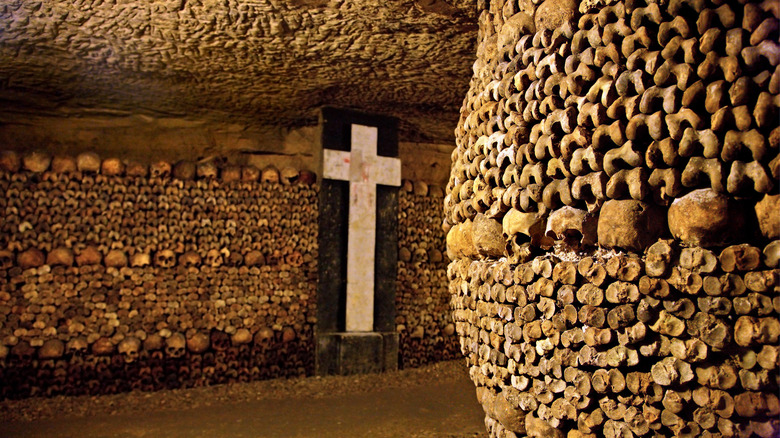
Pompeii. Ground Zero. The Colosseum. Auschwitz. Civil War Trail. Chernobyl. If you've visited any of these places, you might be considered a "dark" tourist — not a voyeur or sadist. A dark tourist.
While "dark tourism" means different things to different people, let's define the cultural nuance as follows: Dark tourism is visiting places associated with death and human tragedy. Full stop. Some make distinctions regarding recency consideration, but even that is open to interpretation.
Of course, visiting Pompeii and Ground Zero is different, but philosophically, both sites are associated with death and human tragedy. However, the visitor's motivation to visit these particular sites will be different. Unless a visitor knew someone in 79 A.D., their visit to Pompeii will be motivated by history and education. For someone visiting New York's Ground Zero, their motivation could range from first-person personal to culturally reflective to experiential education.
But what about visiting the funeral pyres in Varanasi, India, where Hindus cremate on the banks of the Ganges? That's not history. And it's culturally sacred. And the ceremonies continue day and night. It's not always easy for a person trying to see the world — both the good and the bad — to know what's appropriate and ethical. So, first, in an attempt to further round out the definition of dark tourism , let's try to understand why dark tourism is so popular, and explore how to be a responsible dark tourist.
Reasons why dark tourism is so popular
Dark tourism could most efficiently be defined as the act of visiting places associated with death and human tragedy — and that tragedy as an incident that caused or causes shared societal grief, regardless of cultural context or causality.
So, why is dark tourism so popular? According to a 2021 study published by the International Hospitality Review, researchers described the four primary motivations of someone to visit places associated with death and tragedy as: curiosity (a need to see to believe), education, an interest in personally connecting, and the place's sheer existence as a tourist attraction.
As stated, dark tourism means different things to different people, and when tourists visit dark tourism sites such as Ground Zero, the Auschwitz-Birkenau Memorial and Museum outside of Kraków, Poland , the Cambodian Killing Fields, the catacombs in Paris, or Hiroshima, their motivations will color their perception of the experience.
If learning is your motivation to visit these places, then a guided tour is definitely recommended. It's one thing to visit a notorious site, but if your goal is to learn, then a guide can provide essential grounding context, leading to a more engaging and thought-invoking experience. If personal connection is your goal, then a tour may still be warranted. However, most sensitive sites offer audio-guides and directed self-guided tours, allowing visitors the space and privacy for personal reflection and connection.
How to be a responsible dark tourist
Dark tourism isn't necessarily a question of morality. Just because you look at scars, doesn't mean you made them or you're happy they exist. Tragic events are historical, cultural, and societal scars. Unfortunately and realistically, these scars crisscross — and continue to crisscross — our little blue orb. Seeing these scars in person doesn't make you dark, and choosing not to see them while traveling doesn't make you naïve.
However, when visiting a sensitive place or participating in a sensitive experience, it's incredibly important to be mindful of this sensitivity. This is especially true if you're not personally connected to the event. Many visitors at these sites will be. You don't want to be the person snapping selfies next to a family recalling personal tragedy or reliving traumatic events.
For your own fulfillment and for respect of others, simply listening and absorbing may be the best approach. Usually, by doing these two things, your overall decorum should be in check. Being a responsible dark tourist simply means being respectful to the place, the event, and other visitors who may've been personally affected by the place and event.
- Account and Profile
- Newsletters & Alerts
- Gift Subscriptions
- Home Page U.S. & World | Regional
- White House
- Courts and Law
- Monkey Cage
- Fact Checker
- Post Politics Blog
- The Post's View
- Toles Cartoons
- Telnaes Animations
- Local Opinions
- Global Opinions
- Letters to the Editor
- All Opinions Are Local
- Erik Wemple
- The Plum Line
- PostPartisan
- DemocracyPost
- The WorldPost
- High School Sports
- College Sports
- College Basketball
- College Football
- D.C. Sports Bog
- Fancy Stats
- Fantasy Sports
- Public Safety
- Transportation
- Acts of Faith
- Health and Science
- National Security
- Investigations
- Morning Mix
- Post Nation
- The Americas
- Asia and Pacific
- Middle East
- On Leadership
- Personal Finance
- Energy and Environment
- On Small Business
- Capital Business
- Innovations
- Arts and Entertainment
- Carolyn Hax
- Voraciously
- Home and Garden
- Inspired Life
- On Parenting
- Reliable Source
- The Intersect
- Comic Riffs
- Going Out Guide
- Puzzles and Games
- Theater and Dance
- Restaurants
- Bars & Clubs
- Made by History
- PostEverything
- Entertainment
- Popular Video
- Can He Do That?
- Capital Weather Gang
- Constitutional
- The Daily 202's Big Idea
- Letters From War
- Presidential
- Washington Post Live
- Where We Live
- Recently Sold Homes
- Classifieds
- WP BrandStudio
- washingtonpost.com
- 1996-2018 The Washington Post
- Policies and Standards
- Terms of Service
- Privacy Policy
- Submissions and Discussion Policy
- RSS Terms of Service

Dark tourism, explained
Why visitors flock to sites of tragedy.

Every year, millions of tourists around the world venture to some of the unhappiest places on Earth: sites of atrocities, accidents, natural disasters or infamous death. From Auschwitz to Chernobyl, Gettysburg, the site of the Kennedy assassination and the 9/11 Memorial in New York, visitors are making the worst parts of history a piece of their vacation, if not the entire point.
Experts call the phenomenon dark tourism, and they say it has a long tradition. Dark tourism refers to visiting places where some of the darkest events of human history have unfolded. That can include genocide, assassination, incarceration, ethnic cleansing, war or disaster — either natural or accidental. Some might associate the idea with ghost stories and scares, but those who study the practice say it’s unrelated to fear or supernatural elements.
“It’s not a new phenomenon,” says J. John Lennon, a professor of tourism at Glasgow Caledonian University, in Scotland, who coined the term with a colleague in 1996. “There’s evidence that dark tourism goes back to the Battle of Waterloo where people watched from their carriages the battle taking place.”

The hit US drama "Chernobyl" brought a new generation of tourists to the nuclear disaster zone. (Genya Savilov/AFP via Getty Images)
That was in 1815, but he cites an even longer-ago example: crowds gathering to watch public hangings in London in the 16th century. Those are relatively modern compared with the bloody spectacles that unfolded in the Colosseum in Rome.
There aren’t official statistics on how many people participate in dark tourism every year or whether that number is on the rise. An online travel guide run by an enthusiast, Dark-Tourism.com , includes almost 900 places in 112 countries.
But there’s no question the phenomenon is becoming more visible, in part thanks to the Netflix series “Dark Tourist” that was released last year. And popular culture is fueling more visitation to some well-known sites: After the HBO miniseries “Chernobyl,” about the 1986 power plant explosion, came out this spring, travel companies that bring people to the area said they saw a visitor increase of 30 to 40 percent. Ukraine’s government has since declared its intention to make the Chernobyl Exclusion Zone an official tourist spot, despite lingering radiation.
[How to navigate the etiquette of dark tourism]
Philip Stone, executive director of the Institute for Dark Tourism Research at the University of Central Lancashire, in England, says anecdotally that he sees the appetite for such destinations growing.
“I think, for political reasons or cultural reasons, we are turning to the visitor economy to remember aspects of death and dying, disaster,” he says. “There is a kind of memorial mania going on. You could call that growth in dark tourism.”

(Illustrations by Laura Perez for The Washington Post)
Why are tourists so enamored with places that are, as Lennon puts it, “synonymous with the darkest periods of human history?” Academics who study the practice say it’s human nature.
[Ukraine wants Chernobyl to be a tourist trap. But scientists warn: Don’t kick up dust.]
“We’ve just got this cultural fascination with the darker side of history; most history is dark,” Stone says. “I think when we go to these places, we see not strangers, but often we see ourselves and perhaps what we might do in those circumstances.”
“When we go to these places, we see not strangers, but often we see ourselves and perhaps what we might do in those circumstances.”
Philip Stone, executive director, Institute for Dark Tourism Research at the University of Central Lancashire
There is no one type of traveler who engages in dark tourism: It could be a history buff who takes the family on a road trip to Civil War battlefields, a backpacker who treks to the Colosseum in Rome, or a tourist who seeks out the near-abandoned areas near the Fukushima Daiichi Nuclear Power Plant disaster, in 2011, in Japan.

Visitors walk between barbed wire fences at the Auschwitz I memorial concentration camp site in Oswiecim, Poland. (Sean Gallup/Getty Images)
Those who are most familiar with the phenomenon do not condemn it. In fact, they argue that the most meaningful dark-tourism sites can help visitors understand the present and be more thoughtful about the future.
“These are important sites that tell us a lot about what it is to be human,” says Lennon, the tourism professor. “I think they’re important places for us to reflect on and try to better understand the evil that we’re capable of.”
There are even efforts underway to research the way children experience dark tourism, a joint project between the Institute for Dark Tourism Research and the University of Pittsburgh.
Mary Margaret Kerr, a professor of education and psychiatry at the University of Pittsburgh, says the idea came about when the National Park Service asked her to help create a team to design children’s materials for families who visit the memorial to United Airlines Flight 93, which was hijacked on Sept. 11, 2001, and crashed in a field in Pennsylvania.
Her research team now includes middle-school students who have studied how their peers interact with the National 9/11 Pentagon Memorial, in Washington, or the site of the Johnstown flood, in Pennsylvania, which killed more than 2,200 in 1889.

(Illustration by Laura Perez for The Washington Post)
“We wouldn’t want families to stop traveling, and adults want to see these places for very good reasons,” Kerr says. “It’s not so much making the decision for parents whether you take the children or not, but what are the appropriate safeguards."
She said the goal is to provide appropriate safeguards and ways to experience a site, even for children too young to grasp the history, “so the family can be there together, but each member of the family can take meaning that works out for them at their age and stage.”
As more sites with dark histories become popular spots — even part of organized tour packages — experts say there is a risk that they could become exploited, used to sell tchotchkes or placed as backdrops for unseemly photos.
“It does kind of invite that passive behavior — let’s call it that touristy behavior — that might be out of place,” Stone says.

Visitors look at the bodies of eruption victims exposed in the ruins of ancient Pompeii. (Mario Laporta/AFP via Getty Images)
Bad conduct by tourists at sensitive sites — smiling selfies at concentration camps, for example — has been widely shunned on social media. The online Dark-Tourism.com travel guide cautions against such behavior, as well as the ethically questionable “voyeurism” of visiting an ongoing or very recent tragedy to gape.
“These are important sites that tell us a lot about what it is to be human. I think they’re important places for us to reflect on and try to better understand the evil that we’re capable of.”
J. John Lennon, tourism professor at Glasgow Caledonian University
“What IS endorsed here is respectful and enlightened touristic engagement with contemporary history, and its dark sites/sides, in a sober, educational and non-sensationalist manner,” the site says .
Lennon says he’s sometimes “dumbfounded” by some of the behavior that gets publicized, but he declines to say what the right or wrong way is for tourists to behave. Overall, he says, he still hopes that by visiting places with dark histories, people are becoming better informed about atrocities like racial and ethnic cleansing.
“I’m heartened by the fact that they choose to try to understand this difficult past,” Lennon says.
Berlin’s Holocaust memorial is ‘not a place for fun selfies’
Will gun violence lead to a growing ‘dark tourism’ industry?
A selfie ban in the Czech Republic is the latest effort to combat bad tourist behavior
Hannah Sampson
Hannah Sampson is a staff writer at The Washington Post for By The Way, where she reports on travel news.
More stories
Airline helpfully tweets advice on where on a plane you are least likely to die in a crash
Fatality rates are usually not what customers want to hear about, but one carrier's regional Twitter account went there anyway.


Can tourism ‘pledges’ help keep visitors on their best behavior?
Destinations across the world are turning to a new tool: a morality-based honor code, largely without concrete punishments.

Exploring the Potential of Dark Tourism in the Aftermath of Tropical Cyclone Idai in Chimanimani
- First Online: 25 May 2021
Cite this chapter

- Godwell Nhamo 3 &
- David Chikodzi 3
Part of the book series: Sustainable Development Goals Series ((SDGS))
287 Accesses
Although places of human-induced death, suffering and torture have aroused great interest in terms of their local, national and global following, a new wave of natural disasters has fuelled and re-ignited research interest in dark tourism. The chapter investigates the potential of dark tourism at the epicentre of Tropical Cyclone Idai that devastated Zimbabwe in March 2019. A household questionnaire survey, interviews and field observations were the main methods applied to generate data. The GIS and document analysis were methods applied to analyse data. Findings are that the dark tourism idea found resonance in government as Cyclone Idai was the worst natural disaster the country ever witnessed. The authorities have decided to put up memorial sites in the three most affected areas of Ngangu, Machongwe and Kopa, all of them in the Chimanimani district. This new development has the potential to attract special tourists in the niche of dark tourism, although some of the artefacts of interest like the ropes that were used to save lives in Kopa were removed from the site. Furthermore, communities that had struggled for years to get quarry stone for construction were mining these at potential dark tourism sites. Hence, the value of the sites was constantly being degraded. Among some of the stones that were at risk from quarrying were those marked as potential sites for the missing dead. The paper concludes that there is a potential for dark tourism in Zimbabwe and steps need to be taken to realise and promote it.
This is a preview of subscription content, log in via an institution to check access.
Access this chapter
- Available as PDF
- Read on any device
- Instant download
- Own it forever
- Available as EPUB and PDF
- Compact, lightweight edition
- Dispatched in 3 to 5 business days
- Free shipping worldwide - see info
- Durable hardcover edition
Tax calculation will be finalised at checkout
Purchases are for personal use only
Institutional subscriptions
Becker, A. (2019). Dark tourism: The “heritagization” of sites of suffering, with an emphasis on memorials of the genocide perpetrated against the Tutsi of Rwanda. International Review of the Red Cross. 101(1), 317–331. https://doi.org/10.1017/S181638311900016X .
Article Google Scholar
Boateng, H., Okoe, A.F., Hinson, R.E. (2018). Dark tourism: Exploring tourist's experience at the Cape Coast Castle, Ghana. Tourism Management Perspectives, 27, 104-110. https://doi.org/10.1016/j.tmp.2018.05.004 .
Bright, C.F., Alderman, D.H., Butler, D.L. (2018). Tourist plantation owners and slavery: a complex relationship, Current Issues in Tourism, 21(15), 1743-1760, https://doi.org/10.1080/13683500.2016.1190692 .
Collins-Kreiner, N. (2016). Dark tourism as/is pilgrimage, Current Issues in Tourism, 19(12), 1185-1189, https://doi.org/10.1080/13683500.2015.1078299 .
Everill, B. (2017). All the baubles that they needed: Industriousness and slavery in Saint-Louis and Goree. Early American Studies, 15(4), 714–739.
Foley, M. & Lennon, J.J. (1996). JFK and dark tourism: A fascination with assassination, International Journal of Heritage Studies, 2(4), 198-211. https://doi.org/10.1080/13527259608722175 .
Fonseca, A.P., Seabra, C., Silva, C. (2016). Dark Tourism: Concepts, Typologies and Sites. Journal of Tourism Research & Hospitality, S2, 2-6. https://doi.org/10.4172/2324-8807.S2-002 .
González-Tennant, E. (2013). New Heritage and Dark Tourism: A Mixed Methods Approach to Social Justice in Rosewood, Florida. Heritage & society, 6(1), 62–88.
Hartmann, R., Lennon, J., Reynolds, D.P., Rice, A., Rosenbaum, A.T., Stone, P.R. (2018). The history of dark tourism, Journal of Tourism History, 10(3), 269–295, https://doi.org/10.1080/1755182X.2018.1545394 .
Kidron, C.A. (2013). Being there together: Dark family tourism and the emotive experience of co-presence in the Holocaust past. Annals of Tourism Research, 41, 175–194. https://doi.org/10.1016/j.annals.2012.12.009 .
Kim, S. & Butler, G. (2015). Local community perspectives towards dark tourism development: The case of Snowtown, South Australia, Journal of Tourism and Cultural Change, 13(1), 78-89, https://doi.org/10.1080/14766825.2014.918621 .
Kumar, S., Shekhar, R., Attri, K. (2018). Exploration of Potential for Development of Dark Tourism in India. International Journal of 360 Management Review, 6(2), 2320–7132.
Google Scholar
Kunwar, R.R. & Karki, N. (2019). Dark tourism: understanding the concept and recognising the values. Journal of APF Command and Staff College, 42–49.
Kunwar, R.R., Aryal, D.R., Karki, N. (2019). Dark Tourism: A Preliminary Study of Barpak and Langtang as Seismic Memorial Sites of Nepal. Journal of Tourism & Hospitality Education, 9, 88–136.
Maodza, T. (2019). VP Chiwenga commissions Bailey bridges at Kopa. Available at: https://www.herald.co.zw/vp-chiwenga-commissions-bailey-bridges-at-kopa/ (Retrieved 9 December 2019)
McDaniel, K.N. (2019). The Palgrave handbook of dark tourism studies, Journal of Tourism History, 11(1), 93-95, https://doi.org/10.1080/1755182X.2019.1585510 .
Miles, S. (2014). Battlefield sites as dark tourism attractions: an analysis of experience, Journal of Heritage Tourism, 9(2), 134-147, https://doi.org/10.1080/1743873X.2013.871017 .
Molokáčová, L. & Molokáč, Š. (2011). New phenomenon – Dark tourism. Acta Geoturistica, 2(1), 1–7.
Murwira, Z. (2019). President honours Cyclone Idai heroes. Retrieved at https://www.herald.co.zw/president-honours-cyclone-idai-heroes/ (Accessed 20 December 2019).
Nawijn, J. & Biran, A. (2019) Negative emotions in tourism: a meaningful analysis, Current Issues in Tourism, 22(19): 2386–2398, https://doi.org/10.1080/13683500.2018.1451495 .
Nhlabathi, S.S. & Maharaj, B. (2019). The dark tourism discipline: a creative brand in a competitive academic environment? Current Issues in Tourism, https://doi.org/10.1080/13683500.2019.1636770 .
Parry, T.D. (2018). What is Africa to me’ now? African-American heritage tourism in Senegambia, Journal of Contemporary African Studies, 36(2), 245–263, https://doi.org/10.1080/02589001.2017.1387236 .
Potts, T. J. (2012). ‘Dark tourism’ and the ‘kitschification’ of 9/11. Tourist Studies, 12(3), 232–249. https://doi.org/10.1177/1468797612461083 .
Pratt, S., Tolkach, D., Kirillova, K. (2019). Torusim & death. Annals of Tourism Research 78: 102758. https://doi.org/10.1016/j.annals.2019.102758 .
Seaton, P. (2019a). Islands of “Dark” and “Light/Lite”. Japan Review, 33 (Special Issue: War, Tourism, and Modern Japan), 299-328. : https://www.jstor.org/stable/10.2307/26652985 .
Small, S. (2013). Still Back of the Big House: Slave Cabins and Slavery in Southern Heritage Tourism, Tourism Geographies, 15(3), 405–423, https://doi.org/10.1080/14616688.2012.723042 .
Stone, P.R. (2006). A dark tourism spectrum: Towards a typology of death and macabre related tourist sites, attractions and exhibitions. Tourism, 54(2), 145–160.
Stone, P.R. & Sharpley, R. (2008). Consuming dark tourism: A thanatological perspective. Annals of Tourism Research, 35(2), 574–595. https://doi.org/10.1016/j.annals.2008.02.003 .
Thiaw, I. & Wait, G. (2018). Presenting Archaeology and Heritage at a UNESCO World Heritage Site: Gorée Island, Senegal. Advances in Archaeological Practice 6(3), 238–247, https://doi.org/10.1017/aap.2018.19 .
Wang, J. & Luo, X. (2018). Resident perception of dark tourism impact: the case of Beichuan County, China, Journal of Tourism and Cultural Change, 16(5), 463–481, https://doi.org/10.1080/14766825.2017.1345918 .
Wright, D. & Sharpley, R. (2018). Local community perceptions of disaster tourism: the case of L'Aquila, Italy, Current Issues in Tourism, 21(14), 1569–1585, https://doi.org/10.1080/13683500.2016.1157141 .
Zavar, E.M. & Schumann III, R.L. (2019). Patterns of disaster commemoration in long-term recovery. Geographical Review, 109(2), 157–179, https://doi.org/10.1111/gere.12316 .
Download references
Author information
Authors and affiliations.
Institute for Corporate Citizenship, University of South Africa, Pretoria, South Africa
Godwell Nhamo & David Chikodzi
You can also search for this author in PubMed Google Scholar
Rights and permissions
Reprints and permissions
Copyright information
© 2021 The Author(s), under exclusive license to Springer Nature Switzerland AG
About this chapter
Nhamo, G., Chikodzi, D. (2021). Exploring the Potential of Dark Tourism in the Aftermath of Tropical Cyclone Idai in Chimanimani. In: Cyclones in Southern Africa. Sustainable Development Goals Series. Springer, Cham. https://doi.org/10.1007/978-3-030-72393-4_13
Download citation
DOI : https://doi.org/10.1007/978-3-030-72393-4_13
Published : 25 May 2021
Publisher Name : Springer, Cham
Print ISBN : 978-3-030-72392-7
Online ISBN : 978-3-030-72393-4
eBook Packages : Earth and Environmental Science Earth and Environmental Science (R0)
Share this chapter
Anyone you share the following link with will be able to read this content:
Sorry, a shareable link is not currently available for this article.
Provided by the Springer Nature SharedIt content-sharing initiative
- Publish with us
Policies and ethics
- Find a journal
- Track your research
Dark Tourism: What It Is And How To Do It Respectfully
Dark tourism is the newest niche of travel and while it's thrilling for some, it should also be done respectfully.
The internet has made it easy for knowledge seekers to learn about the world in ways they never did while growing up. Pictures absent from history books are only an image search away, and along with them are the stories that highlight a universal truth—life can be heavy, grim, and disheartening. While it can be difficult to come face to face with the darker sides of history, it's as essential to acknowledge the dismal happenings that shape reality as it is to recognize the immense beauty of our planet.
The Information Age has prompted an increased interest in dark tourism. Travelers from all over the world are trading paradisal getaways for somber reflection in places associated with natural disasters, death, and destruction. Venture down the rabbit hole as we explore what dark tourism is, ponder its recent increased interest, and go over some guidelines to participate in the travel phenomenon respectfully.
10 What Is Dark Tourism?
The term 'dark tourism' (also called 'black tourism,' 'grief tourism,' and 'thanatourism') was coined in 1996 by Glasgow Caledonian University professors J. John Lennon and Malcolm Foley. Generally, the phrase refers to visiting a place associated with death, destruction, or tragedy. This includes but is not limited to: natural disaster, genocide, war, slavery, suffering, and violence.
9 Examples Of Dark Tourist Destinations
Because human history is filled with darkness, thousands of locations across the globe are considered dark tourism destinations. Some have been historically popular attractions. Pompeii, an ancient Roman town blanketed in several feet of ashes by the eruption of Mount Vesuvius , has attracted visitors for hundreds of years. One of the most famous dark tourism spots is Alcatraz, a prison island off the San Francisco Bay in California that detained the most dangerous criminals of the early 20th-century.
Related: The Paris Catacombs Are The Final Resting Places Of Six Million People, And You Can Visit Them
8 Types of Dark Tourism
The umbrella term 'dark tourism' can be broken down into subcategories, each associated with its own brand of gloom:
- Cold War tourism
- Battlefield tourism
- Grave tourism
- Nuclear tourism
- Prison tourism
- Holocaust tourism
- Narco tourism
7 Television Shows Are Spotlighting Dark Tourism Hot Spots
Whether they know it or not, most travelers have a bit of an interest in dark tourism. History buffs flock to the bloodiest battlefields of all time to get a sense of the soldiers' wartime surroundings. People head to memorial walls to search for the names of family members who lost their lives during dark moments in history. Although there has always been a curiosity for the macabre, many modern television shows have focused on historical tragedies and thus increased interest in dark tourism for viewers.
6 Dark Tourism In Pop Culture
HBO's award-winning miniseries Chernobyl masterfully captured the events leading up to Ukraine's nuclear disaster and the effects on life after the accident. Netflix's Dark Tourist follows journalist David Farrier to gloomy locations around the world, where he does his best to understand how these places came to be and what they say about society as a whole.
Related: 10 Narcos-Related Tourist Spots To Visit In Colombia
5 A Sign Of The Times?
It would be foolish not to recognize the quiet hum of darkness currently vibrating across the planet. Climate reports warn of impending large-scale food and water shortages punctuated by natural disasters that will devastate entire regions. Civil unrest and political corruption are on display in even the most progressive countries. Human beings from all walks of life are questioning the income inequalities that make it difficult for hardworking people to get ahead. It seems impossible to get away from, and it's become all too easy to spend hours doom-scrolling the latest bad news.
4 Dark Tourism And Its Influence On Modern Society
Dark tourism arguably makes the scariest parts of current reality a little easier to swallow. There has been darkness in the past, there is darkness currently, and there will be darkness in the future. Through it all, humans have persevered, and something is comforting in that fact. Aside from the unique and fascinating histories of these places, there's an underlying whisper that maybe, hopefully, everything is going to be alright.
3 Finding A Light Through The Dark
Tragedies have a strange way of uniting people. Following the September 11th attacks, a thread of fellowship connected heartbroken citizens from all walks of life. Unimportant disagreements dissolved as people were reminded that the most important thing we can do is be there for one another. Every year, millions of people visit the World Trade Center Memorial in New York City, reflecting in a spot once buried by rubble and clouded by smoke.
2 Don't Be That Person
Dark tourism is not without its critics, who suggest the practice can be voyeuristic, exploitative, or just generally in bad taste. However, these places have the unique ability to put tragedy into perspective, break barriers of prejudice, and teach visitors how to ensure that certain atrocities never happen again. Because of this, it's crucial to honor the dead and keep visits respectful. While visiting a dark tourist destination, it is never okay to joke or make light of what happened there. Empathy is of the utmost importance, and visitors should always seek to understand in a respectful and non-exploitative way.
1 What One Should Take Away From Dark Tourism
It is inappropriate to have photoshoots highlighting the visitor rather than the place itself. Dark tourism should never be a 'likes' competition. Instead, visits should be used as prime opportunities for deep reflection and a better understanding of the ways that tragedy shapes history on a grand scale. It seems that dark tourism is here to stay, and the best we can do to honor these places is to treat them with the same respect we would if our loved ones were a part of the story.
Next: Hiroshima Peace Park Was Born Of Tragedy, But Stands For Strength: These Are The Main Features Visitors Will See There

A Traveler's Guide to Dark Tourism
Exploring the world's dark & unusual travel destinations.

Spac Prison: Albania’s Dark Tourism Destination Reveals a Haunting History
Nestled within the picturesque mountains of Albania, SPAÇ Prison stands as a chilling reminder of the country’s tumultuous past. Once a site of political imprisonment and human suffering, this haunting location has become a dark tourism destination, attracting visitors prepared … Read More

Visiting Hartheim Castle Memorial Site (Austria)
As far as dark tourist destinations are concerned, there’s few more harrowing than Hartheim Castle. During WWII it was a Euthanasia Centre, a secret Nazi killing facility, and part of the Aktion T4 program. Here, German citizens tagged as mentally … Read More

Tsitsernakaberd Genocide Memorial & Museum (Yerevan)
For dark tourists in Yerevan, a trip to Tsitsernakaberd is a must. The Memorial and Armenian Genocide Museum provide a powerful insight into the country and its culture and of the darkest period in the nations’ relatively recent history. The … Read More

Visiting Cellular Jail, Port Blair – All You Need to Know
Cellular Jail in the Andaman Islands has a dark and significant history. During the many years of British rule, prisoners were forced into exile in this remote location. Known as the Kala Pani (Black Water in Hindi), Indian freedom fighters … Read More

Masada, Israel – 1st Century Fortress and Site of a Mass Jewish Suicide
“Masada shall not fall again.” The oath that soldiers take when inducted into the Israeli Defence Forces ends with this line. It is connected to a siege that took place almost 2000 years ago. The 1st-century fortress at Masada was … Read More

KGB Cells Museum – Tartu, Estonia
In the center of the Estonian city of Tartu stands an unassuming building that once held a dark secret. During the first Soviet occupation of the country between 1940 and 1954, the basement was home to the KGB. Operating covertly … Read More

North Brother Island – Abandoned Quarantine Facility in New York
North Brother Island, located on the East River between the Bronx and Riker’s Island in New York, is a place with a dark history. Not only is the island home to the worst loss of life in New York’s history … Read More

Ruddock, Louisiana – Entire Town Destroyed by Hurricane
At the turn of the 20th century, Ruddock in Louisiana was a bustling community, located on an isthmus between Lake Maurepas and Lake Pontchartrain, the town was connected by the railroads with a train coming through daily. At the height … Read More

Vorkuta – Russia’s Dying City Above the Arctic Circle
Just over 90 miles north of the Arctic Circle and 40 hours by train from Moscow, sits the once-bustling coal-mining city of Vorkuta, Russia. Built by gulag inmates during Stalin’s big purge in the 1930s, this desolate region on the … Read More

Fleury-devant-douaumont – A Village that Died for France
During World War One, Fleury-devant-douaumont became known as one of the villages that died for France. Caught in the midst of The Battle of Verdun, (one of the longest and fiercest artillery battles of the Great War), French and German … Read More

Reggane and In Ekker – French Nuclear Test Sites, Algeria
Reggane and In Ekker were once nuclear test sites in Algeria. It was here that the French experimented with their atomic arsenal in the 1960s. Thirteen underground nuclear detonations were carried out at the In Ekker site. The reckless nature … Read More

Kadykchan – Abandoned Soviet Mining Town
Kadykchan is located at the eastern extremity of Russia in the Kolyma region of Siberia, an area renowned for the harshness of the climate. This part of Siberia is known for something else too, the devastating brutality of its Gulags. … Read More

Inside Saint Elmo, Colorado’s Best Preserved Ghost Town
St. Elmo, is currently the best-preserved ghost town in Colorado. This former gold mining camp in Chaffee County lies in the heart of the Sawatch Range. The entire district was placed on the National Register of Historic Places in 1979, … Read More

A Trip to Tinian Island – WWII Relics in the Pacific
Despite its remote location in the Pacific, Tinian is slowly becoming more popular with tourists, especially dark ones that are interested in Pacific WWII History. There are a number of reasons why. Not only did the island become one of … Read More

The Ruins of Villa Epecuén, Argentina – A Resort Town Submerged
Villa Epecuén was once a bustling tourist town along the shore of Lago Epecuen. The salt lake, some 600 kilometers away from Buenos Aires was a popular holiday spot for many decades in the 20th century. People would flock from … Read More

Visiting Nauru – An Island From Boom To Bust
Nauru has had a troubled history, passed from one empire to the next. As one of the three big “phosphate rocks” of the Pacific, (Banaba in Kiribati and Makatea in French Polynesia being the other two), the island was a … Read More

The Buried Village of Te Wairoa – Dark Tourism in New Zealand
On June 10, 1889, New Zealand’s deadliest volcanic eruption devastated the surrounding landscape and killed over 120 people. The villagers around Mount Tarawera on the on North Island did not stand a chance as boiling mud and hot springs tore … Read More

Port Royal – Sunken Pirate City, Jamaica
Port Royal, Jamaica was once known as “the most wicked and sinful city in the world”. Founded in 1494 by the Spanish, the enclave positioned on the mouth of what is now called Kingston Harbour, was the center of shipping … Read More

Bunker Valentin, Bremen – Nazi U-Boat Facility
Bunker Valentin was the largest fortified U-boat facility in Germany during WWII. Built to produce submarines on a grand scale for the Nazi war effort, more than 10,000 forced laborers were used in the construction of this gigantic bunker, support … Read More

Chagan Nuclear Tests, Crater Lake & Ghost Town – Kazakhstan
During the Cold War, the Soviets couldn’t get enough of blowing up nuclear weapons in northeastern Kazakhstan. The tests were not always with the intent to one day nuke the USA, however. Conducted by the military under the banner of … Read More
Privacy Overview
Privacy Policy - Contact - Terms and Conditions
- Harper's Bazaar
- Aaj Tak Campus
- India Today
- Business Today
- Cosmopolitan
- Reader’s Digest
- IndiaTodayNE
- Brides Today
Heard of dark tourism? Here are 10 places to visit for it
From poignant memorials to haunting historical sites, each place tells a story of tragedy and resilience..
Ever heard of dark tourism? No, it's not your usual sun and sand vacation or posing in front of iconic landmarks. We're talking about diving deep into the mysterious and somewhat eerie pages of history, exploring sites linked to tragedy, morbidity, and death! Sounds unsettling, right? But it's way more fascinating than your average beach trip.
So, what's the deal with dark tourism? Well, imagine a world where your travel itinerary goes beyond the ordinary and into the realms of the bizarre. That's where dark tourism comes in. It's not about your typical touristy stuff; it's about delving into the darker side of human history, where stories are rooted in tragedy, conflict, and catastrophe.
Now, some might say, "Why on earth would anyone want to visit places associated with death and gloom?" But hold on! There's a method to the madness. Dark tourism isn't just about embracing the macabre; it's a testament to our inherent curiosity. It's about getting in touch with your humanity in a lot of ways. We're not avoiding history; we're diving headfirst into it, trying to make sense of the hardships and losses that shaped our past.
Ready for it? Here are our 10 top picks.
The Catacombs of Paris, France Beneath the romantic streets of Paris lies a macabre world—the Catacombs, where the bones of millions are arranged in bizarre patterns. In the 18th century, Paris grappled with a significant public health crisis, with local cemeteries became overcrowded, leading to improper disposal of corpses and the subsequent spread of diseases. To address this pressing issue, the city opted to repurpose its extensive subterranean Lutetian limestone quarries, transforming them into expansive underground ossuaries.

Auschwitz Birkenau, Poland Nestled in the quiet countryside of Poland, Auschwitz-Birkenau stands as a haunting site to one of the darkest chapters in human history—the most extensive Nazi concentration camp during World War II, which tragically became a site of mass genocide, claiming the lives of more than 1.1 million people, with a staggering 9,60,000 of them being Jews. Visitors come to pay their respects, learn about the atrocities committed, and reflect on the importance of preserving human rights and preventing such horrors from happening again.
View this post on Instagram A post shared by Auschwitz - Birkenau Oświęcim (@auschwitz_birkenau)
Chernobyl, Ukraine On April 26, 1986, an explosion occurred in nuclear reactor number four at the Chernobyl Nuclear Power Plant in Pripyat, Ukraine.This catastrophic event rendered the area uninhabitable, leaving it in ruins. It has become a unique destination for those interested in the intersection of history and environmental impact. Estimates by scientists suggest that the land around Chernobyl may need as long as 20,000 years for complete recovery from the effects of radioactive damage. Nearly 37 years later, evolving into a deserted town with forsaken schools, hospitals, and apartment buildings, the Chernobyl vicinity has become a magnet for thousands of visitors.
Tours take visitors through abandoned towns and the decaying remnants of a once-thriving community, offering a somber reminder of the consequences of nuclear technology gone awry.
View this post on Instagram A post shared by Keisuke Shingu | Based in Fukuoka (@kei.photography)
Ground Zero, USA The term "Ground Zero '' originally referred to the point on the Earth's surface directly below or above an exploding nuclear bomb. For this one, it is the site of the September 11, 2001 terrorist attack, which serves as a poignant tribute to the nearly 3,000 victims who lost their lives during the attacks. The memorial features twin reflecting pools set within the footprints of the original towers, inscribed with the names of those who perished. It draws visitors seeking to pay tribute to the lives lost and understand the profound impact of the event on global history.
View this post on Instagram A post shared by Pâmella Miranda • Trips da Pam (@tripsdapam)
Pompeii, Italy Pompeii, Italy, stands as a captivating dark tourist site, frozen in time by the catastrophic eruption of Mount Vesuvius in 79 AD. The ancient city was buried under layers of ash and pumice, preserving its streets, buildings, and inhabitants in an eerie tableau. The plaster casts of citizens, captured in their final moments of agony, add a hauntingly human dimension to the tragedy that befell Pompeii. Several guided tours and excursions are available for tourists, providing access to historical sites surrounding the remarkably preserved ruins like Pompeii Archaeological Park and the forum that are still frozen in time.
View this post on Instagram A post shared by Morbid Anatomy (@morbidanatomy)
Hiroshima Peace Memorial, Japan It opened in August 1955, The Hiroshima Peace Memorial, also known as the Atomic Bomb Dome, stands as a symbol of peace and a reminder of the devastating impact of nuclear warfare. Visitors to the Hiroshima Peace Memorial can explore the museum, which houses artefacts, personal belongings, and first hand accounts of the atomic bombing. Every year around 1 million people visit this site.
View this post on Instagram A post shared by mao onodera (@tsumugi9312)
Robben Island, South Africa Robben Island, situated off the coast of Cape Town, South Africa, once a notorious political prison, held Nelson Mandela and other anti-apartheid activists during South Africa's dark history of racial segregation. Political prisoners endured harsh conditions, forced labor, and systematic oppression. Today, it serves as a museum and a UNESCO World Heritage Site, providing insight into the struggles for freedom and equality.
View this post on Instagram A post shared by Amanda White (@amandalikestheworld)
Tuol Sleng Genocide Museum, Cambodia It is a haunting site that bears witness to the atrocities committed during the Khmer Rouge regime from 1975 to 1979. Formerly a high school turned into a prison, the Tuol Sleng Genocide Museum stands as a stark reminder of Cambodia's painful history, showcasing the inhumane treatment suffered by an estimated 17,000 people who passed through its gates. The museum also displays the crude instruments of torture and the grim cells where detainees were held in appalling conditions.
View this post on Instagram A post shared by Tuol Sleng Genocide Museum (@tuolslenggenocidemseum)
Jallianwala Bagh The tragic incident took place on April 13, 1919, as the sun dipped below the horizon, Brigadier General Reginald Dyer ordered British troops to open fire on a gathering of unarmed Indian civilians who had assembled for a peaceful protest against the repressive Rowlatt Act. The echoes of gunfire in the enclosed garden created a macabre symphony, resulting in the loss of hundreds of lives and leaving thousands injured.
View this post on Instagram A post shared by Amit Panchal (@amithpanchal)
The Killing Fields, Cambodia The Killing Fields, a series of sites where mass executions occurred during the Khmer Rouge regime, serve as a stark reminder of Cambodia's tragic history. It offers an immersive experience, with audio guides providing firsthand accounts from survivors and historical context. The remnants of clothing and bone fragments that occasionally surface from the ground serve as haunting reminders of the human tragedy that unfolded here.
View this post on Instagram A post shared by @citrachristina
Dark tourism, though unconventional, offers a unique lens through which travelers can explore the complexities of human history. These 10 destinations represent just a fraction of the many sites around the world that attract visitors seeking to engage with the darker chapters of our collective past.
Feature image: @lyndseyfaye/instagram
The catacombs of paris image: @undeadforeststudios/instagram

5 under-the-radar European destinations to visit this summer

I can’t stop talking about my tongue scraper

Platinum love bands: A timeless trend beloved by celebrities

All the trendy handbags for spring-summer ’24 you need to know about now

6 homegrown brands for all your linen needs this season

5 ways to style a white dress and pieces worth adding to your wardrobe

Margot Robbie is making a Monopoly movie and here's everything we know

30 cute almond nail designs to try now

7 facial mists that will keep your skin hydrated all summer long

Zendaya exudes some serious “rich mom” energy in opulent tennis whites
Embracing ‘virtual dark tourism’ could help heritage sites at risk of degradation – expert explains
Assistant Professor in Digital Humanities, Trinity College Dublin
Disclosure statement
Nicole Basaraba does not work for, consult, own shares in or receive funding from any company or organisation that would benefit from this article, and has disclosed no relevant affiliations beyond their academic appointment.
Trinity College Dublin provides funding as a member of The Conversation UK.
View all partners
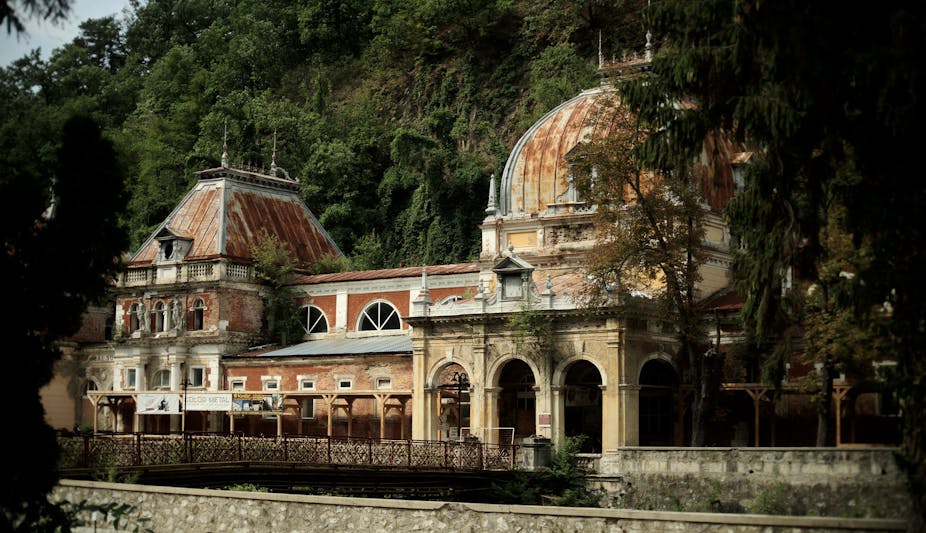
Do you believe in ghosts? If so, there is a whole genre of digital storytelling to explore on YouTube. My recent research (which identified more than 60 dedicated channels) has shown that there is a fast-growing audience on YouTube for paranormal investigations that are filmed like a virtual tour of a range of “dark” heritage sites – places with rumoured hauntings or a tragic history.
Dark tourism allows people to understand tragic events, and potentially experience a catharsis of emotions related to the deaths at a site or even help people respond to collective trauma. For example, memorials dedicated to COVID deaths have become a place for people to reflect.
The COVID lockdowns brought travel to a standstill. During this period, many museums around the world took the opportunity to create virtual tours, and many would-be tourists explored 360-degree street views that served as silent “virtual tours” .
Outside of museums, visitors also have an interest in learning about the history and stories at heritage sites which are places that contain cultural, historical or even natural significance. Commonly known heritage sites include the Unesco world heritage sites – and many nations have their own lists of heritage sites such as archaeological ruins, cathedrals or monasteries and national parks.
Dark tourism is considered a subset of heritage tourism, because many dark tourism sites are also heritage sites. For example, Leap Castle in Ireland is a heritage site with history dating back to the 1500s while also being renowned as one of the most haunted castles in Europe.
Many heritage sites are also currently at risk for a variety of reasons, including climate change, a lack of funding to maintain their infrastructural integrity, vandalism, or the impacts of mass tourism.
My paper argues that using the interest in virtual dark tourism could be one way for these heritage sites to mitigate some of these challenges.
Some people view this interest in dark sites as a kind of voyeurism and the ethics of monetising entry or tours at sites of death and tragedy have been questioned. Despite the controversies, dark tourism has a long history of attracting public interest and there are other benefits, too.
My primary case study, the YouTube channel Sam and Colby , has amassed more than 10 million subscribers and over 1 billion views.
These two US-based content creators have published hundreds of YouTube videos exploring haunted places, including infamous private homes. This includes locations such as The Conjuring House in the US which dates to circa 1736 (famous for its paranormal activity), multiple castles associated with dark stories like Bran Castle in Romania (the home of Dracula in Bram Stoker’s 1897 novel) and many hotels including the Grade II listed building, The Ancient Ram Inn in England, known as the most haunted building in England.
This style of digital storytelling combines typical YouTube content creation techniques, such as breaking the fourth wall (talking directly to the camera), handheld-style filming and comedic interludes to break the tension with conventions seen more in documentary films, such as b-roll (supplemental or alternative footage intercut with the main action) animations, dark lighting and music and a tour-guide style narrative arc .
Why take virtual dark tours?
Not all tourists interested in dark sites are willing to take the associated risks to their health and safety associated with exploring old buildings or to experience the potentially high levels of fear of physically visiting these haunted locations. Therein lies the appeal of a virtual dark tourism experience on YouTube.
For example, while the Museum of Partisan Glory in Odesa – an underground museum in Ukraine – is safe for visitors, paranormal YouTubers ventured deep into the former mining tunnels in 2021 escorted by a local guide despite the risks involved. The catacombs are largely unmapped and could result in explorers getting lost and there are precarious underground conditions.
Similarly, the Saratoga County Homestead (a former hospital opened in 1913 as a tuberculosis sanitarium that is now privately owned and attracts those who believe its haunted), was abandoned during the YouTubers’ 2021 paranormal investigation of the property. It was in a state of disrepair and could pose physical risks to visitor safety as well as charges of antisocial behaviour or illegal trespassing.
Most paranormal investigation teams on YouTube gain access to private properties with permission from the owners. Some explore abandoned buildings after dark without conducting paranormal investigations (this sub-genre of urban exploration is called urbex). Some paranormal investigation YouTube channels even have disclaimer statements noting that they do not illegally trespass and they advise viewers not to visit some of the more dangerous locations.
YouTubers are continuing to conduct paranormal investigations to challenge their own belief systems and fears, to better understand the history and happenings at dark sites (including heritage-listed places) and to share this with others through digital storytelling.
This genre has expanded to a network of at five to six paranormal investigation teams who are collaborating and producing similar virtual dark tours at a variety of locations across the globe. As the audience for this virtual dark tourism content continues to grow, heritage sites at risk may benefit from developing narrative-focused virtual tours or by partnering with influential YouTubers.

Looking for something good? Cut through the noise with a carefully curated selection of the latest releases, live events and exhibitions, straight to your inbox every fortnight, on Fridays. Sign up here .
- Virtual Tourism
- Dark tourism
- Give me perspective

Program Manager, Teaching & Learning Initiatives

Lecturer/Senior Lecturer, Earth System Science (School of Science)

Sydney Horizon Educators (Identified)

Deputy Social Media Producer

Associate Professor, Occupational Therapy

17 Must-Visit Dark Tourism Destinations Around the World
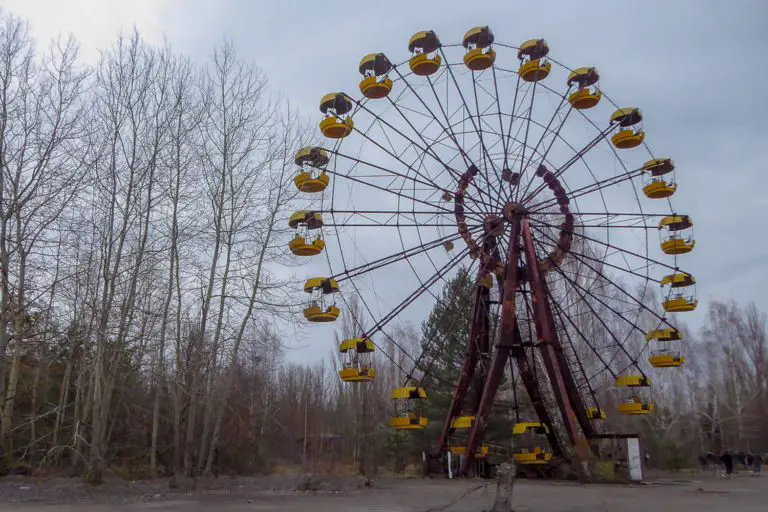
Dark Tourism destinations were once the remit of a select group of travellers. However, after the launch of popular Netflix show Dark Tourist, these attractions have hit the mainstream.
If you’re interested in the morbid and the macabre, look no further. After making several visits to dark history sites myself, I’ve teamed up with other travellers to bring you this list of dark tourism destinations all around the world.
Read more: (opens in new tab)
- What is Dark Tourism?
- Are Bolivia’s Mine Tours Ethical?
- Chernobyl Exclusion Zone Photographic Guide
17 Must-Visit Dark Tourism Destinations
1. chernobyl exclusion zone – kyiv, ukraine.
The abandoned amusement park in Pripyat is one of dark tourism’s crowning images. The haunting stills of the fairground that never heard the laughs of children hang in modern consciousness, a symbol of tragic loss and a warning of the mistakes men can make.
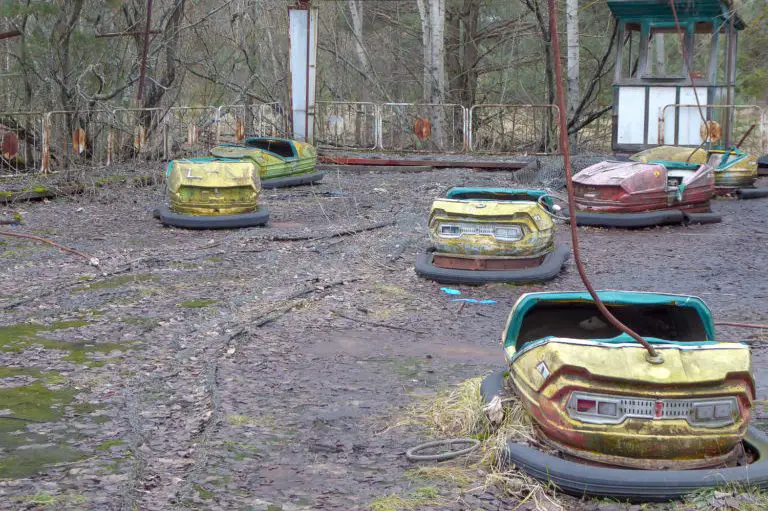
In 1986, the nuclear reactor at the Chernobyl power plant exploded, causing the worst nuclear accident in the world’s history. The effects were huge; people were forced to evacuate their homes and the surrounding areas became a hotbed of radiation. It was predicted that never again in our lifetime, would Chernobyl be inhabited by anything living.
Surprisingly, the Chernobyl exclusion zone has recovered quicker than was ever predicted. Although there are still risks with spending long periods in the exclusion zone, wild animals have returned and are thriving. Despite its recovery, Chernobyl acts as a very sobering reminder of the damage humanity can do without intention.
2. Sucre Cemetery – Sucre, Bolivia
Sucre Cemetery is an unlikely attraction in Bolivia’s capital. Regularly appearing on tourist maps, it is a peaceful place which attracts visitors who come to see how the Bolivians handle death and all that comes after.
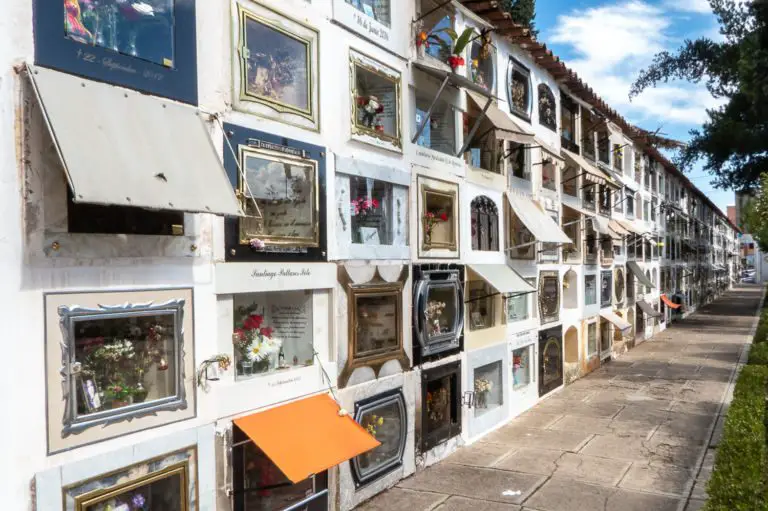
Also frequently visited by locals, this cemetery is a surprisingly popular spot for catching up with friends, studying and paying homage to the dearly departed.
Unlike other cemeteries I’d visited, these graves were arranged in a block system above ground. The vast majority of these were carefully maintained and were regularly stocked with gifts for departed loved ones. Small bottles of spirits were a common appearance, alongside slices of cake!
In Bolivia, death is accepted as an inevitability of life. While graveyards ultimately provide a space for burial, they hold a far more important symbolic role in Bolivian culture. Although death is traditionally seen as a dividing force, Sucre Cemetery demonstrates that death can continue to unite us all, long after somebody is gone.
3. The Poison Garden – Alnwick, England
Home to around 100 toxic and narcotic plants, the Poison Garden is undoubtedly one of the best things to do in Alnwick . This small but deadly garden is home to some of the world’s most dangerous plants and visitors are only allowed to enter on a guided tour.
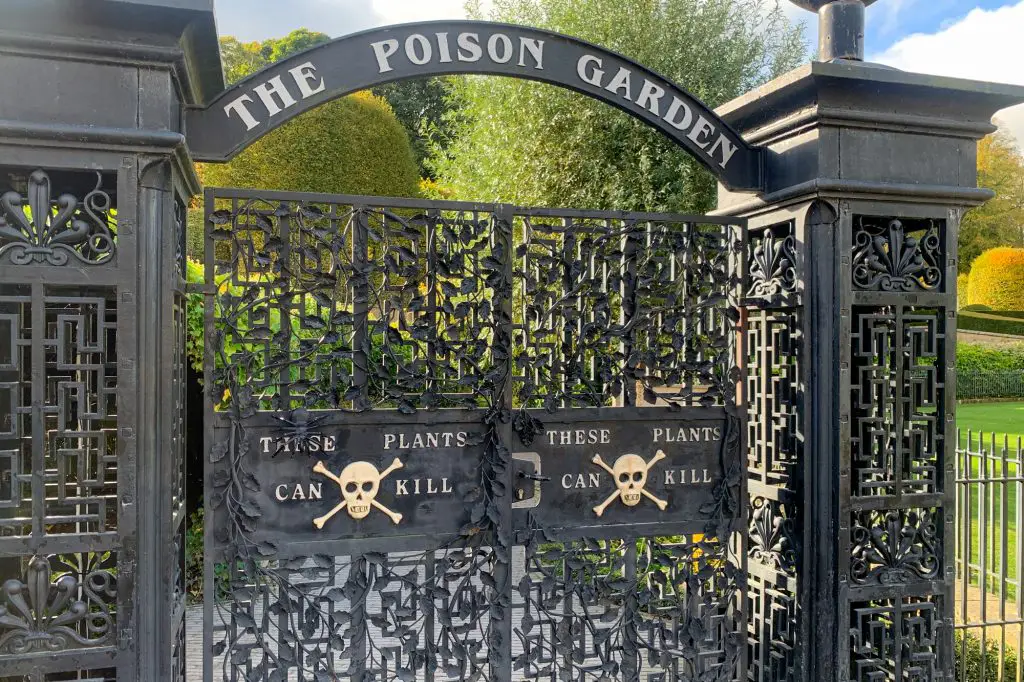
Deadly nightshade, cannabis and coca (the plant from which cocaine is derived) are a few examples of the plants housed in the Poison Garden. Visitors are prohibited from touching any of the greenery and there have even been cases of people passing out after smelling the plants!
The tour guides at the Poison Garden are great at explaining the real-life application of the plants using case studies such as Harold Shipman (Doctor Death) and Graham Young (The Teacup Poisoner). The garden also runs tours for local school children, educating them about drug use.
4. Paneriai Massacre Site – Vilnius, Lithuania
Paneriai is one of Vilnius’ many neighbourhoods. However, it will be forever remembered as the Ponary massacre site. The Einsatzgruppen (Nazi death squads) rounded up groups of Jews from the Vilna Ghetto, took them to Paneriai, executed them and forced other Jewish prisoners to dig mass graves and bury them.
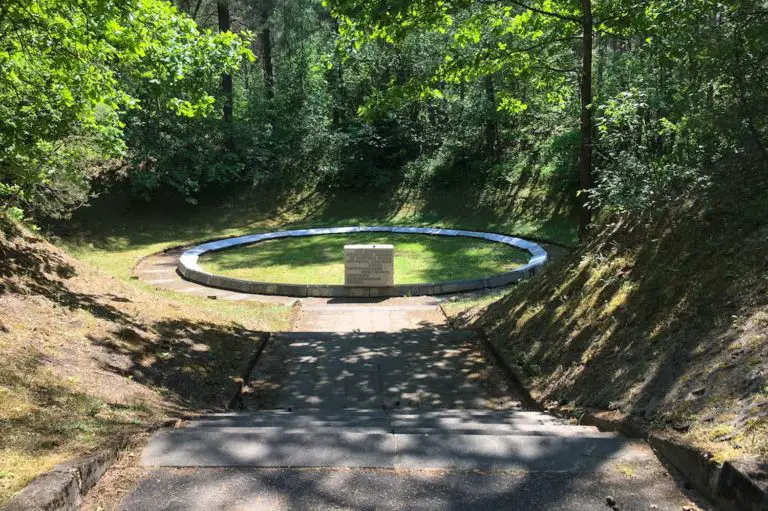
There are six burial sites within the complex, each the site of multiple mass executions. Because so many sets of bodies are stacked on each other, it is impossible to know the exact number of deaths. It is estimated to be around 100,000.
Those brought to Paneriai were burned to death in an attempt to destroy evidence. They were then shovelled into the pits, which today are marked by memorials. Like many of the massacre sites in the Baltics, Paneriai is a forested area. This makes walking around a surreal experience as it is quiet, peaceful and beautiful, a stark contrast to the memorials reminding you that thousands of people were slaughtered there.
Contributed by Cultura Obscura . Follow them on Facebook !
5. St. Nicholas’ Church – Hamburg, Germany
In July 1943, Hamburg was the target of an allied aerial World War Two bombing. The tall spire of St. Nicholas’ Church was used as an orientation marker and the building was almost completely destroyed. All that remained were some external walls, the crypt and most of the tower.
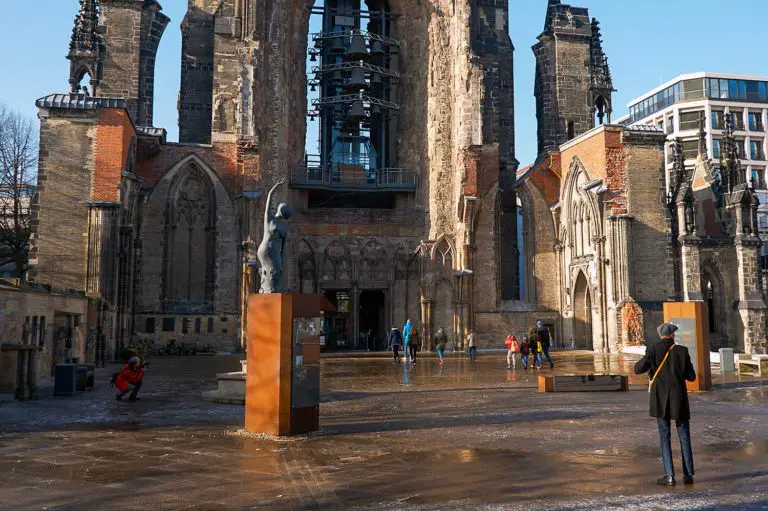
Today, St. Nicholas’ Church stands as a memorial to the victims of WWII. The memorial exhibits in the crypt provide many details of the events leading up to Operation Gomorrah , the air war over Europe. Beautiful sculptures sit inside, illustrating the futility of war and its disastrous consequences. A 51-bell carillon has been installed in the tower and sounds every Thursday at noon.
We visited the church on a walking tour of Hamburg and the experience still haunts me. The vast majority of people in Hamburg during Operation Gomorrah would have been perfectly ordinary citizens going about their daily lives – people just like me.
Contributed by Lesley of Freedom 56 Travel . Follow her on Twitter !
6. Comuna 13 – Medellin, Colombia
Medellin was once the most dangerous city in the world. When infamous drug lord Pablo Escobar controlled the city, crime was extremely high and the locals lived in fear. The neighbourhood of Comuna 13 had direct access to the main highway, making the exportation of drugs, weapons and other illegal goods extremely easy.
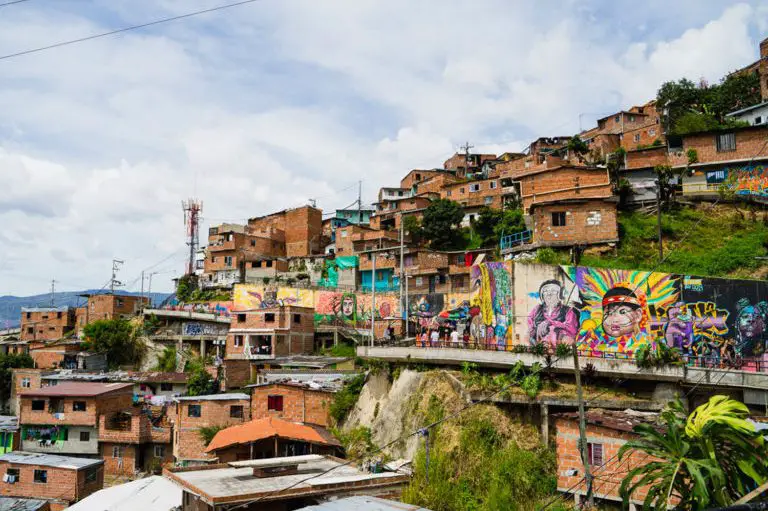
Drug cartels fought over control of the area and as a result, Comuna 13 was a very dangerous place. It was not uncommon to hear gunshots throughout the day and even to see dead bodies piled on the street. With that in mind, it might come as a surprise that Comuna 13 is now one of the most visited neighbourhoods in Medellin.
Over recent years, a tremendous amount of money has been invested in Comuna 13. A cable car system was installed to link it to the city centre. The resulting increase in tourism has sparked real change for the locals and the neighbourhood has become one of the country’s leading creative hubs.
Contributed by LivingOutLau . Follow him on Instagram !
7. Gulag Labour Camps – Karaganda, Kazakhstan
My trip to Kazakhstan left a deep impression on me. While I had heard about the so-called gulags, I did not know that most of them were in Kazakhstan. Stalin deported whole ethnic groups to the remotest corners of the country. This is how during WWII, the Volga Germans ended up in Karaganda .
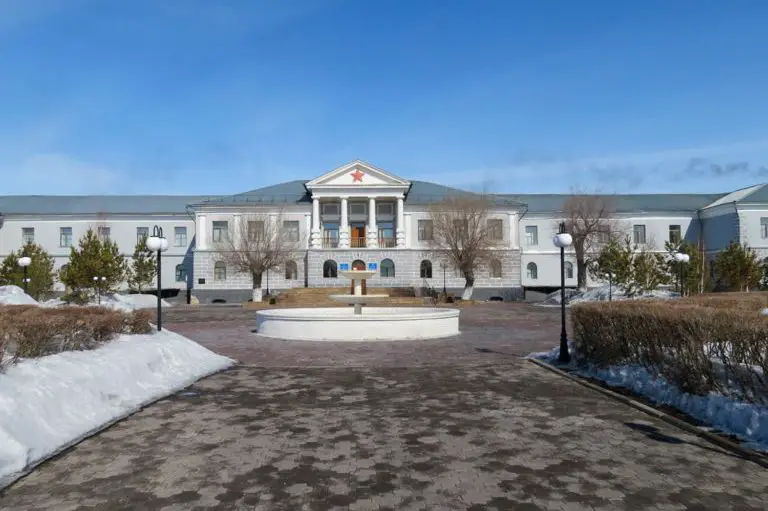
Stalin wanted to develop the farms and coal mines in Karaganda and set up a network of labour camps to support these projects. Political prisoners and deportees provided the free labour that was necessary.
Even though not much of the labour camps remain, Karaganda is the perfect example of a dark tourist site. There is an excellent Gulag Museum in the former headquarters of the labour camp in Dolinka.
Also nearby, the Ecological Museum covers other dark parts of Soviet history. The museum has an exhibition on the nuclear tests done in Kazakhstan and the debris that falls from the sky from the space program in Baikonur.
Contributed by Ellis of Backpack Adventures. Follow her on Instagram !
8. The Eruption of Mount Vesuvius – Pompeii, Italy
Pompeii was a thriving coastal city in Italy that was completely destroyed in 79AD when the neighbouring Mount Vesuvius erupted and covered the city in ash. It is a prime example of what is termed disaster tourism, where tourists visit a location where an environmental disaster has occurred.
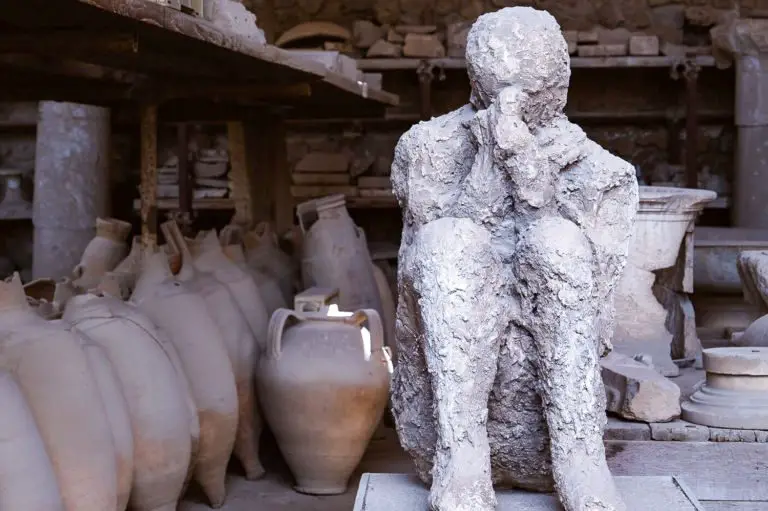
What makes the eruption of Mount Vesuvius more tragic was that the majority of people who died were slaves, who either had no means of escaping or were trapped. When archaeologists began excavating the site, they found several bodies. The ash preserved these bodies which allowed historians to create the human casts we see on site today.
Seeing these casts in crouching positions while covering their faces, gave me shivers. To get a greater understanding of the site and everything inside of it, I highly suggest finding a good tour guide. This photographic travel guide to Pompeii gives lots more tips for planning a visit.
Contributed by Natasha of And Then I Met Yoko. Follow Natasha on Instagram !
9. Mary King’s Close – Edinburgh, United Kingdom
Below the Royal Mile in Edinburgh hides an underground street paved with dark history. Mary King’s Close was alive with residents when the bubonic plague seized the country in 1645. The grievous epidemic turned the once-thriving close into a dreadful place, where its inhabitants suffered a slow and torturous death.
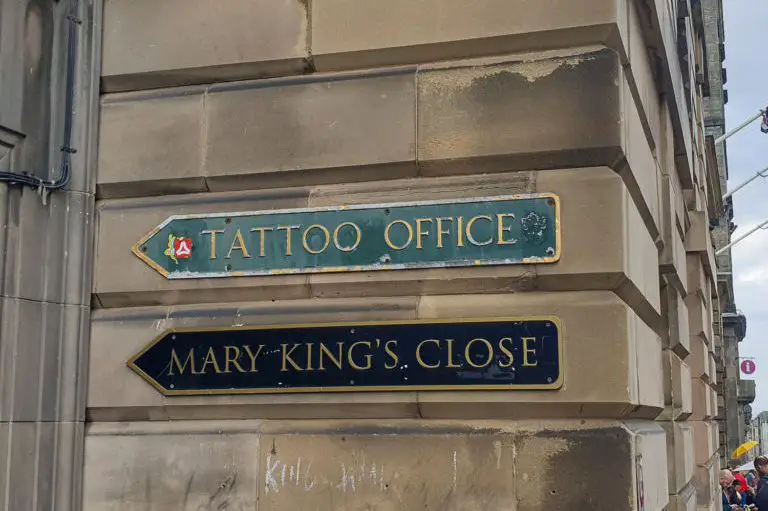
Mary King’s Close was sealed off and used as a foundation for the Royal Exchange in the late 1700s. Years passed and its terrible secrets were left trapped within its dark walls. In the 1990s, the close was rediscovered and opened to the public, allowing people to explore the subterranean streets that once festered with disease.
The mental image of the street once bustling with life left a lump in my throat – the locals had no idea how many would lose their lives to the Great Plague. Like Mary King’s Close, the entire city of Edinburgh is filled with dark and spooky places so be sure to check out Scotland’s capital if you’re a fan of the macabre.
Contributed by Wandering Crystal. Follow her on Instagram !
10. The Killing Fields and S-21 – Phnom Penh, Cambodia
During the Khmer Rouge genocide in Cambodia, execution, starvation and disease were allowed to flourish, killing an estimated three million people. Led by Pol Pot, the regime attempted to enforce brutal and inhumane policies to push Cambodia into being a classless society.
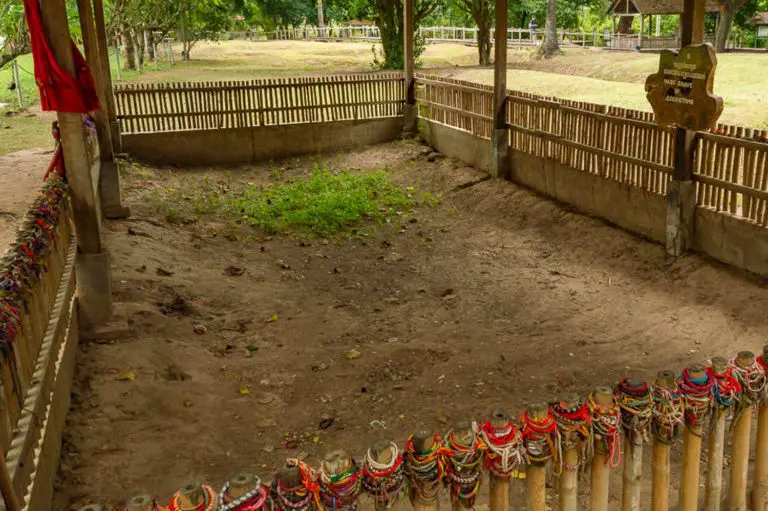
Phnom Penh and the surrounding area are home to S-21, a political prison used by the regime, and Choeung Ek, the largest of the Killing Fields. Over 12,000 prisoners were held at S-21 during the regime and with only seven known survivors, it’s a place known for unthinkable torture and suffering. The S-21 site now houses the Tuol Sleng Genocide Museum where you can learn more about the Cambodian massacre.
Much like S-21, a tour of the Cambodian Killing Fields can be hard to digest. There is a memorial stupa filled with the skulls of victims and you can still see bone fragments and strips of clothing along the paths. It’s a horrifying place but important to visit to ensure history doesn’t repeat itself.
Contributed by Ben at Horizon Unknown . Follow him on Facebook !
11. Abandoned Ghost Palace – Bali, Indonesia
Located near the village of Bedugul lies an abandoned hotel. Legend has it that in the early 1990s, the hotel began to be constructed by Tommy Suharto, the youngest son of the former Indonesian President. Tommy was later convicted of ordering the assassination of a judge who previously found him guilty of corruption and he subsequently went to prison. The hotel was never completed.
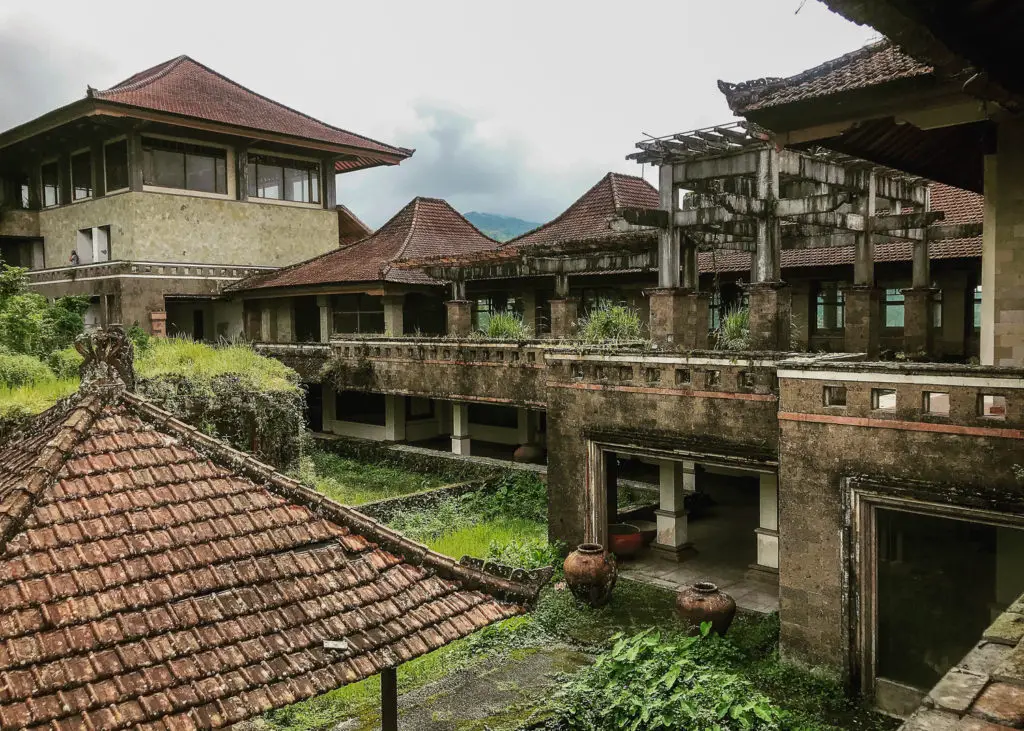
Another theory is that the hotel is haunted by the landlocked souls of labourers who were worked to death during its construction. The hotel, originally named Hotel Pondok Indah Bedugul, isn’t open for visitors but if you hand the guard 10,000 IDR, he’ll let you in to explore. I recommend seeing it as soon as possible because rumours indicate that visitors will no longer be permitted entrance (even with a bribe) because of how dangerous it is.
Contributed by Nat Wanderlust.
12. Auschwitz-Birkenau – Oświęcim, Poland
The “Final Solution to the Jewish Question” was the official code name for the murder of Jews during World War II. At least 1.3 million people were sent to Auschwitz by the Nazis and a shocking 1.1 million people were murdered by the SS, mainly in gas chambers.
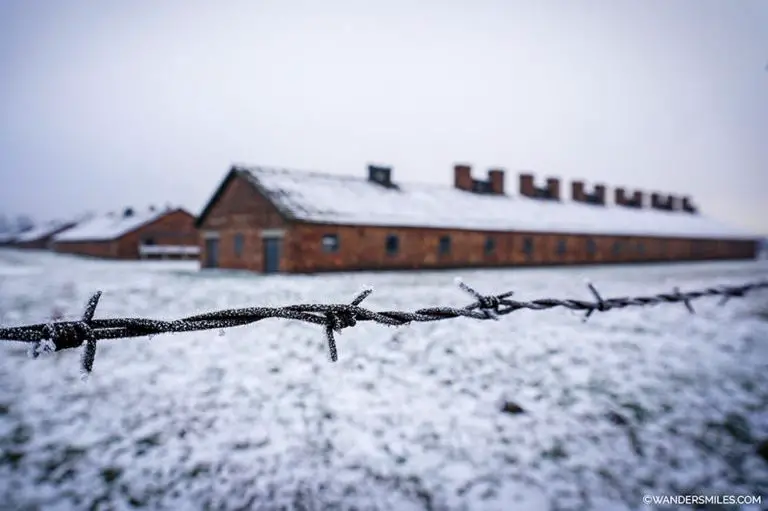
Auschwitz-Birkenau is located on two different sites. Auschwitz I comprises brick buildings and the Death Block where people were gassed. Auschwitz II, known as Birkenau, was opened as they could not cope with the scale of death at Auschwitz I.
On arrival, you’ll see the famous train tracks where people were transported in and either sent to the gas chambers or given labour duty. Once the latter were emaciated, they were gassed and replaced with new prisoners.
I cried in horror seeing the piles of shoes, suitcases and false legs that once belonged to people. Human hair was used to make felt for socks given to the forces in submarines – 293 sacks of hair were found on liberation. Words cannot describe the emotions you’ll have upon seeing this symbol of this horrific dark chapter in our history.
Contributed by Vanessa from Wanders Miles, follow her on Instagram !
13. Day of the Dead – Oaxaca, Mexico
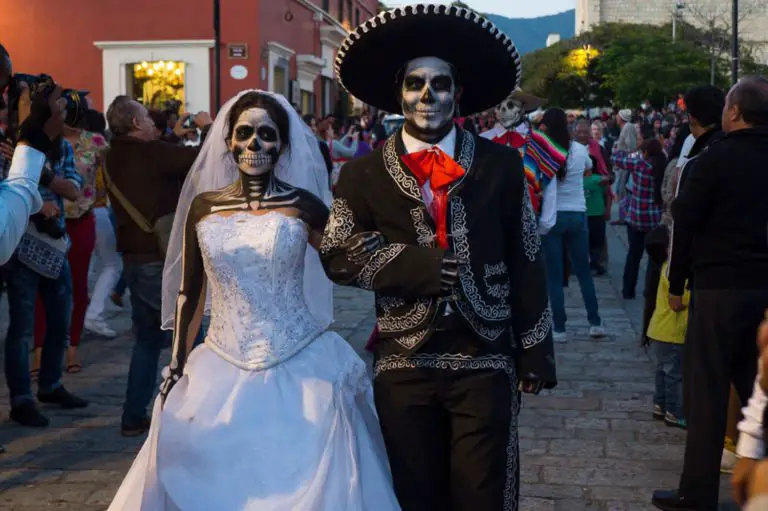
The Mexican Day of the Dead festival is a darkly uplifting event that occurs each year between October 31st and November 2nd. On these days, family and friends celebrate the lives of loved ones passed. It is widely believed that for three days each year, the veil between this world and the next is especially thin.
During the Day of the Dead festival, the spirits of the departed return to provide counsel to their living family members and friends. Much of the reunion is celebrated within the cemetery, where graves are cleaned and decorated for the occasion. On certain dates, families spend the whole night in the cemetery eating sugar skull sweets, drinking alcohol and playing music.
UNESCO recognises ‘Dia de Los Muertos’ as being ‘ Intangible Cultural Heritage of Humanity ’. Experiencing the Day of the Dead is a once-in-a-lifetime opportunity; especially in Oaxaca where visiting graves is commonplace. Prepare for everything you have ever thought about death to be challenged.
Contributed by Castaway With Crystal. Follow her on Instagram!
14. Red Terror Martyrs’ Museum – Addis Ababa, Ethiopia
The military junta who took power after Ethiopia’s Emperor Haile Selassie was ousted were known as the Derg. After prolonged internal wranglings, Mengistu, a soldier from the ranks, emerged as their leader and the dictator of Ethiopia.
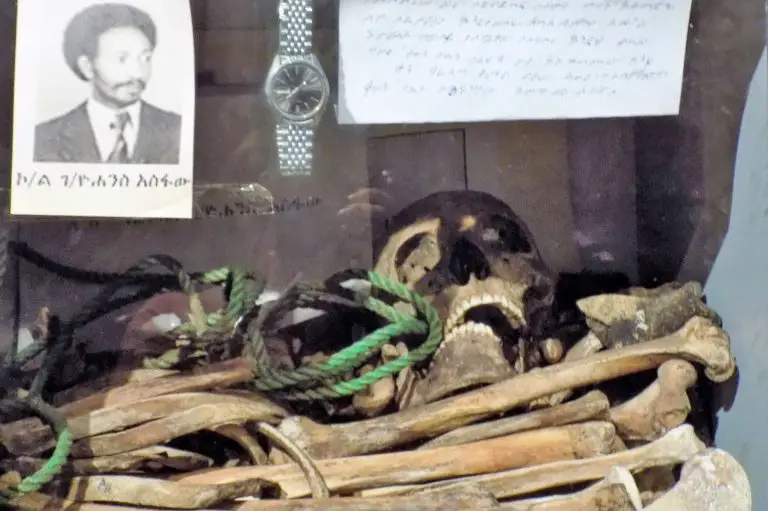
Within a couple of years, the Derg had created terror among ordinary Ethiopians, tens of thousands of whom had been imprisoned without trial and tortured, or worse, executed. The term ‘Red Terror’ comes from Mengistu’s famous speech when he smashed a bottle of blood to illustrate the killings to come. His regime is estimated to be responsible for the deaths of between 1.2 and 2 million Ethiopians.
Today, the horrors of Mengistu’s regime are remembered in the Red Terror Martyrs’ Museum in Addis Ababa . Opened in 2010, this small museum teaches about the atrocities of the regime. Photos of victims cover the walls alongside displays of human remains recovered from mass graves. We came away from the Martyrs’ Museum appalled by man’s inhumanity to man.
Contributed by Andrea of Happy Days Travel Blog. Follow her on Facebook !
15. Constitution Hill – Johannesburg, South Africa
Constitution Hill is now a living museum which tells the story of South Africa’s journey to democracy. It’s hard to comprehend that people like Nelson Mandela and Mahatma Gandhi served time here in the 1960s and that the prison was still operational until 1982.
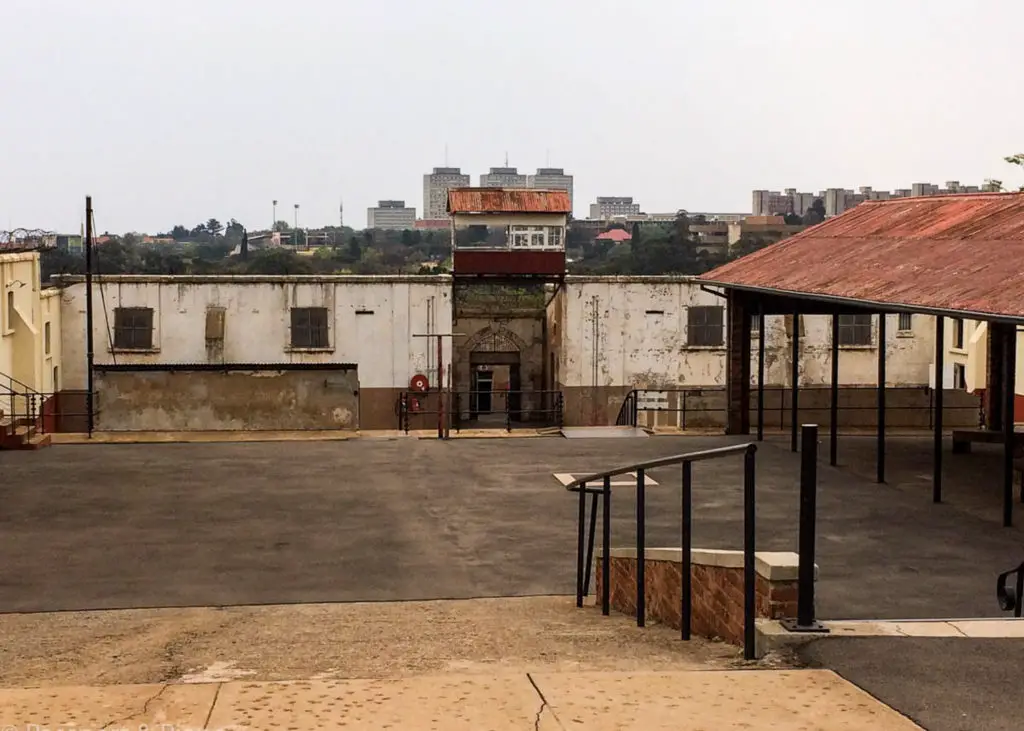
There are several sites that you can visit at Constitution Hill. The Old Fort is where white male prisoners were housed. Although the cells were overcrowded and unhygienic, the rooms are larger than those of the black prisoners. They were held in Block number 4. There was very little daylight and as I stepped inside, I was terrified that someone would shut the cell door behind me.
There’s also the Awaiting Trial Block. The block was demolished and the bricks were used to build South Africa’s new Constitutional Court. Thankfully this court serves to uphold the rights of all South Africans, regardless of colour, but the bricks are a poignant reminder of its troubled past.
Contributed by Fiona of Passport and Piano . Follow her on Facebook !
16. Shanghai Tunnels – Portland, USA
In a city known for the slogan ‘ Keep Portland Weird ,’ the Shanghai Tunnels fit right in. It’s believed that from 1850 until 1941, men in Portland, Oregon, were regularly kidnapped and sold to ship captains as labourers. During this period, there was a shortage of labour available for the city’s booming shipping industry and this created a black market.
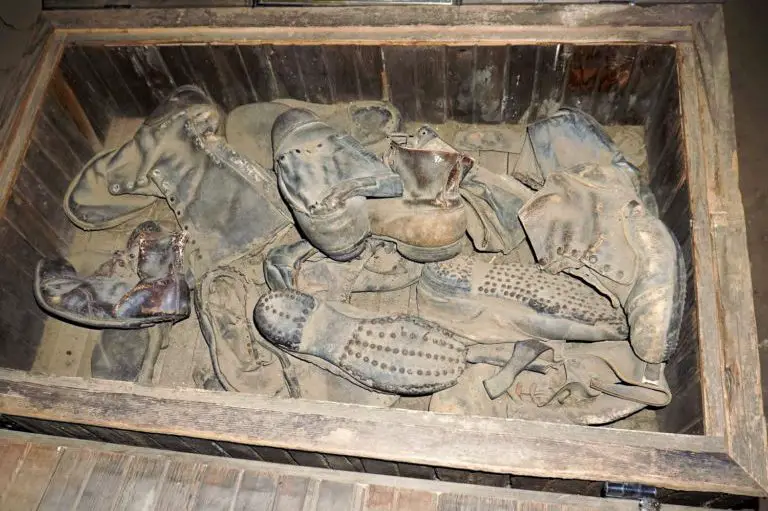
To capture these men, underground tunnels originally built to move inventory between businesses were repurposed for illicit use. Trapdoors were even installed in some of the local bars so that drunk men would drop into the tunnel below.
Today, tours of these tunnels are offered daily by a non-profit organisation, Shanghai Tunnels/Portland Underground. All tour participants are advised to be prepared for spending an hour in a confined space. While the nature of the tour is sad and tragic, it’s an important part of Portland’s history.
Contributed by Wendy of Empty Nesters Hit the Road. Follow her on Facebook !
17. Brno Ossuary – Brno, Czech Republic
Of the attractions in Brno , several of them could be classed as dark tourism attractions. The one that moved me the most, though, was the ossuary underneath the St. James Church.
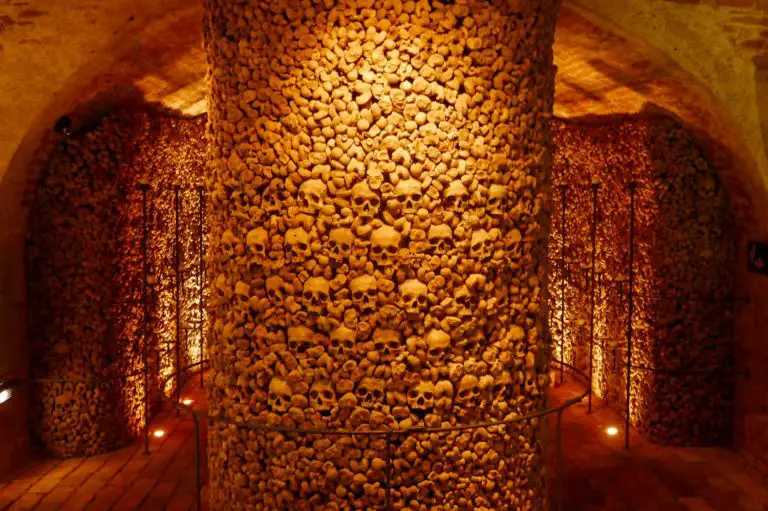
Surrounding this church, which is known as the ‘Kostnice u sv. Jakuba’ in Czech, was one of the main churchyard cemeteries in Brno. Eventually, as the city grew, there was no room left for new burials so a grave rotation system was adopted.
When a burial took place, the body was left in the grave for between 10 to 12 years. After that, the bones were taken out to make room for the next burial. The displaced remains were then relocated to the ossuary, where bones from thousands of graves were piled up.
It’s estimated that Brno Ossuary holds the bones of more than 50,000 people, which makes it the second-largest ossuary in Europe; only second to the Paris catacombs. The mortal remains laid to rest here include victims of the Swedish siege of Brno and the Thirty Years’ War, as well as many victims of plague and cholera epidemics.
Contributed by Wendy of The Nomadic Vegan. Follow her on Instagram !
Do you have any dark tourism examples to share? Let us know in the comments!
9 thoughts on “17 Must-Visit Dark Tourism Destinations Around the World”
Comuna 13 is spellt with only 1 -m-.
I wonder why choose the cemetery in Sucre, when so many others are more characteristic (eg. Père Lachaise in Paris) or even ‘livelier’ (eg. in Santiago de Chile).
Interesting & important topic though. I’m in the process of rewriting an article about the mines of Potosi. That is one dark tourism destination I strongly oppose, for one simple reason; people are still dying in there.
Thanks for the heads up Anthony! 🙂
I chose the cemetery in Sucre because it was a little bit off the beaten track – I like visiting the lesser known places as well as the more famous ones.
I can understand your point about the mines of Potosí and can see why you disagree with it. I must say though, from my own personal experience, I found my visit to be hugely enlightening. I was initially very torn about the idea of visiting an active mine but in the end, we chose a company run by an ex-miner who took us into the mine personally. In my opinion, our visit never felt voyeuristic at all and the miners seemed very grateful for the tourists visiting. A percentage of the tour cost went directly into the funding the healthcare of the miners when needed and also towards maintenance of the mine.
Such a great and informative post, Sheree! There were so many sites here that I was not even aware of – that is why sharing posts about dark tourist sites is so important! It really helps educate the world and helps us honour the past and the lives that were lost at some of these sites.
Like you, I am a huge fan of cemeteries. It is so wonderful that some countries treat death as a natural normal part of life (unlike some of our countries!). It really helps people remember happy memories of their loved ones they recently lost.
Thanks so much for being a part of it Crystal! I also learnt about loads of new dark tourism sites – it has definitely been an eduction as there was plenty of these I had never even heard of. It is definitely important to make sure the stories behind these places get told.
Thank you for including us in this fantastic collab!
I love how varied these sites are, and that you’ve included a lot of lesser know dark tourism destinations mixed in with some of the big ones. Even as professional dark tourists (that’s a thing, right?), we hadn’t heard of all of these places. The Shanghai Tunnels were completely new to me, but definitely want to head to Portland now.
I’m also a little embarrassed to admit that despite being to Hamburg MANY times, I was not aware of the St. Nicholas’ Church. I blame that on the fact that I was visiting a friend and not really touristing…
Awesome post everyone! I think it is really important for people to visit at least one of these in their lifetime. I think we are jaded from the major events that happened to our world and it’s people when we are told the stories. To see the places in real life, it puts life into perspective and how crazy life can be if we don’t fight for what is right.
I couldn’t agree more. Even though visiting these kinds of places is hard, I still think it is really important to help us realise the human effect of what we see on the television. As you said, it is only once you truly understand the devastation that you realise the importance of fighting for the right things.
Great article . I’ve been to a lot of places around the world and haven’t even heard of some of these .
Thanks Jennifer! I’ve certainly added a lot of places to my future visit list!
Leave a comment Cancel reply

12 ‘Dark Skies’ campgrounds for stargazing in Florida
By: Author Bob Rountree
Posted on Last updated: March 28, 2024
The most heavenly campgrounds for stargazing in Florida have dark skies in lonely places, well away from the ambient light of populated areas, and it’s a better experience if you can camp overnight under the stars.
Skies are darkest with the “new moon,” which actually means no moon, allowing the galaxies to shine.
The week of April 2-8, 2024 is International Dark Sky Week , intended to raise awareness about light pollution. Two parks in Florida are certified “dark sky places” by the International Dark Sky Association :
- Kissimmee Prairie Preserve State Park , 30 miles north of Lake Okeechobee, and
- Big Cypress National Preserve in the heart of the Everglades.
But we recommend a dozen great campgrounds across Florida where you can pitch a tent and enjoy Florida’s dark skies.
#DarkSkyWeek #DiscoverTheNight
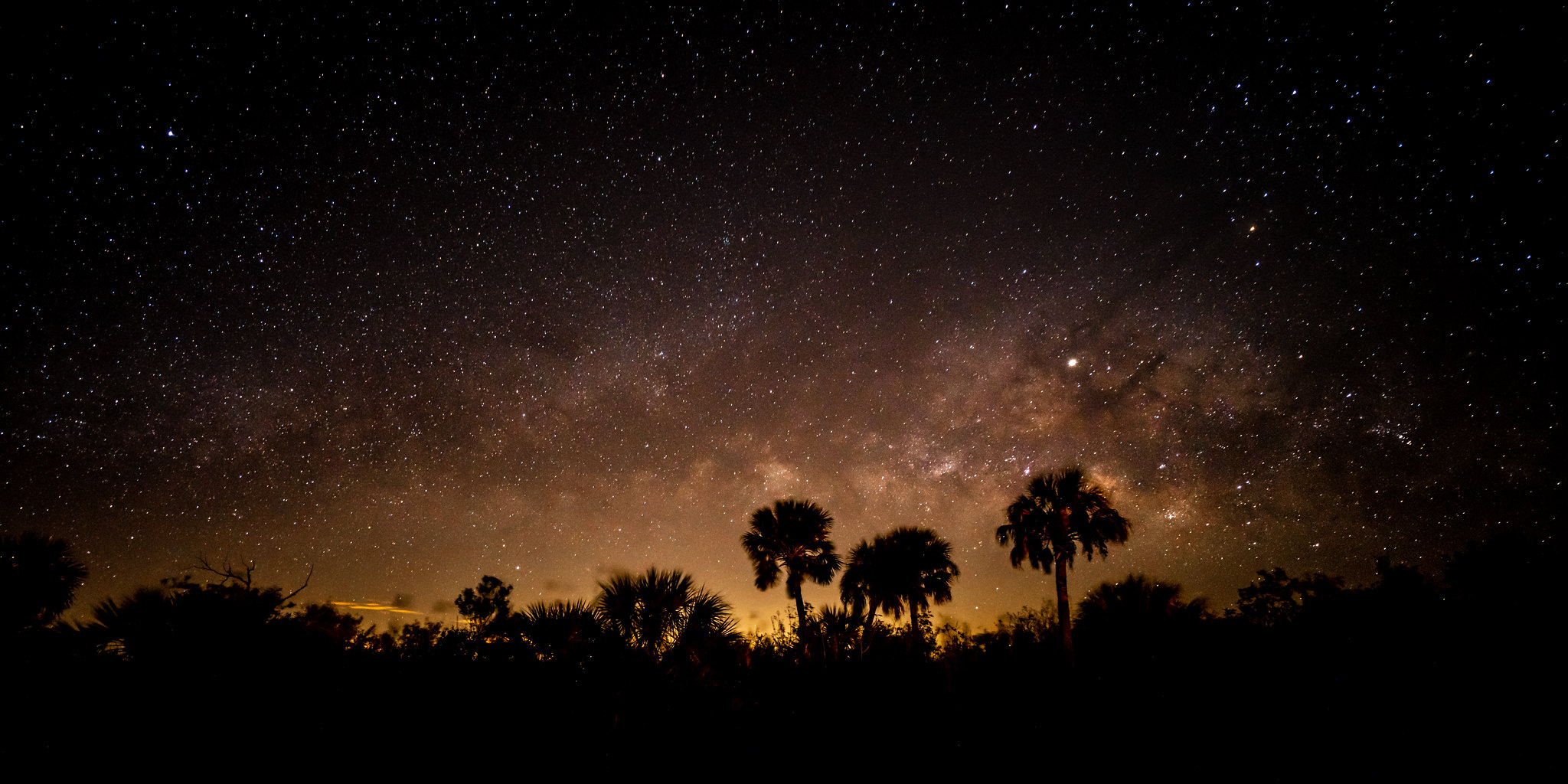
Central Florida
North florida.
- Florida's Big Bend
South Florida
Night Sky Map . This link will take you to www.timeanddate.com/astronomy/night/ where today’s map of your local night sky will be displayed with viewing times for visible planets and constellations, depending on your web browser’s location settings.
2024 New Moons for darkest skies
International Dark Sky Week is officially celebrated from April 2-8, 2024, but you can explore the galaxies on any week of the new moon.
Kissimmee Prairie Preserve State Park
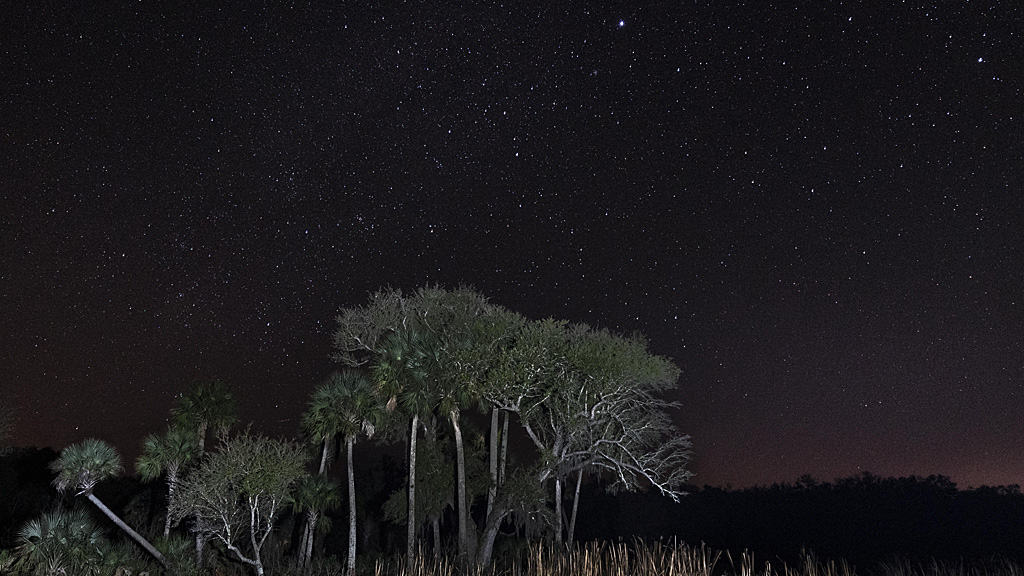
With 54,000 acres of prairie surrounded by vast cattle ranches and almost 30 miles from the nearest town, suburban light pollution does not exist, making the Kissimmee Prairie Preserve an ideal campground for stargazing.
If you’re not camping, you need a permit to enter the park after it closes at sunset. (Phone: (863) 462-5360 for details.)
Kissimmee Prairie’s three campgrounds are clustered in the middle of the park. The family campground has 16 RV/tent sites. There are 14 RV sites in the equestrian campground (with unshaded paddocks for the horses), and five astronomy pads for tent campers, known as the “red light district.”
Red lighting at your campsite is the norm in all three campgrounds, a colorful though somewhat eerie scene after nightfall.
Kissimmee Prairie Preserve was recognized as Florida’s first “Dark Sky Place” by International Dark Sky Association in 2016.
Kissimmee Prairie Preserve State Park , 33104 N.W. 192nd Ave., Okeechobee FL 34972. Phone: 863-462-5360. For campground reservations up to 11 months in advance, go to reserve.floridastateparks.org
Read more about Kissimmee Prairie Preserve State Park
Withlacoochee River Park
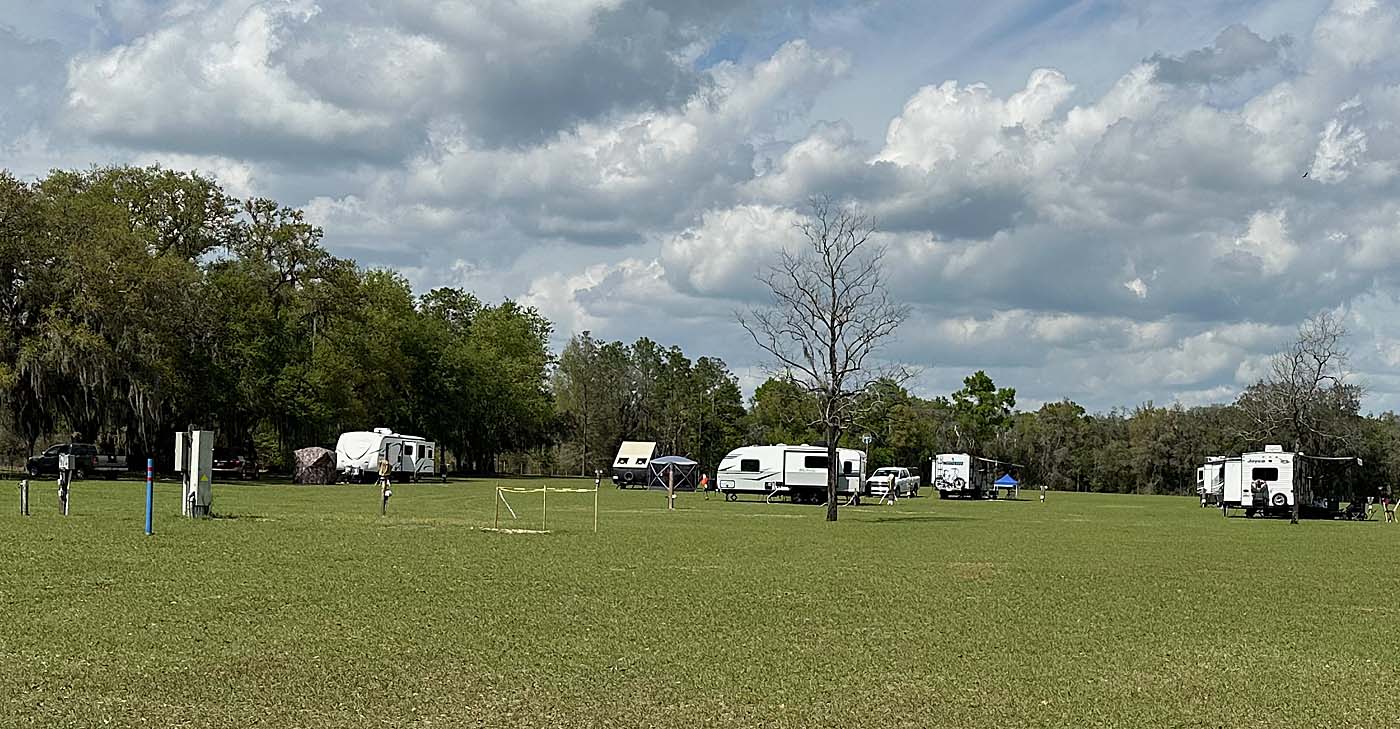
A favorite of the St. Petersburg Astronomy Club , Withlacoochee River Park is in a remote corner of Pasco County on the edge of the massive Green Swamp Wilderness Preserve, about seven miles east of Dade City.
The club reserves the park’s Activity Field on new-moon weekends, and campsites with hookups for water and 20/30-amp electric are available in the field for amateur astronomers. You do not have to be a member, and reservation are not necessary.
Non-member camping fees are $25/night with electric or $10/night without. Club members receive a discounted rate of $15/night with electric or $10/night without. Campers must display Friends-Of-The-Park Pass to be on the Activity Field.
The park’s regular campground has 15 RV sites with water and electric in the woods that you can book in advance. Nightly rate is $25. The campground also has 7 primitive tent sites without hookups for $15/night, and another 8 hike-in sites. The park also has two primitive cabins for $40 per night.
While the Activity Field has wide-open skies, the regular campground has considerable tree cover. Campers must arrive before dusk and be settled in their sites on new-moon weekends.
Editors Note: RVers should not rely on the park’s poorly designed dump station. There is no drainage for spills, and we found it unusable on a recent visit.
Withlacoochee River Park , 12449 Withlacoochee Blvd Dade City, FL 33525-1014. Phone: 352-567-0264. You do not need a reservation on the Activity Field for new-moon weekends. To reserve a site in the campground, go to PascoCountyFL.net .
Hopkins Prairie Campground
In ocala national forest.
An island of shady oaks amid sweeping grasslands, the Hopkins Prairie Campground is a seasonal destination for campers looking to get off the beaten path. Hopkins Prairie sits along the Florida Trail with fishing and birding along miles of prairie shoreline.
All 21 sites are well-shaded in an oak hammock surrounded by grasslands, affording most sites a view of the prairie and phenomenal views of the night sky. The campground has vault toilets and a shared hand pump for drinking water.
Hopkins Prairie Campground is open seasonally from October through June for $12 per night (cash), and no reservations are required.
Another excellent option is the Farles Prairie Recreation Area , but there’s no campground, just dispersed camping outside its perimeter. Hikers pitch tents along trails outside the recreation area, along the rim overlooking the prairie or the lake.
While Hopkins Prairies and Farles Prairie are recognized as a prime stargazing sites for amateur astronomers and photographers, you can hardly go wrong anywhere in the forest with a clear view of the sky.
Hopkins Prairie Campground , Ocala National Forest . GPS Coordinates Latitude: 29° 4′ 44.0000″ N | Longitude : 81° 34′ 48.0000″ W. The campground is managed by Adventure Ocala .
Read more about Camping in Ocala National Forest
Chiefland Astronomy Village
Or manatee springs state park.
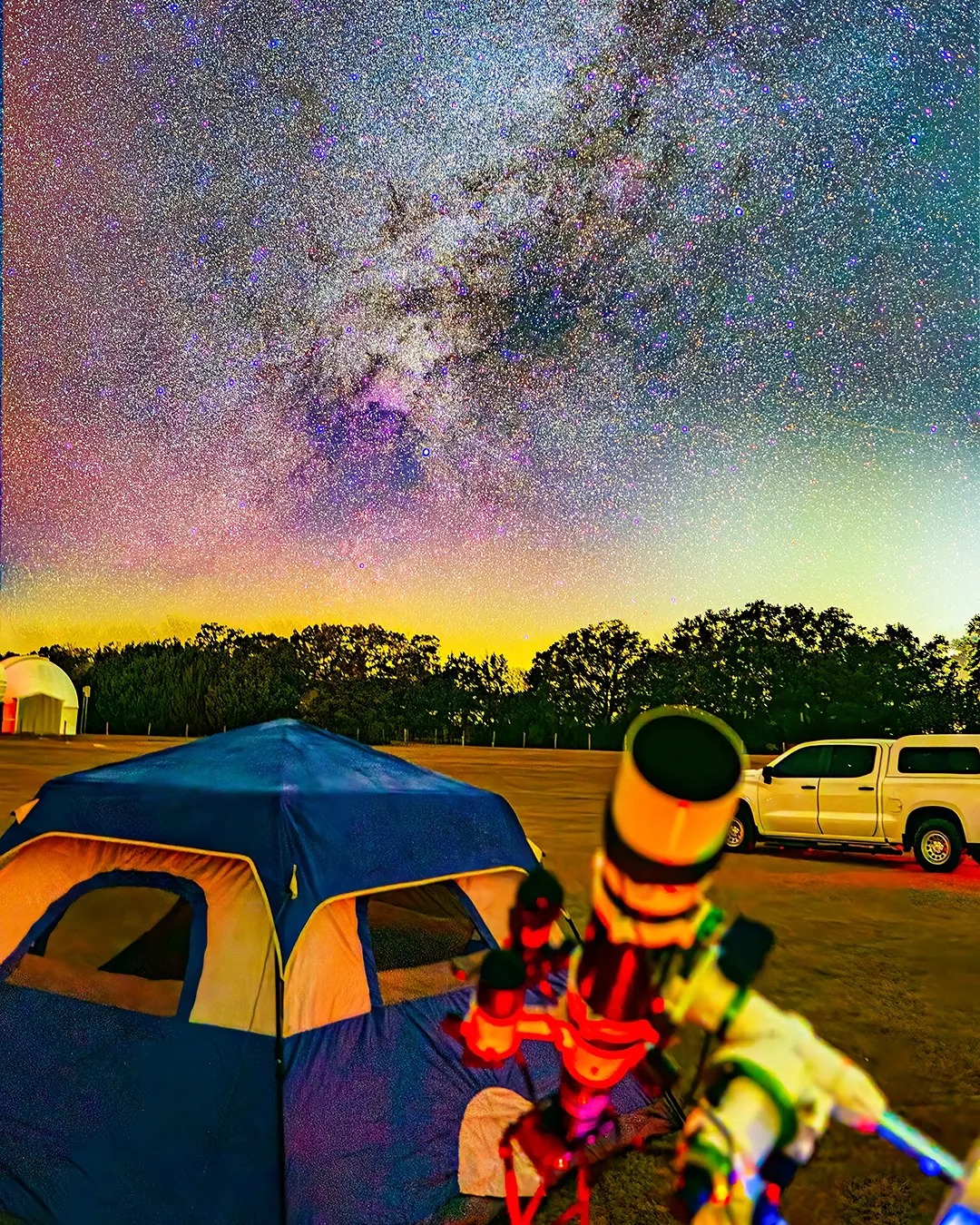
Stargazing events have long been held at the Chiefland Astronomical Village, a few miles south of Manatee Springs State Park, leading the International Dark Sky Association to encourage Manatee Springs State Park to apply for recognition as a Dark Sky Park.
Chiefland Astronomical Village is a privately owned dark-sky site in northwest Florida. The observation field is open 365 days a year to members, who pay a $30 fee for annual membership. Camping is permitted with a donation of $15 per night for tents and $30 for RV’s with a 30-amp hookup. Red lighting is mandatory when camping here.
Every month around the new moon, a three-day star party is held in the open field with a Spring Picnic on the new moon in April and Fall Astrofest on the new moon in November.
For contact information, membership and payment details, go to Google Docs .
If you’re looking for less-restrictive alternatives (red lights not required) with more recreational options, book a campsite at Manatee Springs State Park on the Suwannee River, offering kayaking and canoeing and other boating options.
Manatee Springs is 14 miles from Chiefland Astronomy Village. | Map with directions
This state park has a developed swimming area, 8.5 miles of nature trails, and a connector to the 32-mile Nature Coast State Trail for bicycles. During the cooler months, manatees can be seen snuggling up to the spring run.
Manatee Springs State Park has 80 woodsy, well-spaced campsites, some just for tent campers, some for RVs, with electric and water at each site. Sites are
Chiefland Astronomy Village , 5310 NW 52 Ct, Chiefland, FL 32626. Contact: [email protected]
Manatee Springs State Park , 11650 N.W. 115 St., Chiefland FL 32626. Phone: (352) 493-6072. Camping fee: $20 per night plus $7 daily utility fee and a one-time booking fee of $6.70. Reservations accepted up to 11 months in advance for Florida residents and 10 months in advance for non-residents at reserve.floridastateparks.org
Read more about Manatee Springs and nearby Fanning Springs
Interactive Moon Phases . This link will take you to www.timeanddate.com/moon/phases/ where you will see charts of moon phases for your location (the default). You will also have an option to enter other locations.
St. George Island State Park
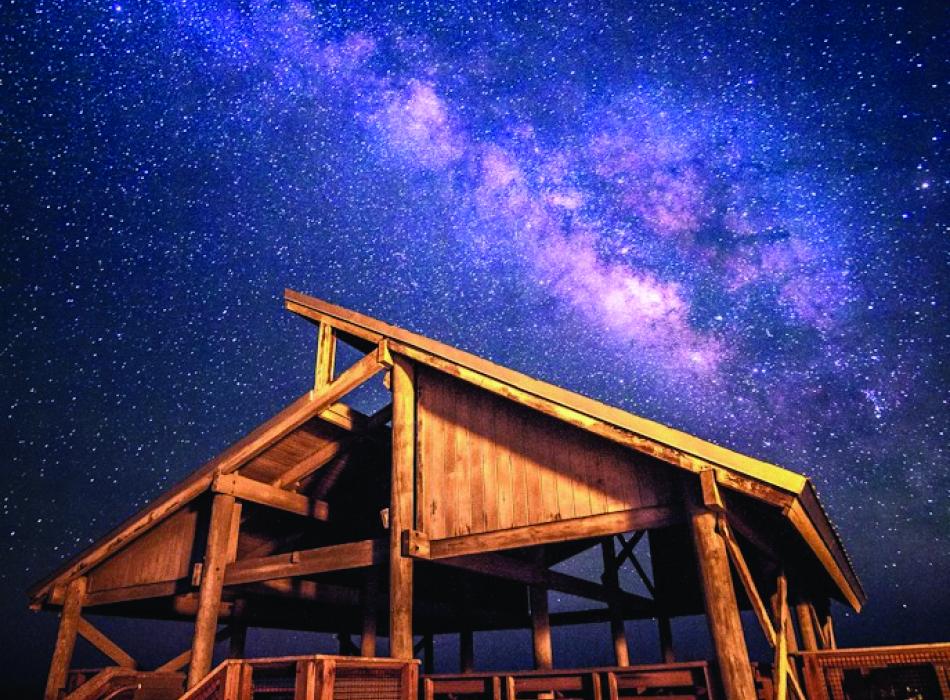
St. George Island is a barrier island off Apalachicola Bay, and the campground at St. George Island State Park is all the way at the island’s eastern end, a healthy distance from the island’s population and off a barren coast.
No lights here, except the campfires, and you can get away from them by crossing the dunes to the beach, where the heavens shine with abandon after sunset.
“The park offers the best viewing of the night sky in the region,” according to the park’s web site, “and staff are working toward a designation as a Dark Sky park with the International Dark Sky Association.”
An observation platform built by volunteers is perfect for stargazing, but you can find a good spot almost anywhere on this pristine, dune-wrapped beach.
The campground has 60 sites with water and 50-amp electric. Max trailer length is 43 feet.
St. George Island State Park , 1900 E. Gulf Beach Drive, St. George Island FL 32328. Phone: 850-927-2111. Camping fee is $24 plus a daily $7 utility fee and a one-time $6.70 booking fee. Book campground reservations online up to 11 months in advance for Florida residents and 10 months in advance for non-residents at reserve.floridastateparks.org
Read more about St. George Island and Apalahicola
Ochlockonee River State Park
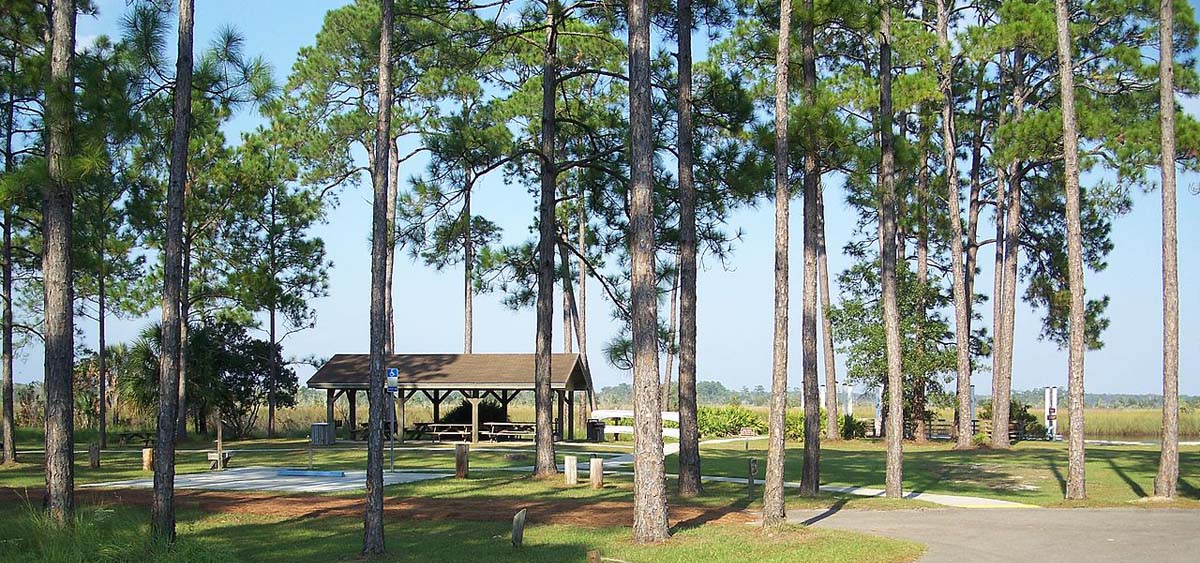
Isolated by surrounding forests and significant wildlife refuges, Ochlockonee River State Park anchors the middle of a desolate wilderness corner of the Panhandle free of light pollution, about 45 miles south of Tallahassee.
Buffered against civilization by Apalachicola National Forest , the St. Marks National Wildlife Refuge and Tate’s Hell State Forest , Ochlockonee not only offers the ideal night sky for stargazing, but it’s also a magnet for migrating wildlife.
Recreation opportunities include camping, boating and fishing, kayak and canoe trails, bicycling and hiking on multi-use trails. It’s also a notable birding destination.
The campground has 30 sites with 50-amp electric, water hookups, fire ring, picnic table and clothesline. No sewer hookups, but a dump station is nearby, along with restrooms with hot showers, an outside sink for washing dishes, and water fountains.
Ochlockonee River State Park , 429 State Park Road, Sopchoppy FL 32358. Camping fee: $18 plus a $7 daily utility fee, taxes and a one-time $6.70 booking charge. Reservations: Florida residents can book sites up to 11 months in advance, non-residents up to 10 months in advance, at reserve.floridastateparks.org or call 800-326-3521.
Related Story: St. Marks National Wildlife Refuge
Torreya State Park
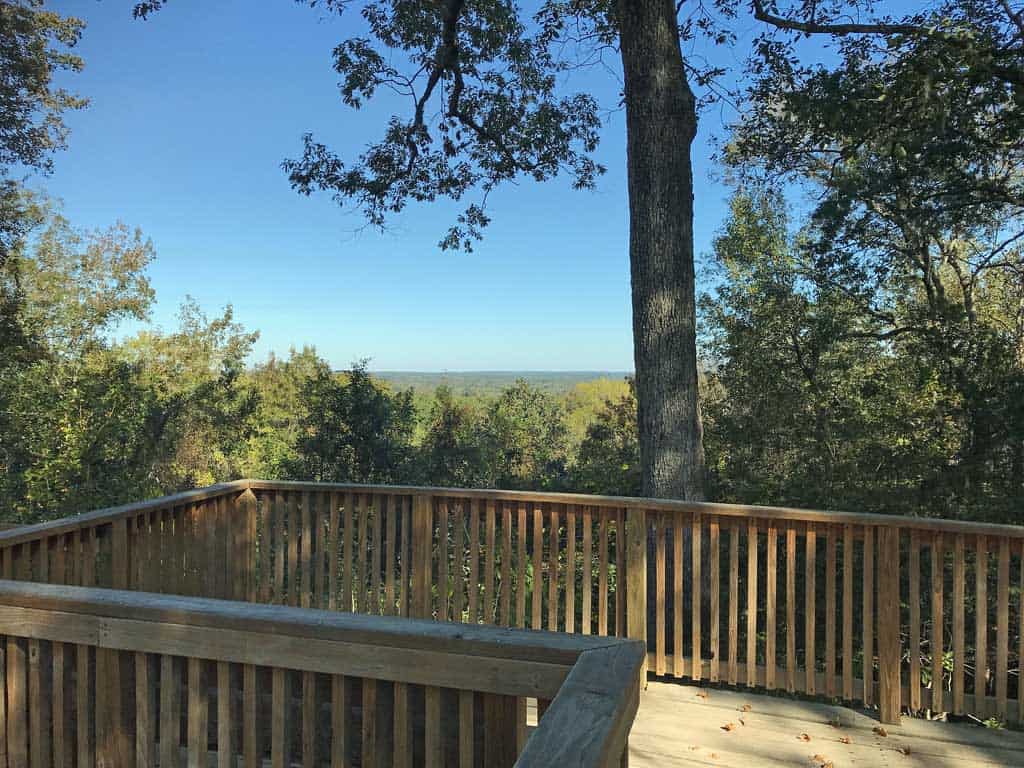
Your campsite is closer to the sky at Torreya State Park, where the campground rises on a high bluff above the Apalachicola River, a seemingly endless view in the daytime, and a grand stage for the northern sky at night.
I felt like I was in another place and time when I camped there.
An added bonus, you are in what some say is the real Garden of Eden. Other legends have it where the world’s wildlife boarded Noah’s Ark. Or you can just chalk all that talk up to Florida Tourism.
Any way you cut it, Torreya State Park is a premier destination for stargazers. The nearest town of any consequence is Bristol, population 845, about 14 miles away. Most everything else around the park’s bluff is dense forest.
The park’s 29 campsites are well-suited for both tents and recreation vehicles with full hookups, and there’s a yurt available for nightly rentals of $40.
Torreya State Park , 2576 N.W. Torreya Park Road, Bristol FL 32321. Phone: 850-643-2674. Camping fee: $16 per night plus a daily $7 utility fee, taxes and a one-time reservation fee of $6.70. Book your campground reservations up to 11 months in advance for Florida residents, 10 months for non-residents, at reserve.floridastateparks.org . Or call 800-326-3521.
Read more about Torreya State Park
Florida’s Big Bend
Shell mound campground & boat ramp, levy county.
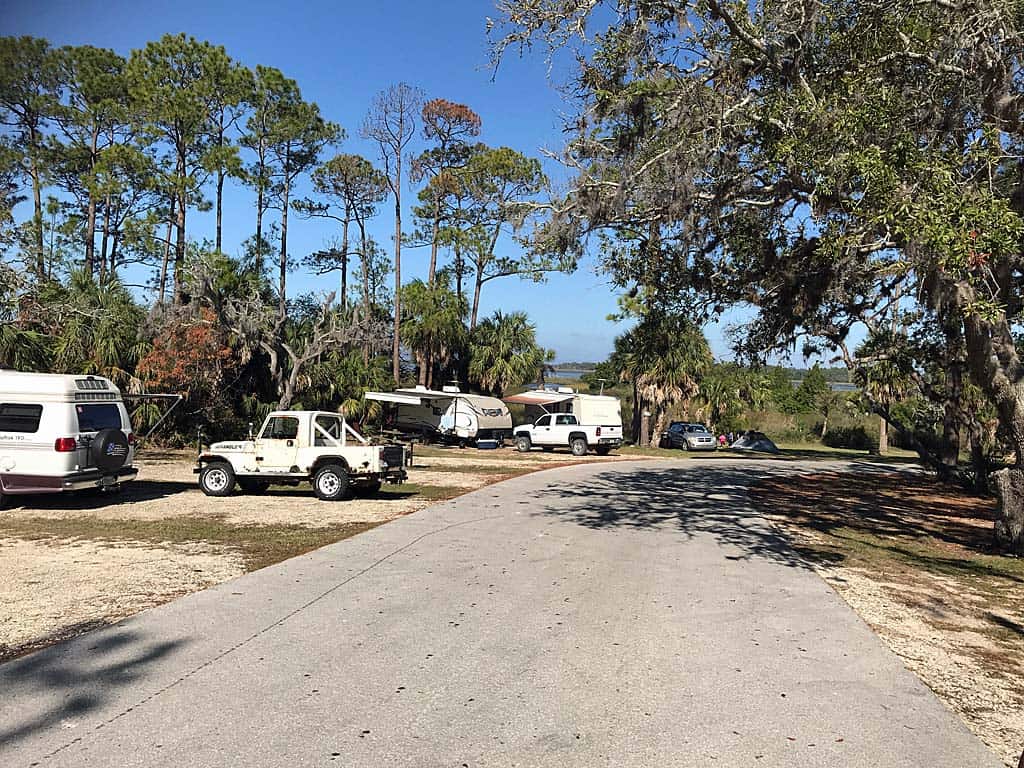
The Shell Mound Boat Ramp is in a remote corner of Levy County, overlooking desolate and very dark Suwannee Bay.
There is literally nothing nearby that would cause light pollution.
Campers there are most likely anglers, but the new moon is not prime time for fishing, so you will probably only encounter fellow stargazers.
Should you get a high tide during a new moon, you can kayak out from the boat ramp for a clearer view of the night sky. Just don’t get lost in the flats of the bay. Low tide is a bit risky, given the frequent shoals and shallow waters on the flats.
Shell Mound Campground , 17650 SW 78th Place, Cedar Key, FL 32625. Phone: (352) 221-4466. Camping fees: Water and electric sites for two people are $25, electric-only sites are $20 and tent sites are $10, including tax. Cash only. No reservations. Cedar Key is the closest town, about 9 miles.
Related story: Shell Mound and other camping near Cedar Key
Shired Island Campground
Dixie county.
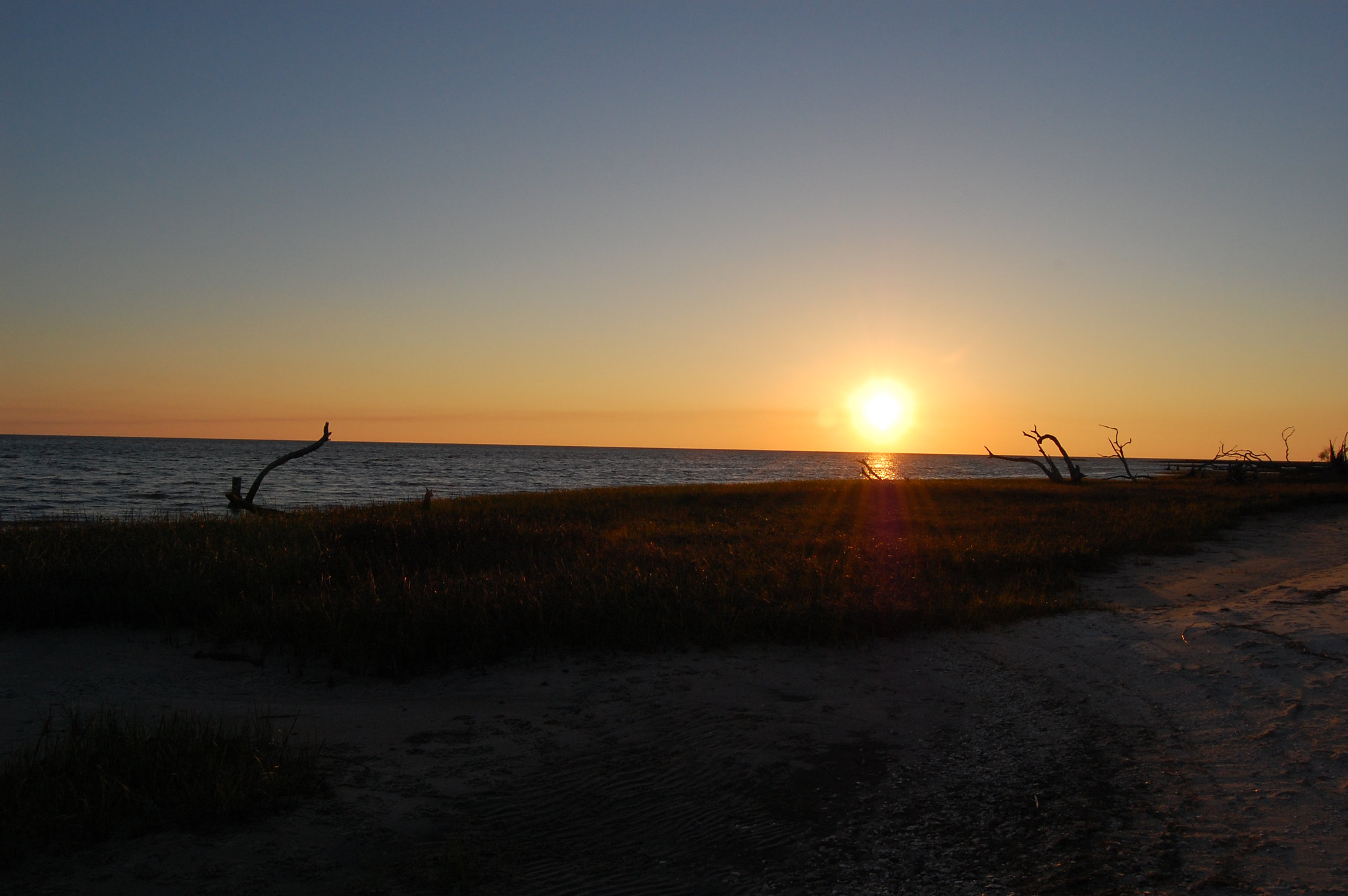
Another favorite for dark sky enthusiasts, Shired Island, is deep in the isolated saltwater marshes of Lower Suwannee National Wildlife Refuge on Florida’s Big Bend.
A short hike away from the campground or paddle off-shore offers the best views of the night sky.
The campground offers 12 hookup spots for RV’ers, with or without electricity, first come, first served. Tent campers are welcome.
Weekdays are best. The local party crowd takes over the park on weekends for backcountry carousing.
Shired Island Park Campground , 21354 County Rd 349, Old Town, FL 32680. No reservations. An employee of the parks department comes around to collect the $20 camping fee in the morning.
Big Cypress National Preserve
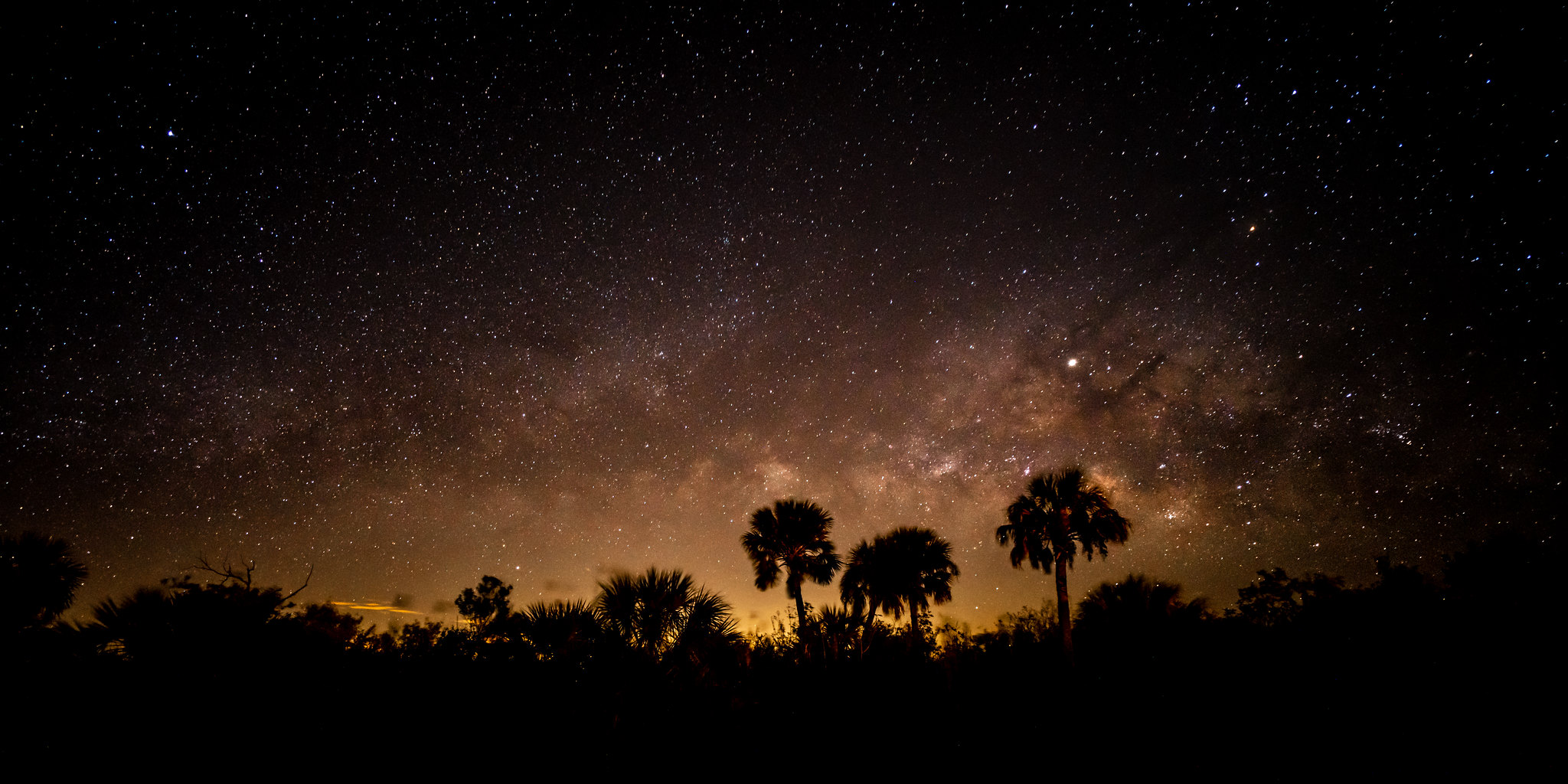
Big Cypress National Preserve is a wilderness. Arguably, any of its 5 campgrounds are ideal for experiencing dark skies on the new moon.
“The Preserve is bordered by the wet freshwater prairie of Everglades National Park to the south, and other federal and State of Florida lands to the west,” the association notes in its designation.
The two campgrounds I recommend for the best stargazing are Midway (open all year) and Burns Lake (seasonal).
Midway Campground . (Open all year) The Midway Campground is the most developed Big Cypress campground with water, electric hookups and restrooms. The 26 RV sites with electric are $30/night, and the 10 tent sites are $24/night. Midway is 3 miles from the visitor center, where stargazing events are held monthly from December until March.
Burns Lake Campground (Seasonal). Burns Lake has 10 RV and five tent sites,. The campground is only open from Aug. 15 until April 15. There are no electric hookups (no lights) and no water, so bring your own everything. The sites are out in the open with plenty of separation, making it an ideal bivouac for stargazing. Burns Lake is 13 miles from the visitor center.
From December until March, park rangers host monthly Starpark events at the Kirby Storter Nathaniel P. Reed Visitor Center, southern end of Seagrape Drive, east of SR 29 between MM 73 and 74 on US 41.
Related Story: Camping in the Big Cypress National Preserve
Dry Tortugas National Park
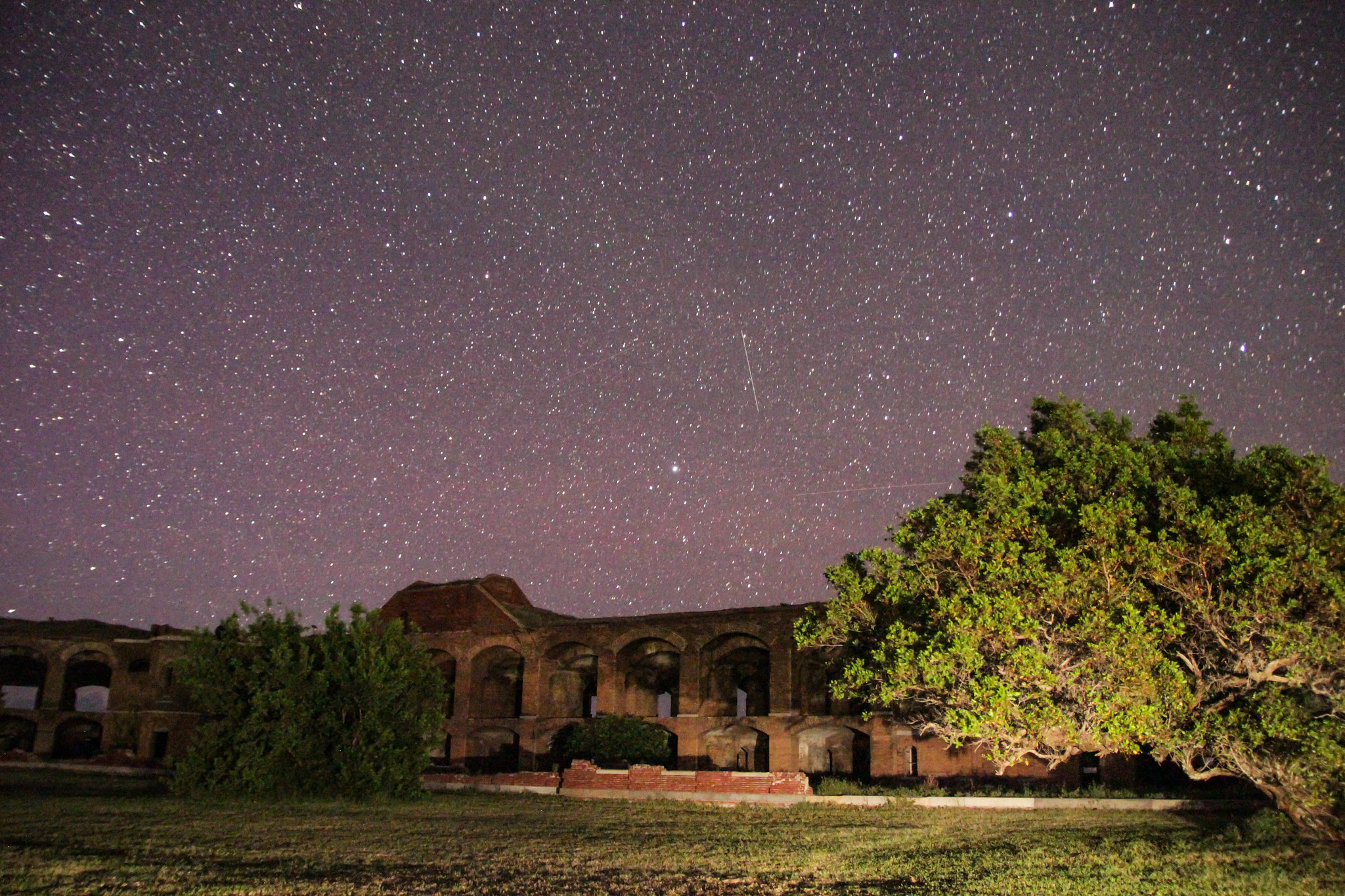
The skies don’t get much darker in Florida than the Dry Tortugas, a remote island 70 miles west of Key West.
Getting out there for an overnight camp could be a challenge, though. The trick is nailing a reservation for the 2 1/2-hour ferry ride aboard the Yankee Freedom , which stays booked well in advance.
Your best bet is to check the ferry’s availability calendar frequently for cancellations. We found occasional one-night openings, but none lined up with the new moon calendar.
That’s not to say the skies don’t sparkle outside the new moon.
The fare for the ferry is $220 round trip ($240 if you bring a kayak) and includes park admission but not the $15 nightly camping fee, which you pay in cash when you arrive. You must bring everything with you, including water, and you have to carry out everything you bring.
For details, visit Dry Tortugas National Park web site .
Read more about Camping at the Dry Tortugas National Park
Stargazing like a Pro (Video)
Helpful Hints: Red Light Camping
In order to see faint stars, our eyes needs to adapt to darkness, and white light interferes with your night sight. Red lighting preserves night vision and complements night-sky photography.
Amateur astronomers use red lighting at their campsites and on astronomy pads to mitigate light pollution, leaving enough light to see without disrupting the experience.
Wildlife observation is another benefit of red lighting because it doesn’t alarm animals.
As a courtesy to others and to enhance your own stargazing experience, especially in the days before and after a new moon, add red lighting to your camping gear.
Dark Sky behavior Don’t roll up to a star party or dark-sky park with your headlights on and radio blaring. Arrive before dusk and quietly to set up your gear. Camp there if you can — with red lighting in your gear box.
Astronomy-friendly gear from Amazon

- Fazekas, Andrew (Author)
- English (Publication Language)
- 288 Pages – 03/19/2019 (Publication Date) – National Geographic (Publisher)

- Amazon Kindle Edition
- Carter, Jamie (Author)

- Multiple Light Modes – White LED, Red LED
- Night vision preserving mode extends run time for emergency preparedness
- Incorporated D rings on top and bottom of lantern to hang it in either inverted or upright positions

- AWESOME DÉCOR LIGHTS: These red rope lights contain 108 SMD 3528 LEDs, 1.8in spaced. The crystal-clear PVC jacket ensures the most…
- WATERPROOF FOR OUTDOOR USE: The thick PVC jacket enables it to withstand extreme external environment (rain, snow, squeezing, collision…
- FLEXIBLE AND CONNECTABLE: The flexible rope lights are easy to bend or twine. They can be end-to-end connected up to 12 strands. The total…
Note: Product links go to Amazon. If you make a purchase by following the above links, Florida Rambler may receive a modest commission, which helps support our mission to bring you quality content about outdoor recreation in Florida.
Related story
For an out-of-this-world experience, you might want to try tent camping on dozens of starlit islands in Florida .
All articles on FloridaRambler.com are original, produced exclusively for our readers and protected by U.S. Copyright law. Any use or re-publication without written permission is against the law.
This page contains affiliate links from which Florida Rambler may earn a sall commission when a purchase is made. This revenue supports our mission to produce quality stories about Florida at no cost to you.
Bob Rountree is a beach bum, angler and camper who has explored Florida for decades. No adventure is complete without a scenic paddle trail or unpaved road to nowhere. Bob co-founded FloridaRambler.com with fellow journalist Bonnie Gross 14 years ago.
This site uses Akismet to reduce spam. Learn how your comment data is processed .

IMAGES
VIDEO
COMMENTS
407 Cool, Hidden, and Unusual Things to Do in Florida. Updated April 25, 2024. Come for the beaches, stay for the live mermaids. The glare of Florida canʼt hide itʼs panoply of wonders, from a ...
By Lauren Tjaden The difference between a tour with American Ghost Adventures and a tour through a typical haunted house is the difference between a witch and witch hazel. A typical haunted house features spider webs, ghouls jumping out at you, and Halloween props in every corner. Screams, evil laughter, and creaking sounds often accompany your steps. A tour with American Ghost Adventures ...
Other alleged haunted sites in Pensacola include Saenger Theatre, The Gray House, Seville Quarter, St. John's Cemetery and Pensacola Lighthouse (considered one of the most haunted lighthouses in the United States). WHERE: 1801 Gulf Breeze Parkway, Gulf Breeze, Florida 32563 | WHO: (850) 934-2600. VIEW ON GOOGLE MAPS.
6) The Plaza Resort and Spa - Daytona Beach, FL. c-bunny/flickr. The Plaza Resort and Spa is considered to be one of the most haunted places in Florida. In 2013, a strange entity was captured on a closed circuit security camera on the premises.
Dark Sky Places in FL. List of darkest places in Florida for stargazing, astrophotography, astrotourism, star parties, and astronomy club events. Often these are national and state parks and forests that are either remote or "protected" against light pollution.
Especially compared to…. THE WORST: Buzz Lightyear's Space Ranger Spin. In terms of Disney & Universal Parks, Buzz Lightyear's Space Ranger Spin practically invented the laser-blasting dark ride genre. The 1998 addition to Magic Kingdom's Tomorrowland was the beginning of the end for the land's short-lived 1994 "original mythology ...
Dark tourism is also called black tourism, morbid tourism, and grief tourism. A few of the most well-known and popular dark tourism sites in the world include the ruins of Pompeii, Auschwitz concentration camp, the site of the Chornobyl nuclear disaster, the Paris Catacombs, Gettysburg, Ground Zero, and the 9/11 memorial in New York.
The appeal of dark tourism however has led at least one researcher to begin capitalizing on it: Philip Stone of the Dark Tourism Institute charges the media a GBP 65 ($100) fee for personal ...
170. The Aokigahara forest in Japan, known as the suicide forest, is a dark tourism destination. Ko Sasaki for The New York Times. By Maria Cramer. Oct. 28, 2022. North Korea. East Timor. Nagorno ...
So, why is dark tourism so popular? According to a 2021 study published by the International Hospitality Review, researchers described the four primary motivations of someone to visit places associated with death and tragedy as: curiosity (a need to see to believe), education, an interest in personally connecting, and the place's sheer existence as a tourist attraction.
Dark tourism refers to visiting places where some of the darkest events of human history have unfolded. That can include genocide, assassination, incarceration, ethnic cleansing, war or disaster ...
Here are the best places for stargazing in Florida. Let us know in the comments if we missed any of your favorites. In this post, I promote traveling to a destination that is the traditional lands of the Ais, Apalachees, Calusa, Guacata, Mascogo, Miccosukee, Mvskoke (Muscogee), Seminole, Tequesta, Timucua, and Tocobaga peoples, among others.
Dark tourism, also known as tourism of desolation, thanatourism or catastrophic tourism, was introduced in the 1990s (Molokáčová and Molokáč 2011; Stone and Sharpley 2008) and remains a diverse and multifaceted phenomenon even today (Kunwar and Karki 2019; Becker 2019).From the developed northern hemisphere, dark tourism comes up as embedded in history and heritage as well as tourism and ...
While visiting places of death or disaster might sound like a gruesome addition to your travel itinerary, so-called dark tourism can have important benefits for you and the communities nearby. Visiting sites of inhumanity can be a deeply moving and emotional experience, but while discovering what took place might make us uneasy, remembering ...
8 Types of Dark Tourism. The umbrella term 'dark tourism' can be broken down into subcategories, each associated with its own brand of gloom: Cold War tourism. Battlefield tourism. Grave tourism. Nuclear tourism. Prison tourism. Holocaust tourism. Narco tourism.
Tsitsernakaberd Genocide Memorial & Museum (Yerevan) October 20, 2020. For dark tourists in Yerevan, a trip to Tsitsernakaberd is a must. The Memorial and Armenian Genocide Museum provide a powerful insight into the country and its culture and of the darkest period in the nations' relatively recent history. The ….
Dark tourism can be defined as "visiting sites, attractions or events. . . linked in one way or another with death, suffering, violence or disaster" (Sharpley and Stone 2009, 4).Dark tourism is conceived as a spectrum of experiences moving from the darkest pole centering on a set of profound experiences that are tied to death and mortality to the lighter shade of the spectrum dealing with ...
Pompeii, Italy. Pompeii, Italy, stands as a captivating dark tourist site, frozen in time by the catastrophic eruption of Mount Vesuvius in 79 AD. The ancient city was buried under layers of ash and pumice, preserving its streets, buildings, and inhabitants in an eerie tableau. The plaster casts of citizens, captured in their final moments of ...
Dark tourism is considered a subset of heritage tourism, because many dark tourism sites are also heritage sites. For example, Leap Castle in Ireland is a heritage site with history dating back to ...
17 Must-Visit Dark Tourism Destinations. 1. Chernobyl Exclusion Zone - Kyiv, Ukraine. The abandoned amusement park in Pripyat is one of dark tourism's crowning images. The haunting stills of the fairground that never heard the laughs of children hang in modern consciousness, a symbol of tragic loss and a warning of the mistakes men can make.
Dark tourism sites often provoke an emotional response from visitors. A deep emotional engagement with a place's history is often a requirement for engaging visitors. This article closes with a discussion of how new heritage can avoid depoliticizing complex histories of disenfranchisement while eliciting poignant and critical reflection from ...
In its heyday in the 1940s and 1950s, the beach attracted Black vacationers from across the South and luminaries like Hank Aaron, Cab Calloway, Ray Charles, Ossie Davis, Duke Ellington and Joe Louis. Ultimately, integration prompted the demise of American Beach as Black vacationers were welcomed elsewhere.
Kissimmee Prairie Preserve was recognized as Florida's first "Dark Sky Place" by International Dark Sky Association in 2016. Kissimmee Prairie Preserve State Park, 33104 N.W. 192nd Ave., Okeechobee FL 34972. Phone: 863-462-5360. ... Or you can just chalk all that talk up to Florida Tourism. Any way you cut it, Torreya State Park is a ...
Extend your explorations past bedtime at a haunted castle in Ireland, in a Costa Rican jungle, on the desert trails of Arizona and more.